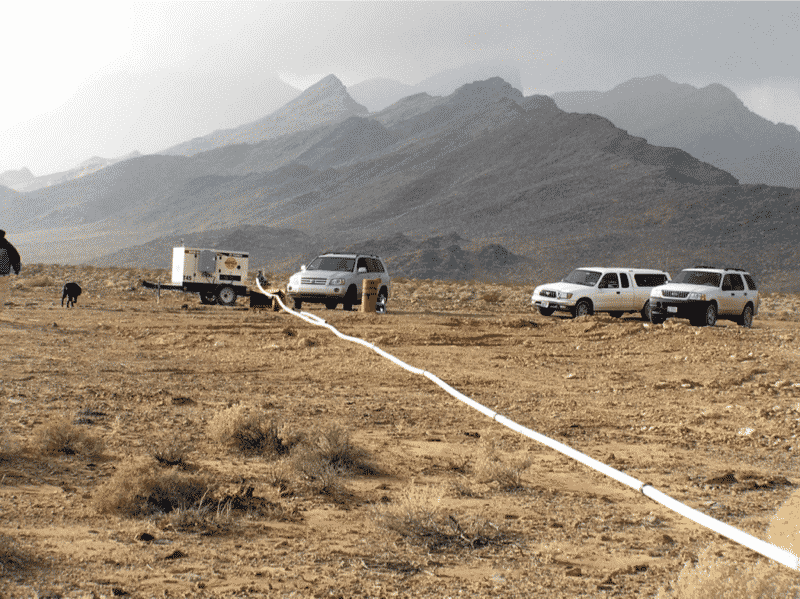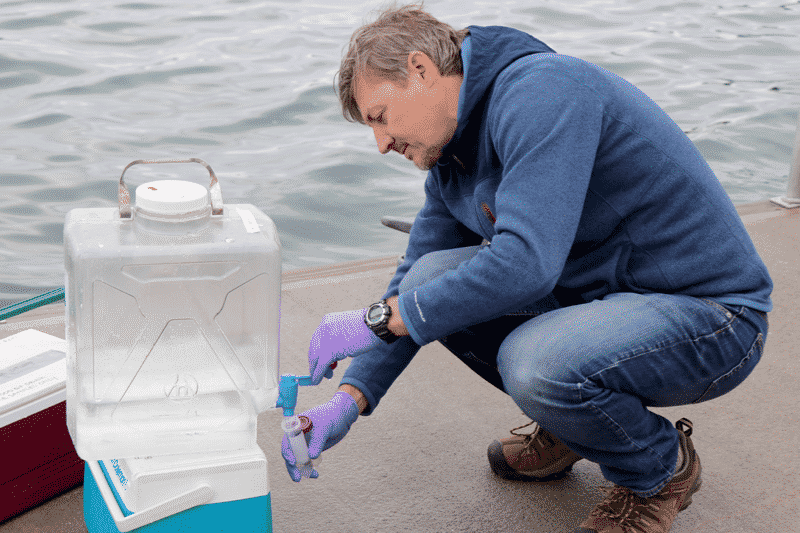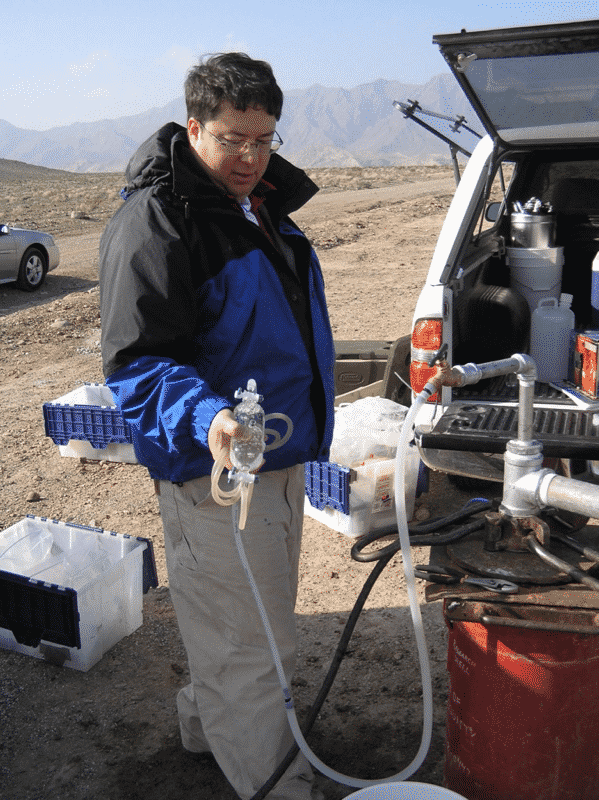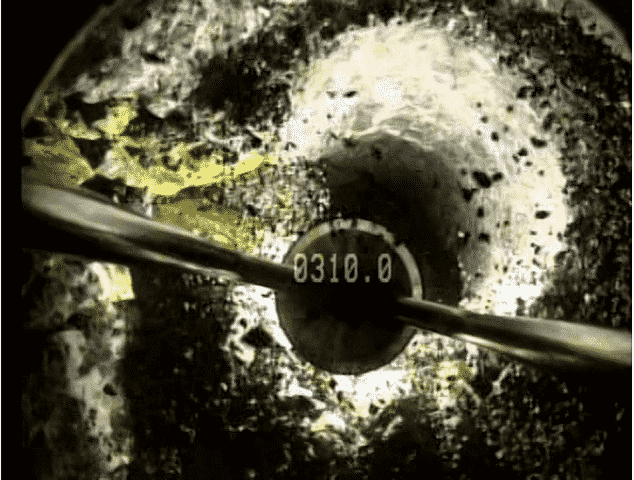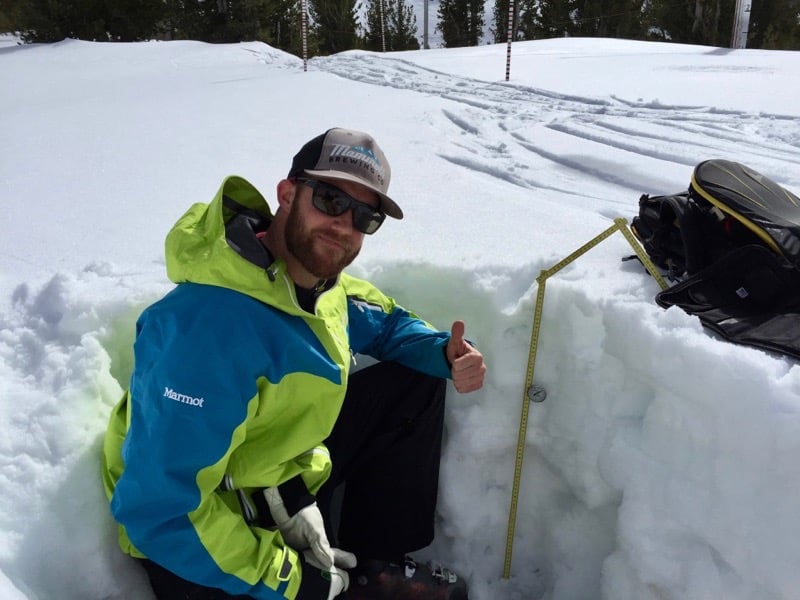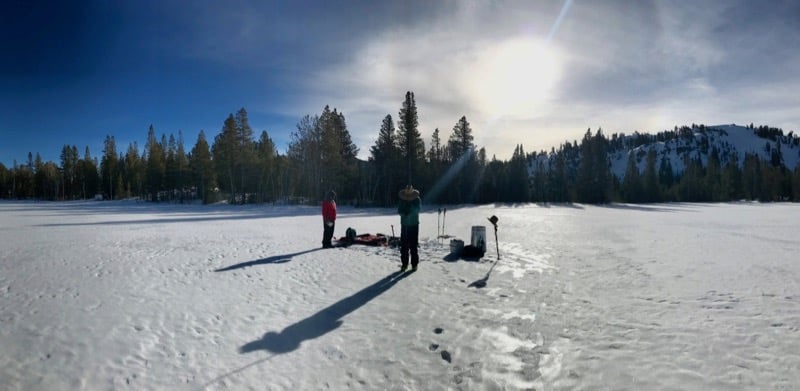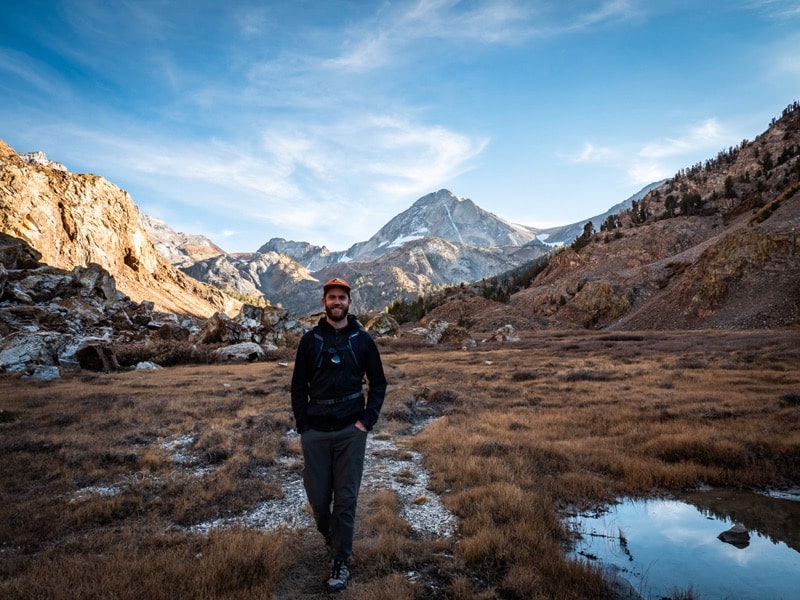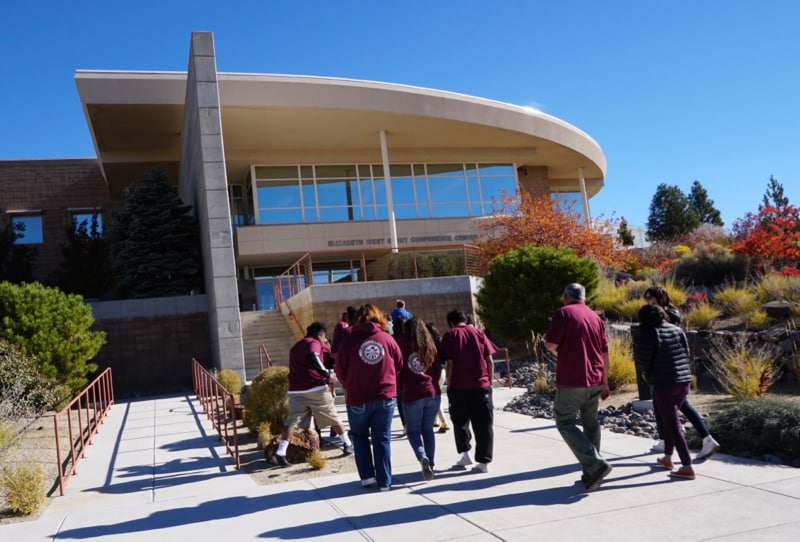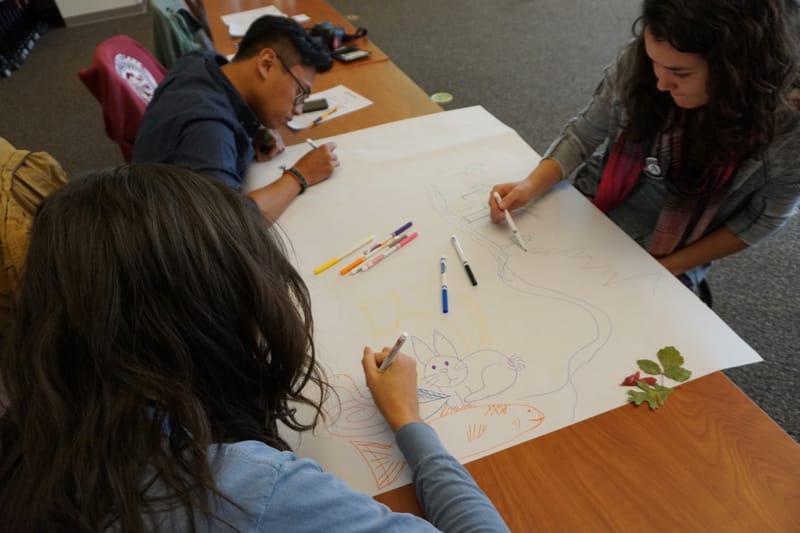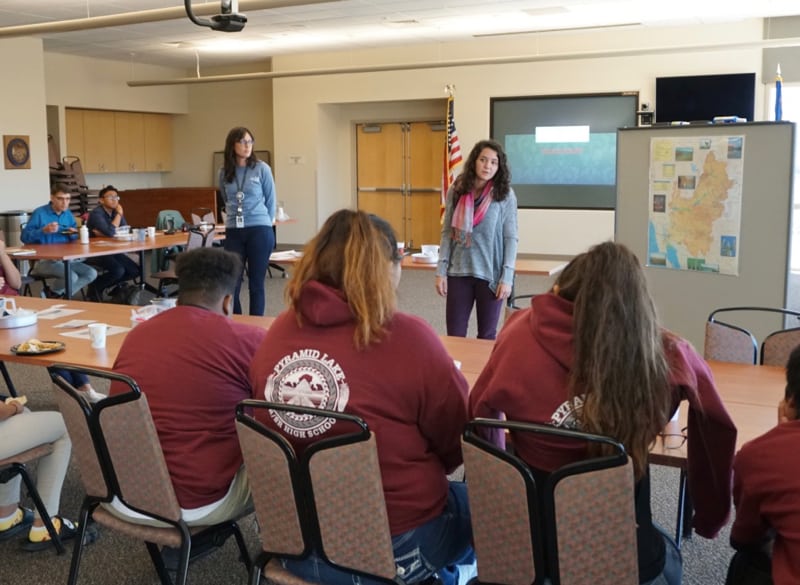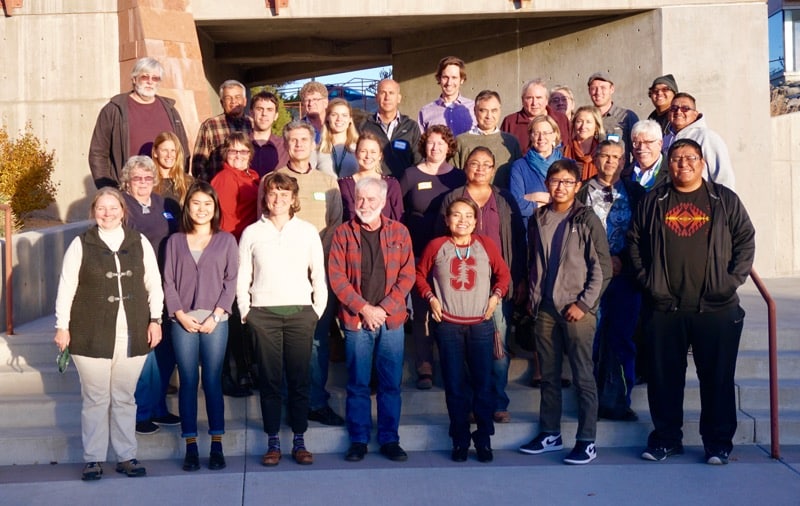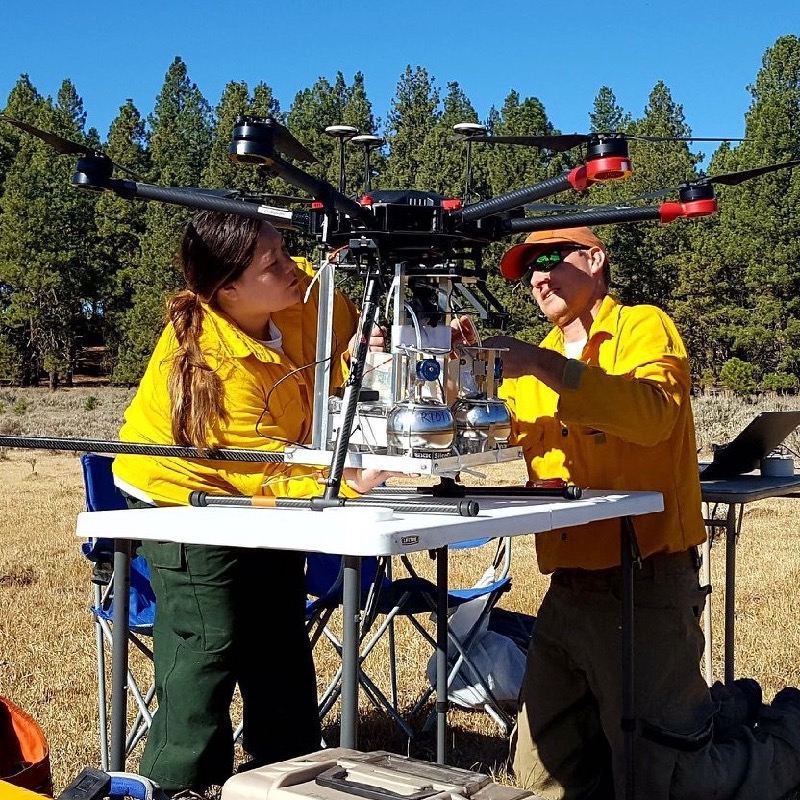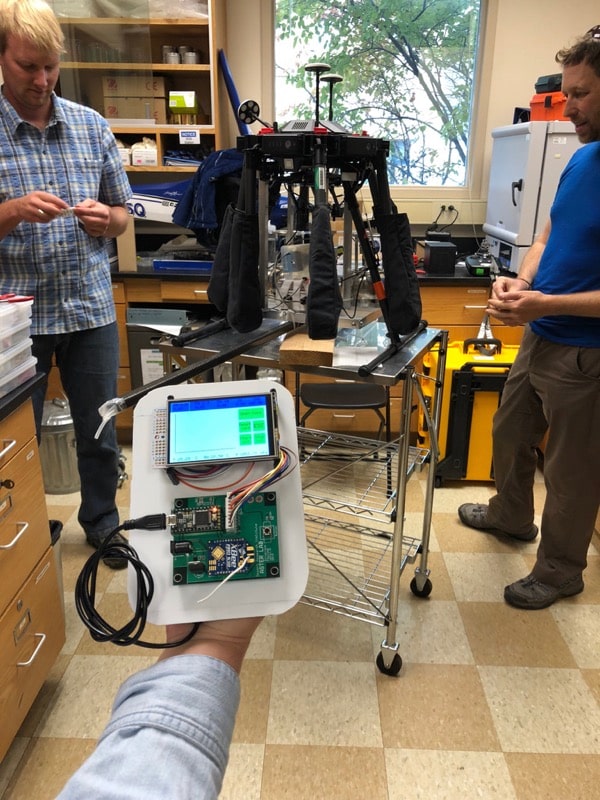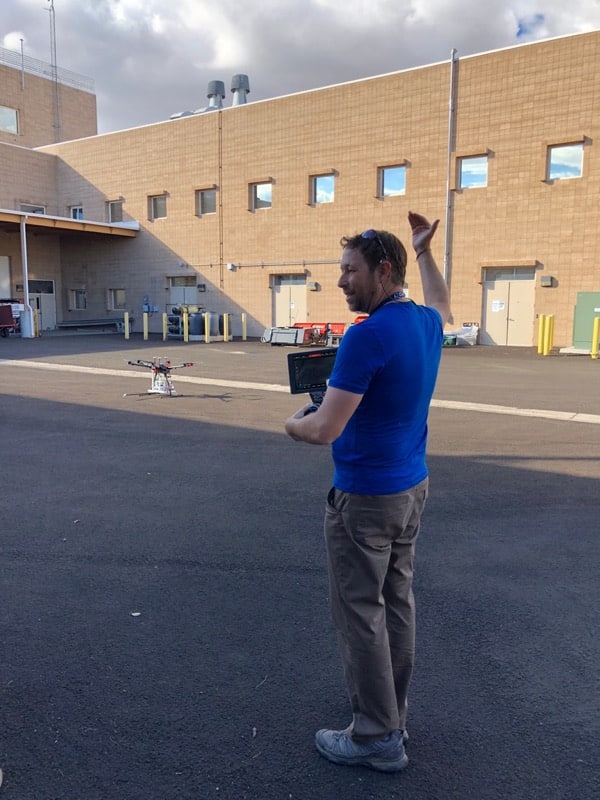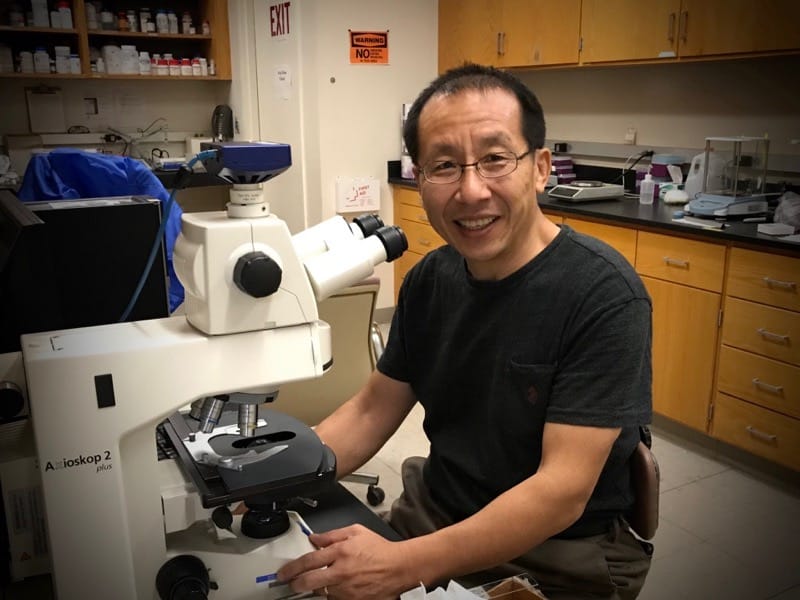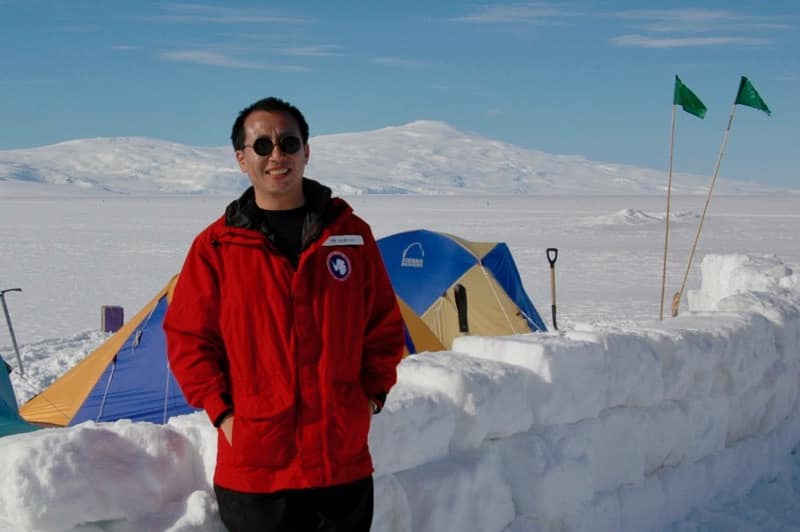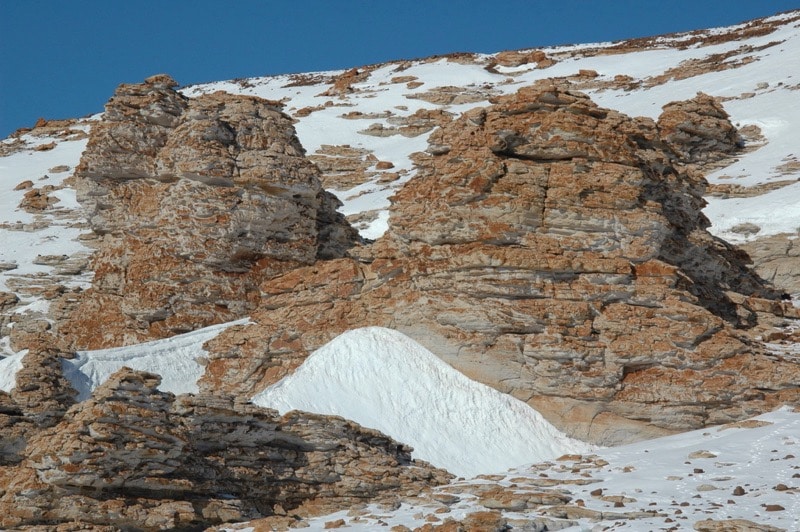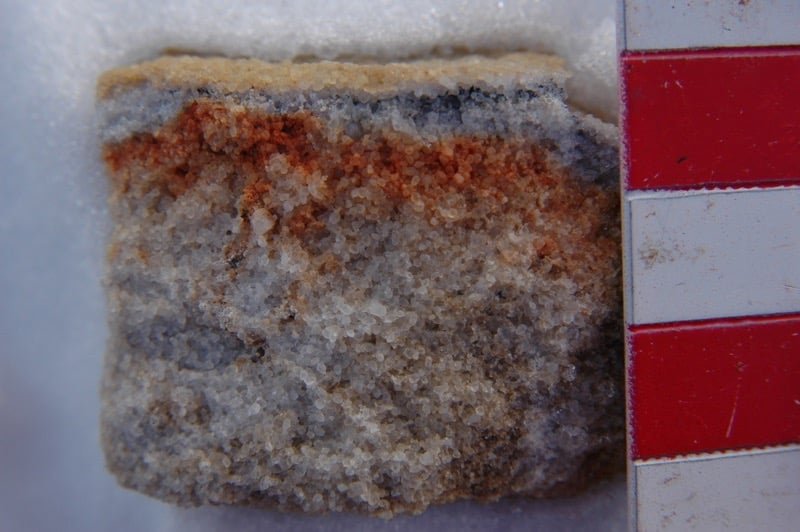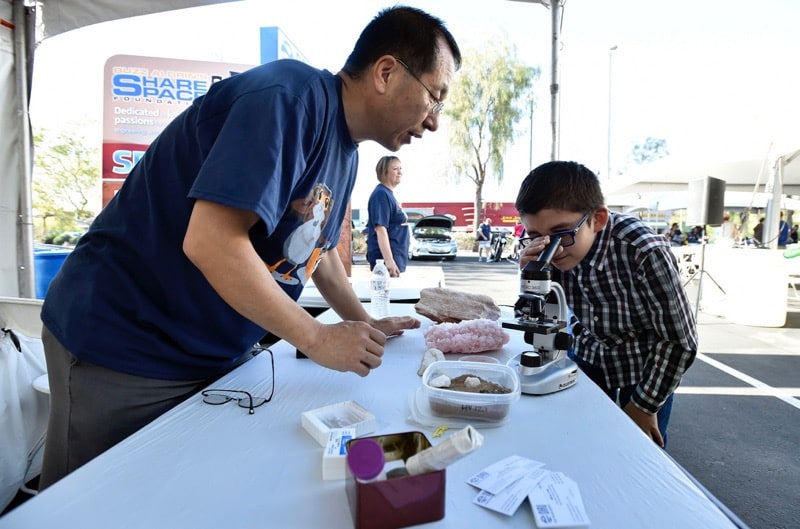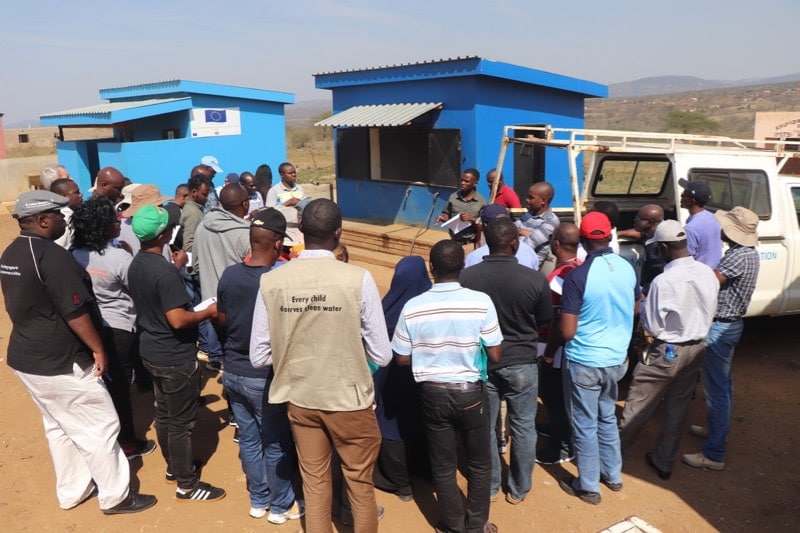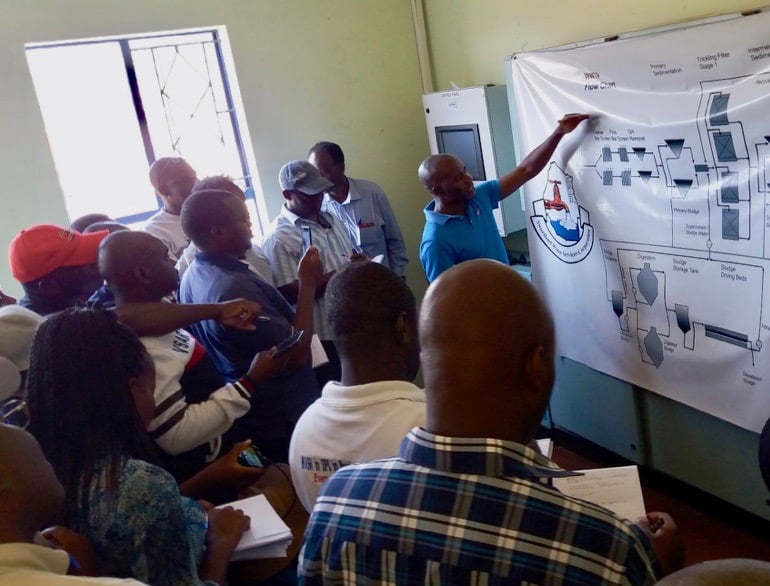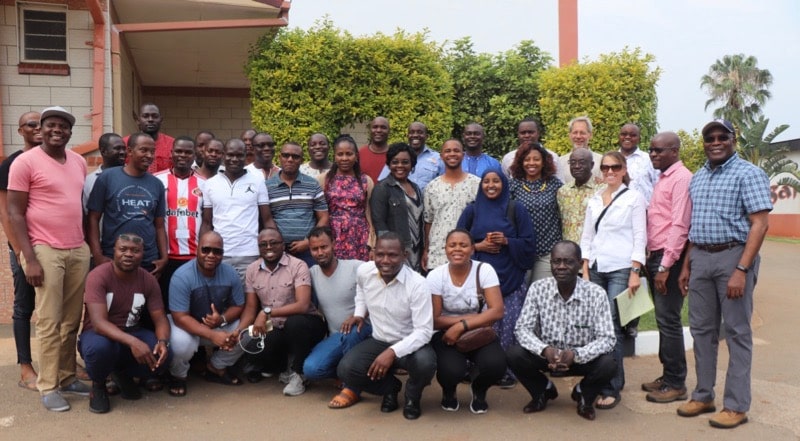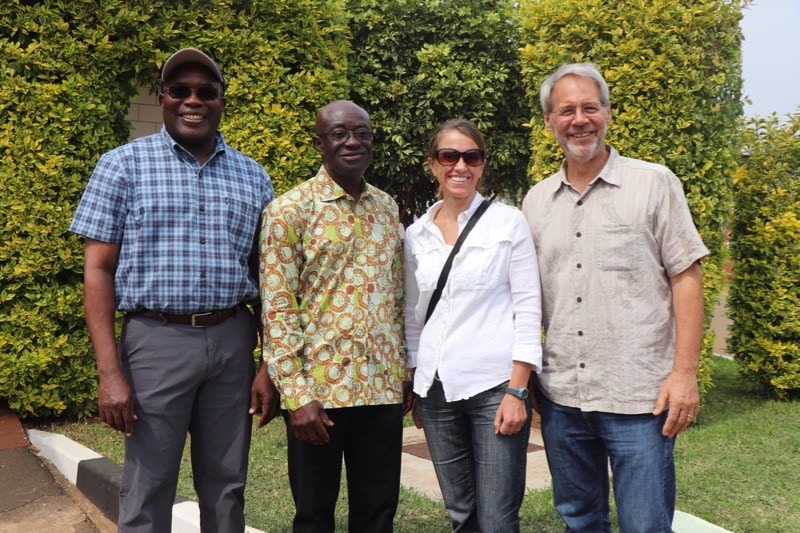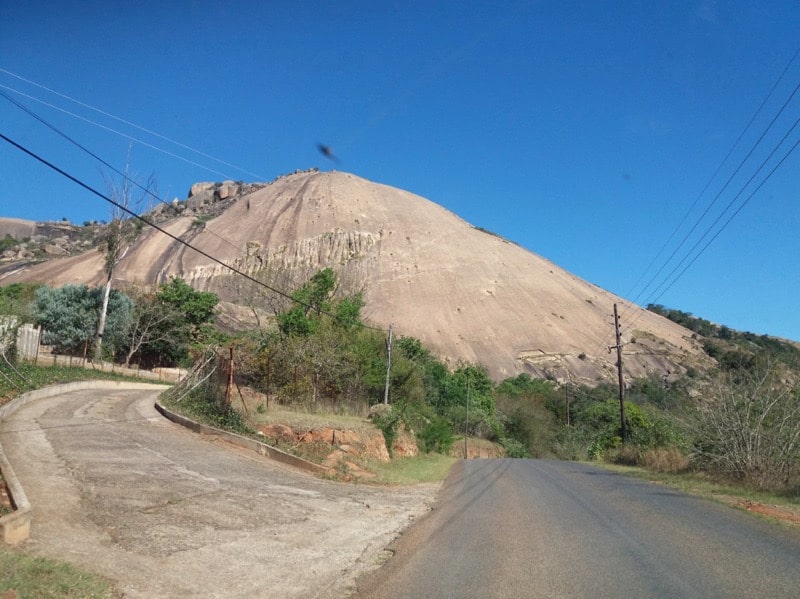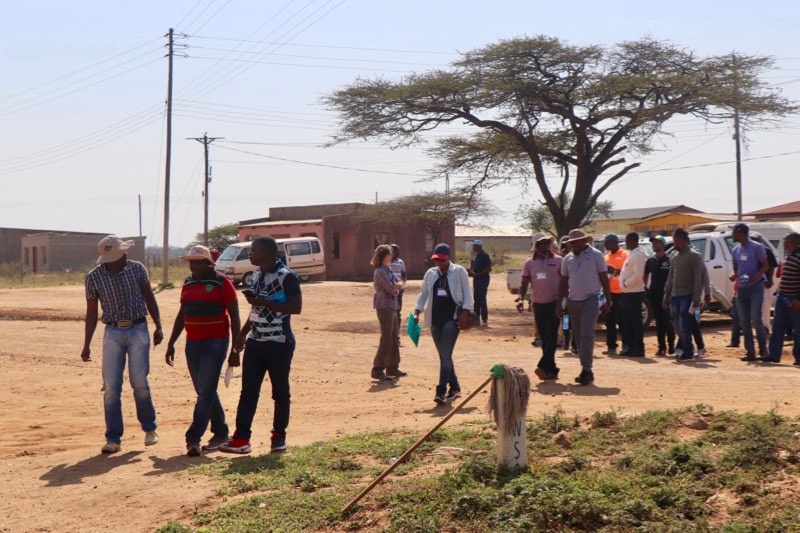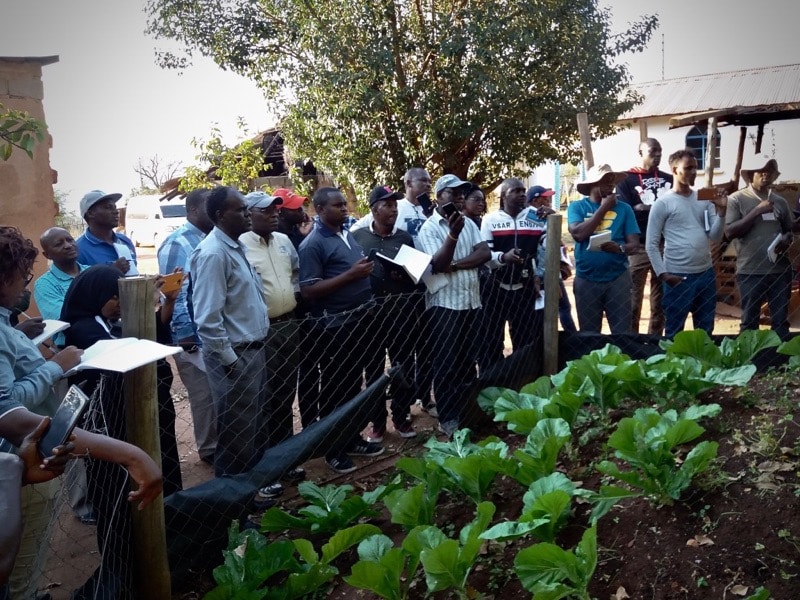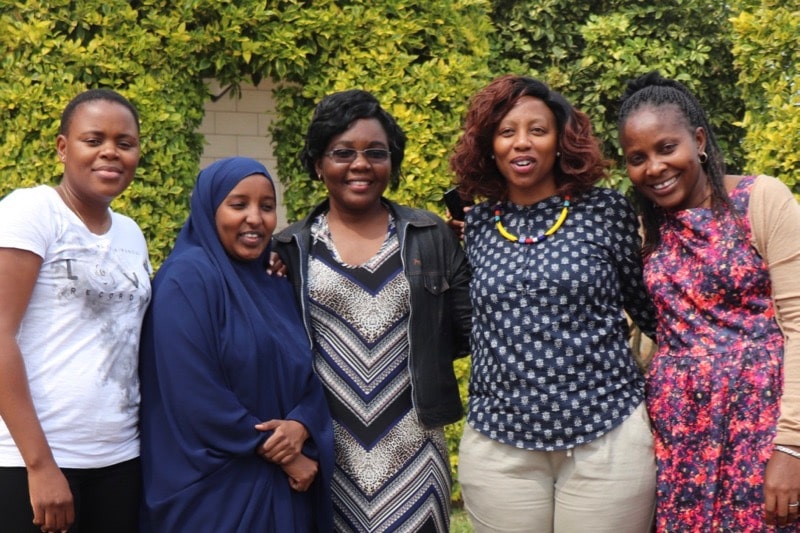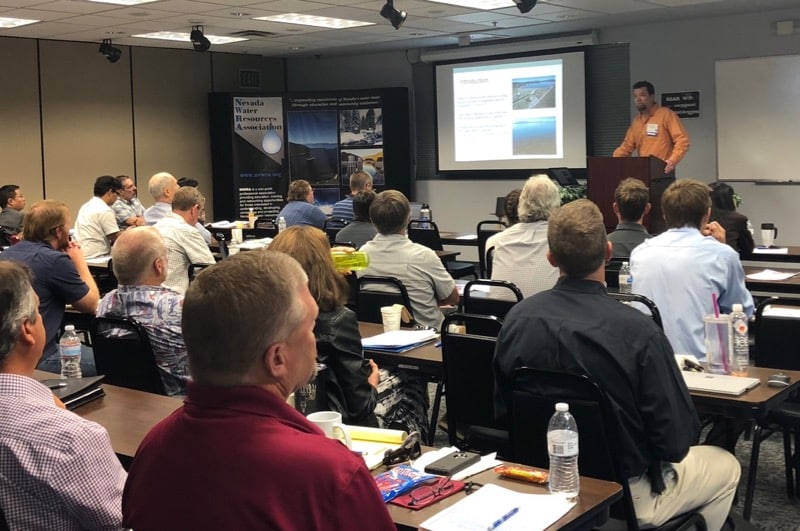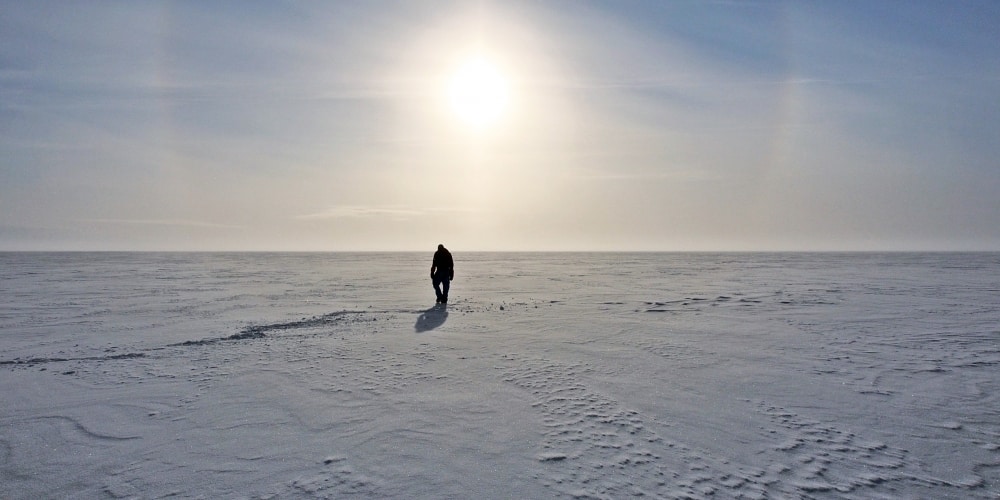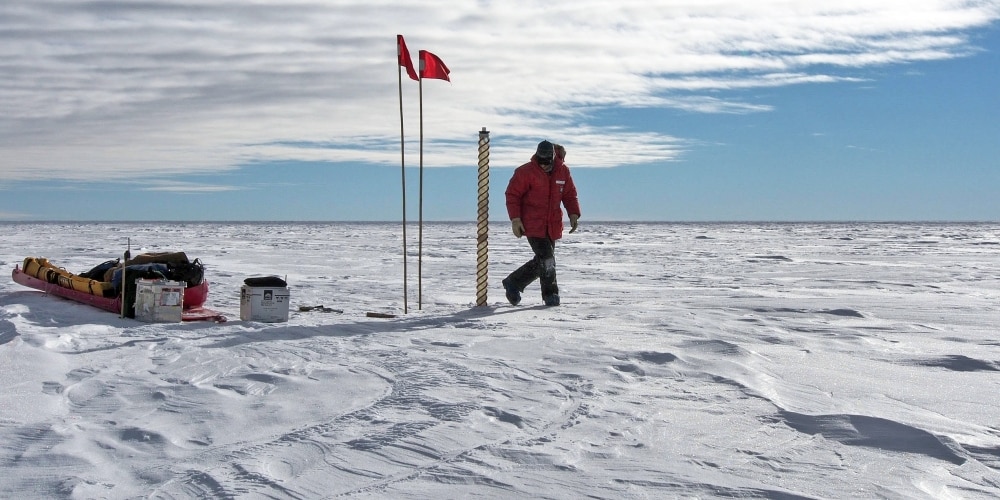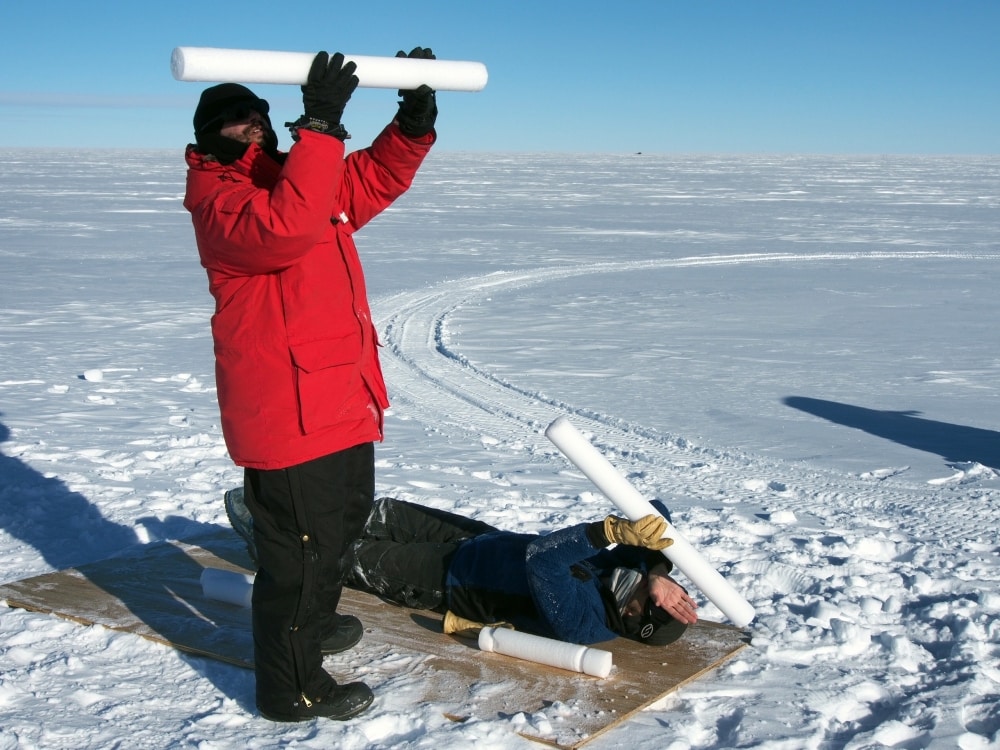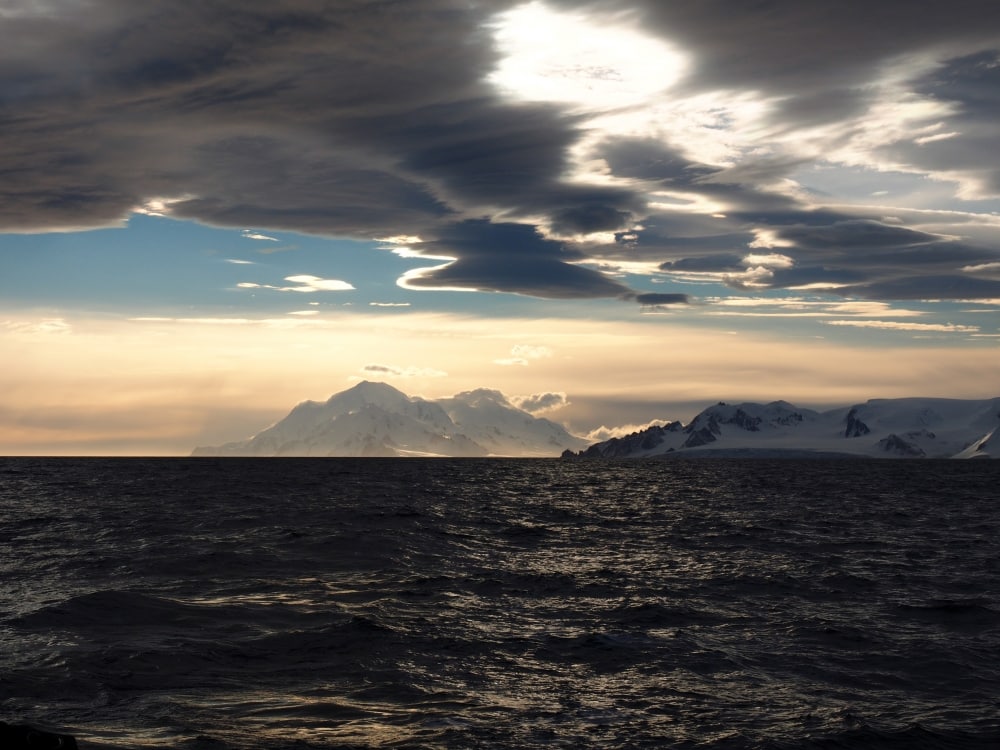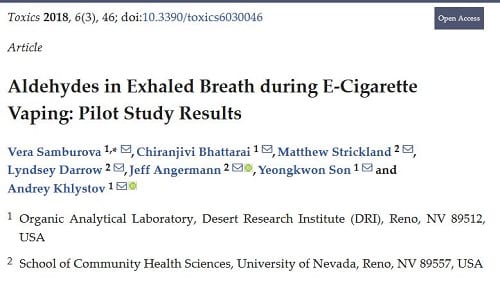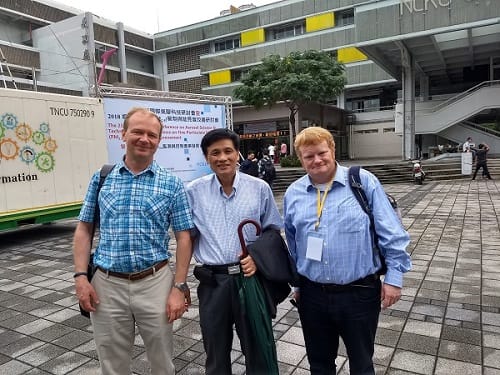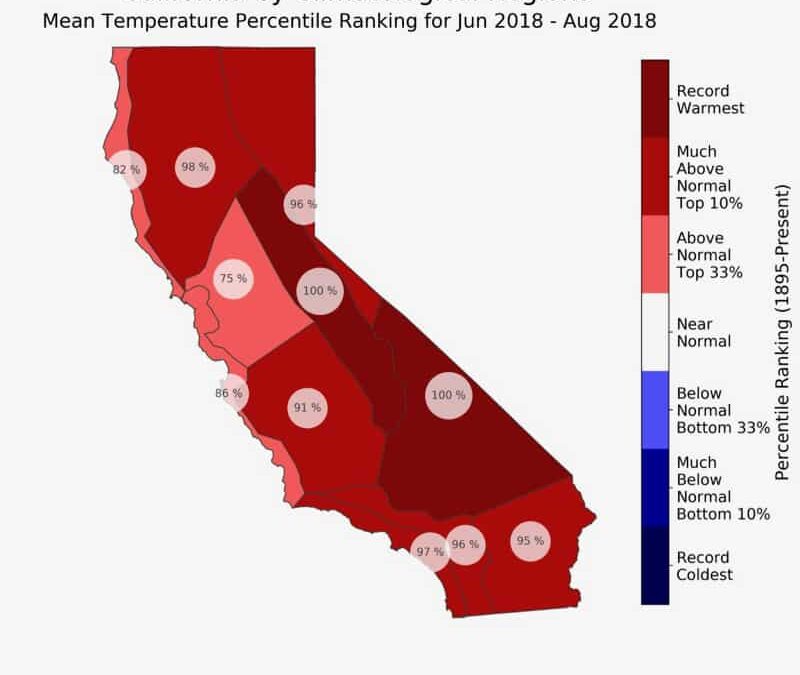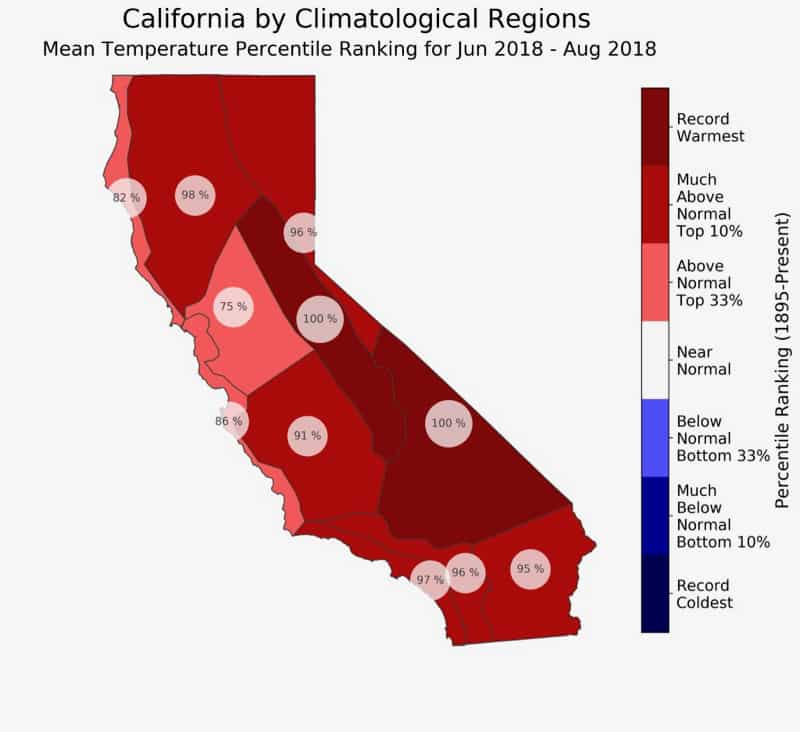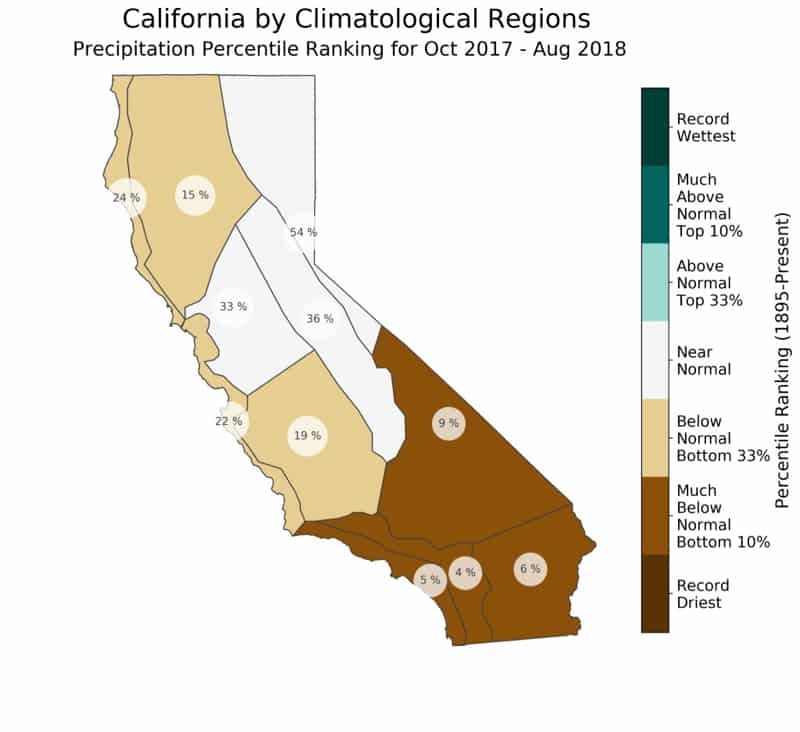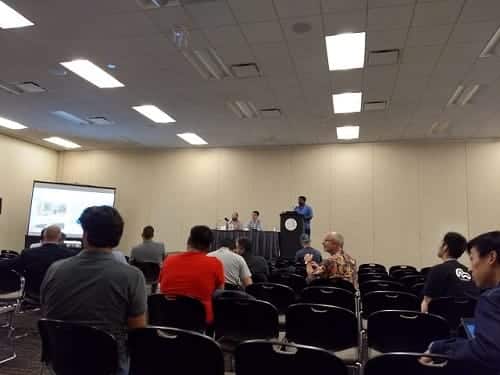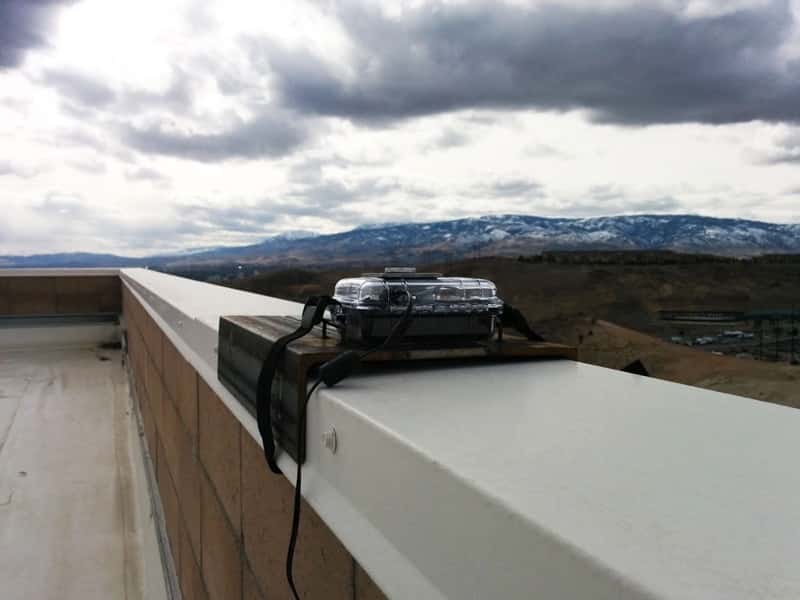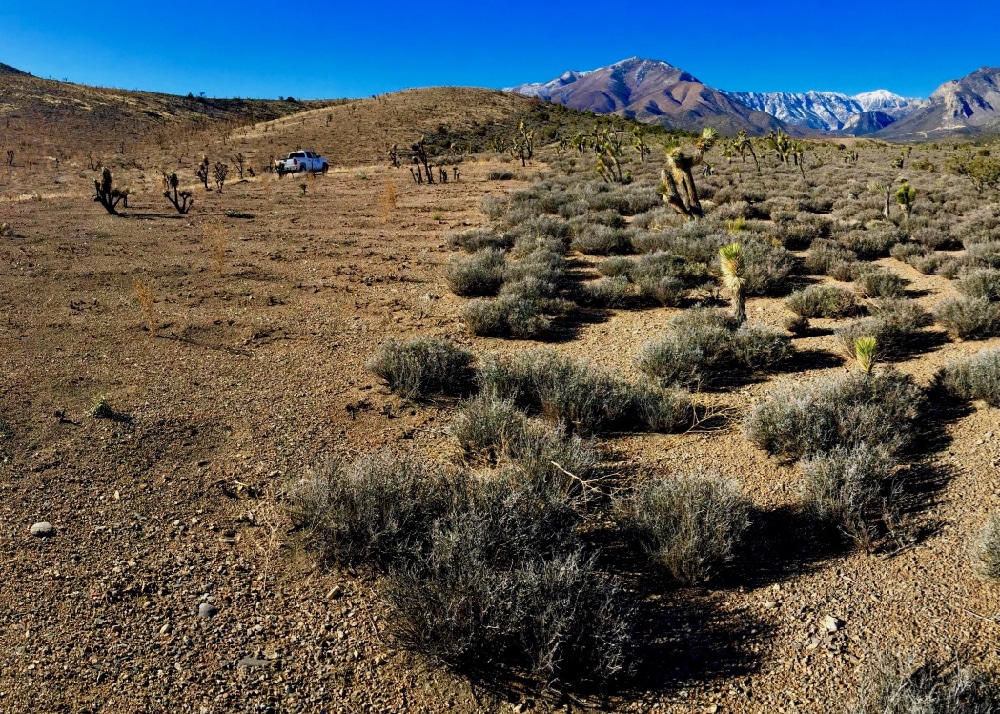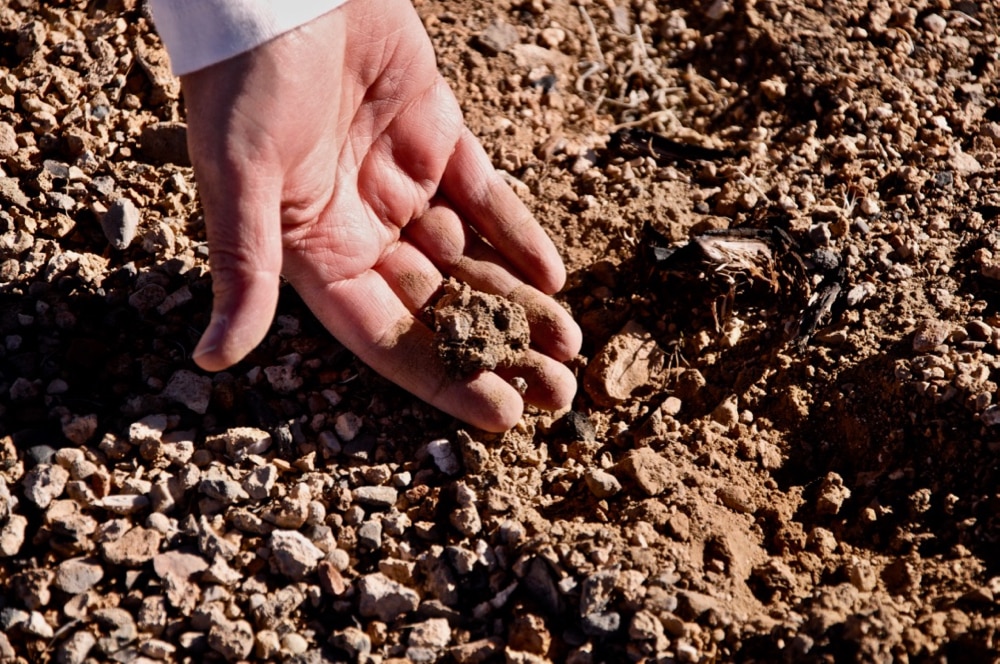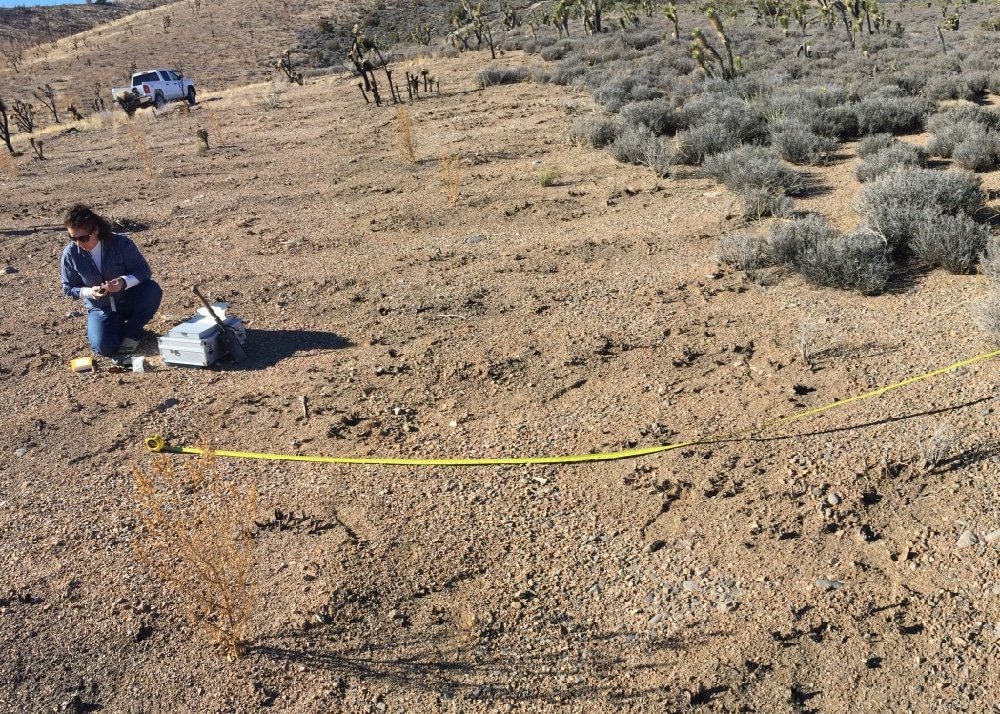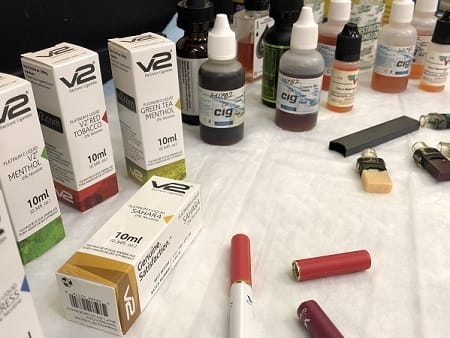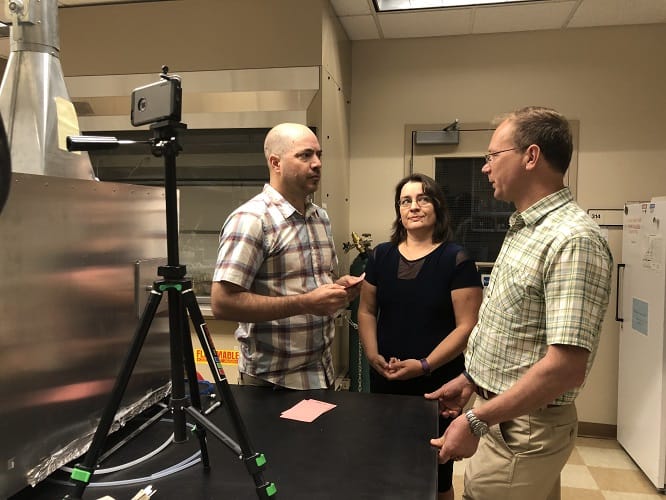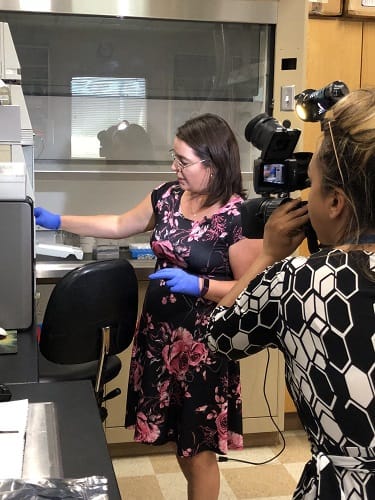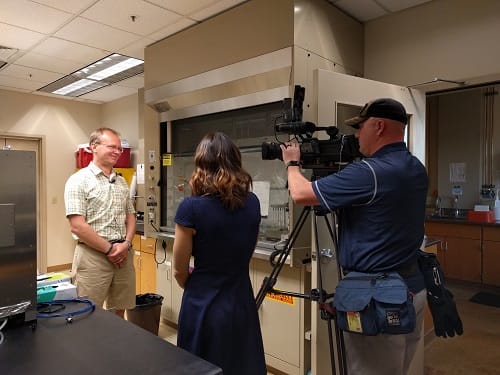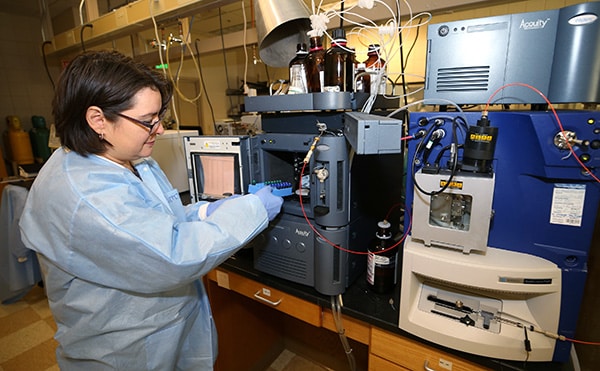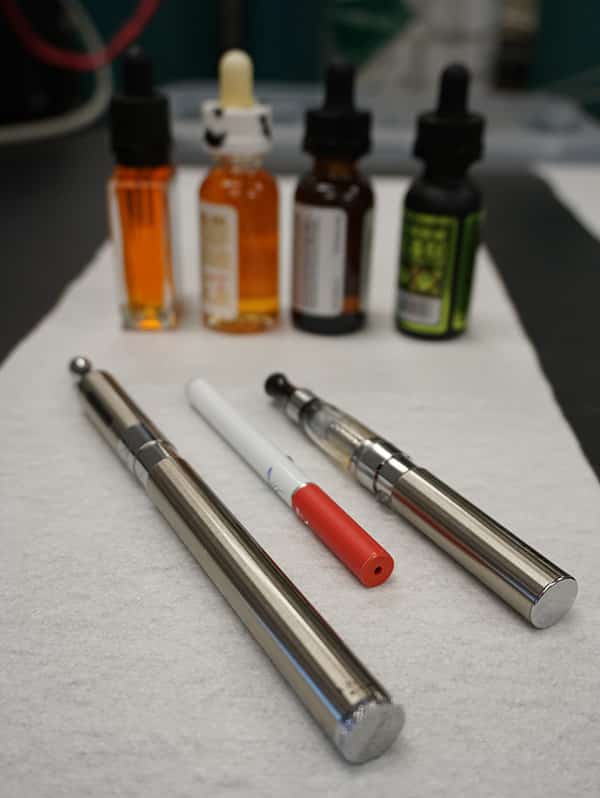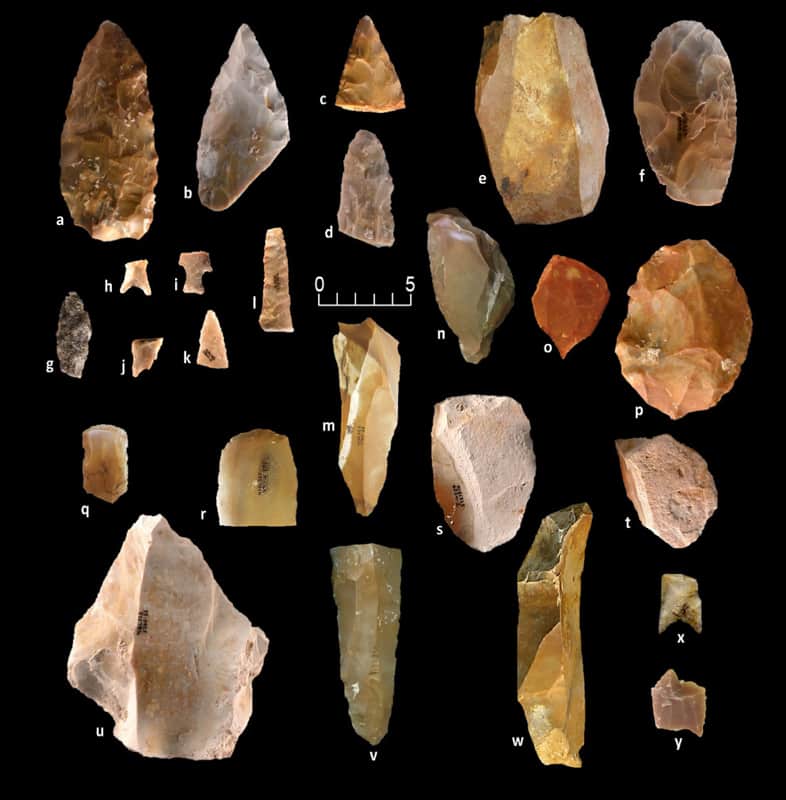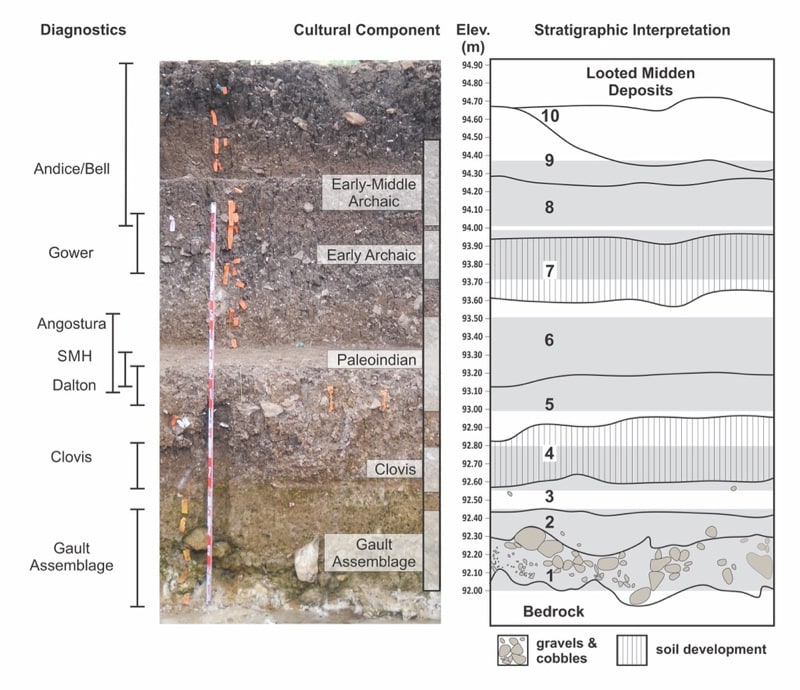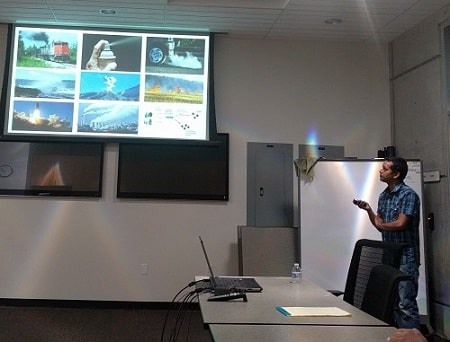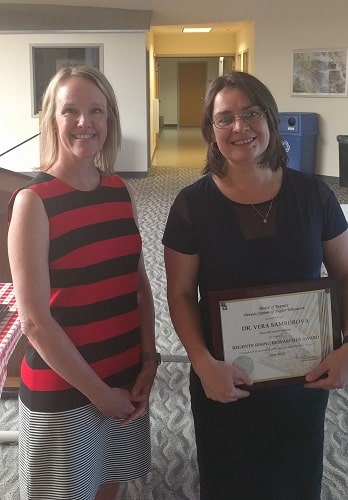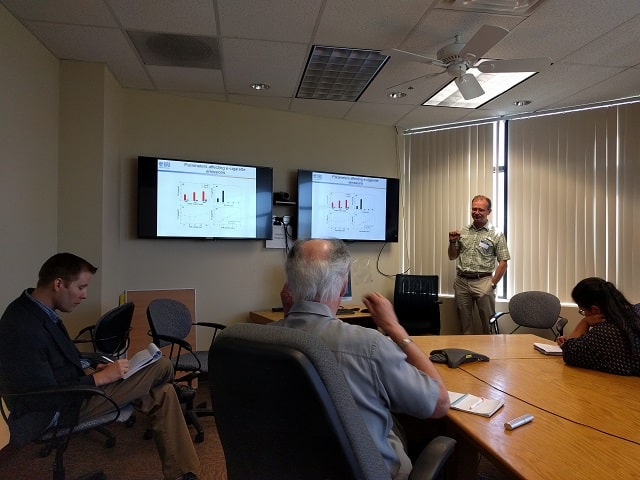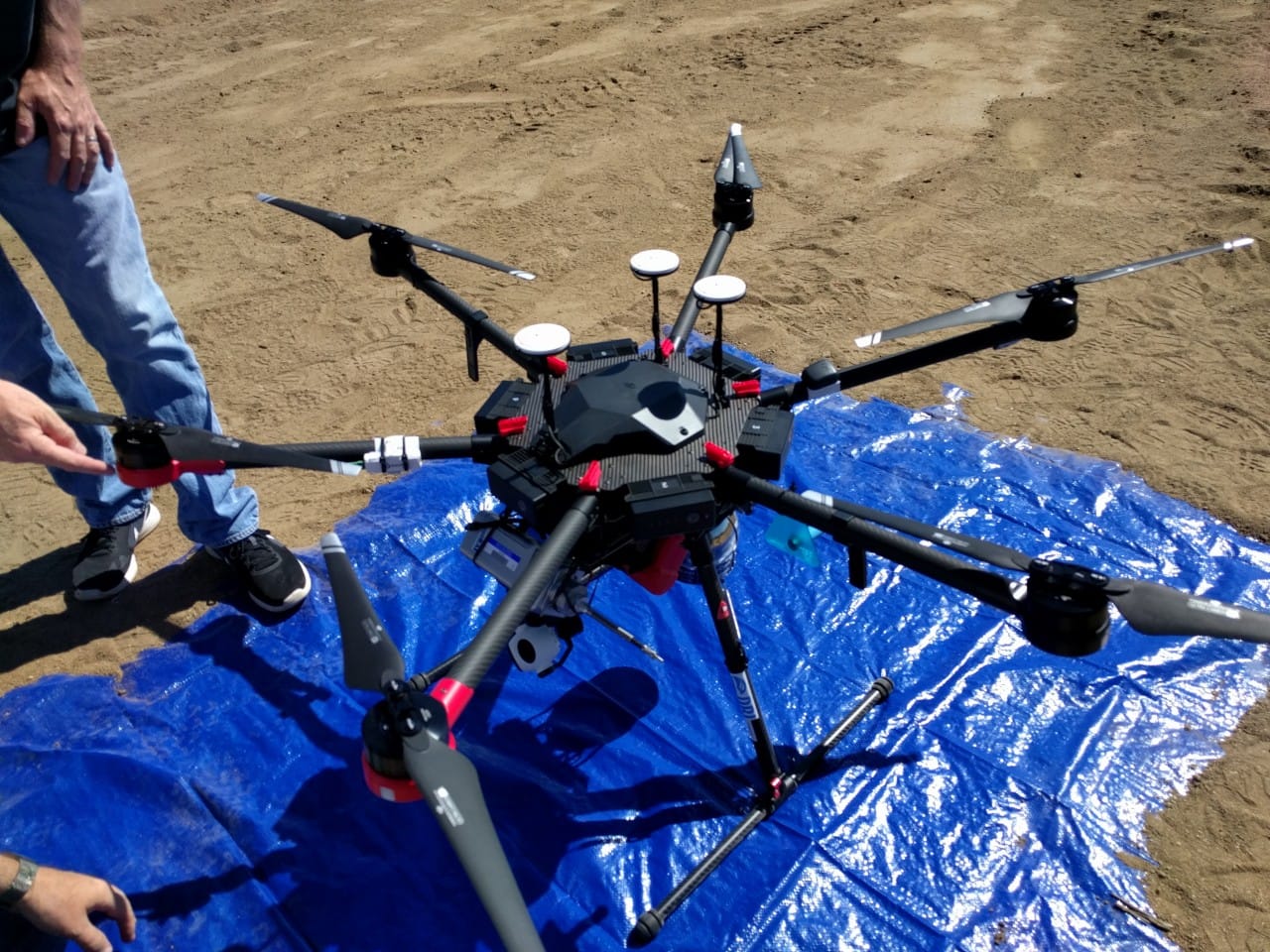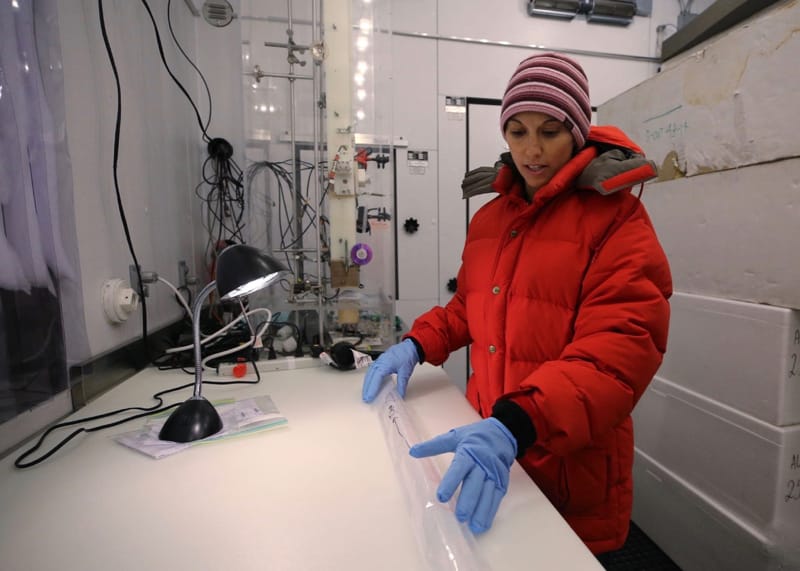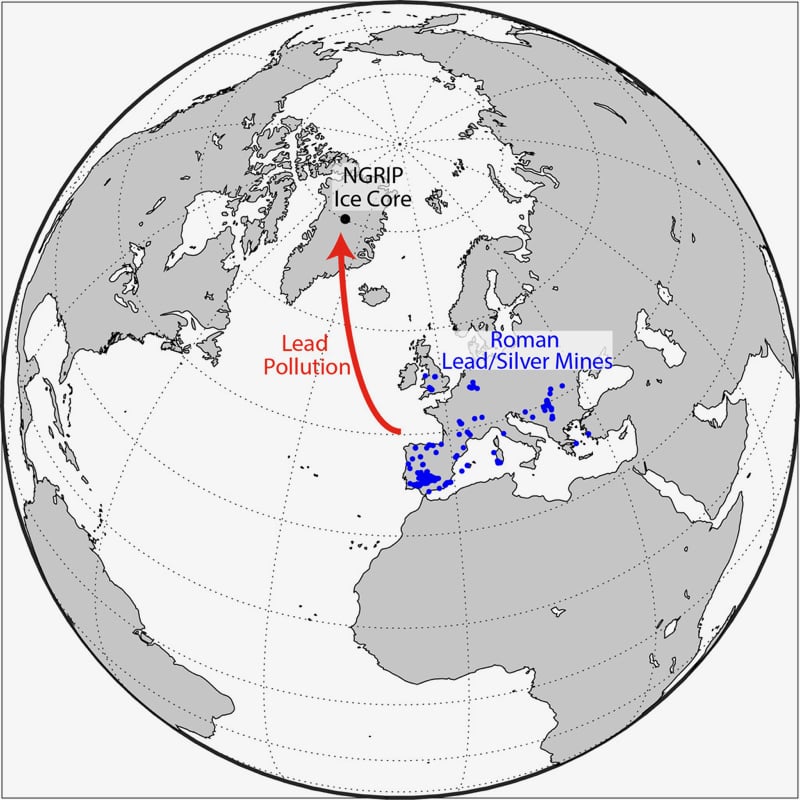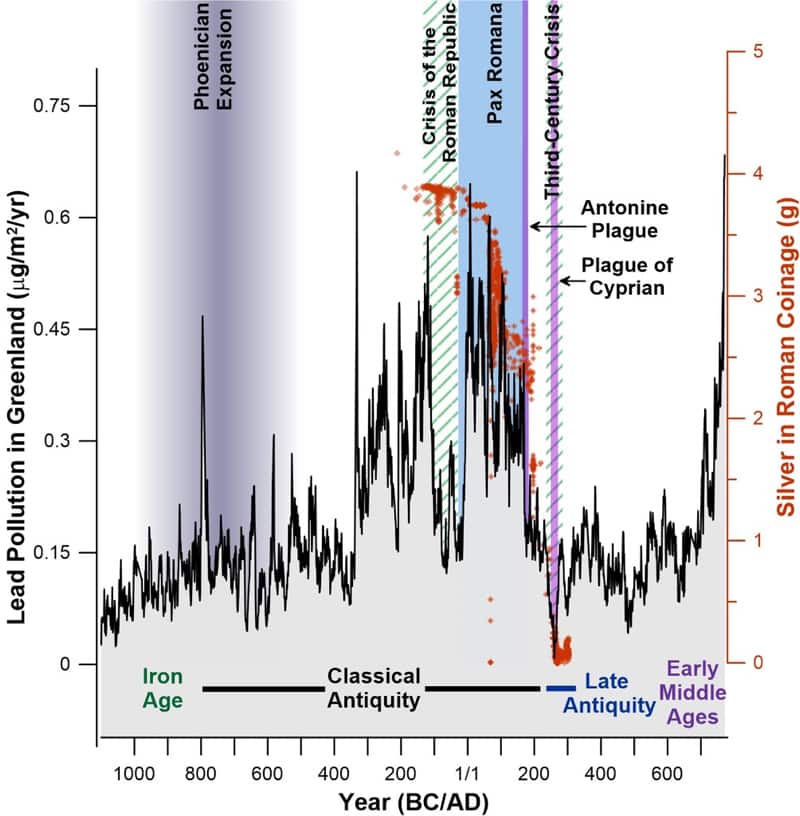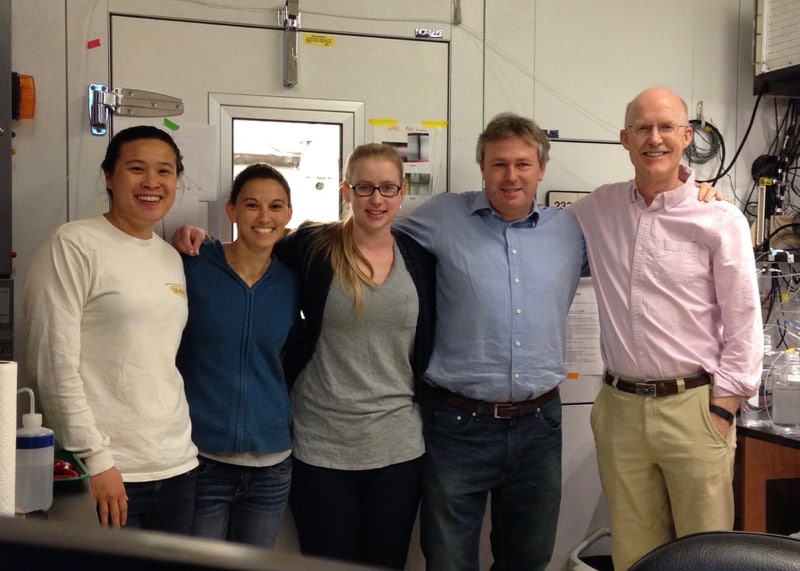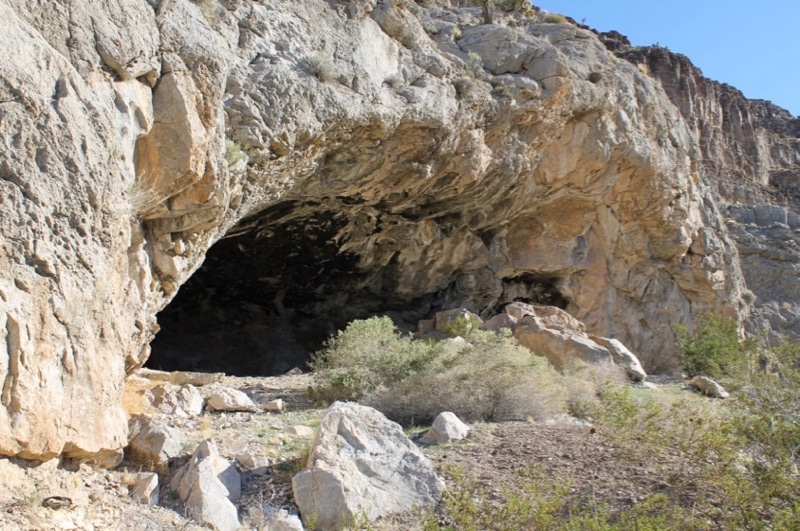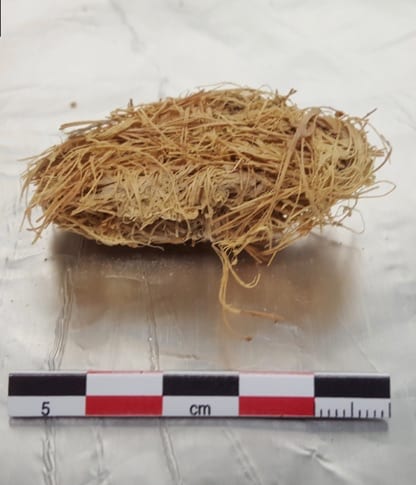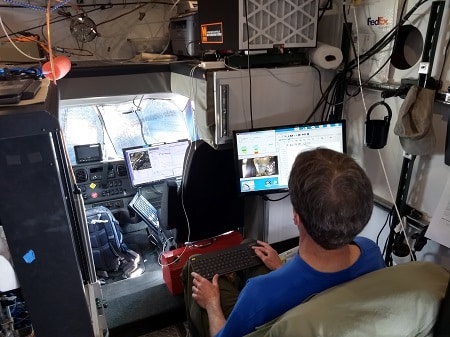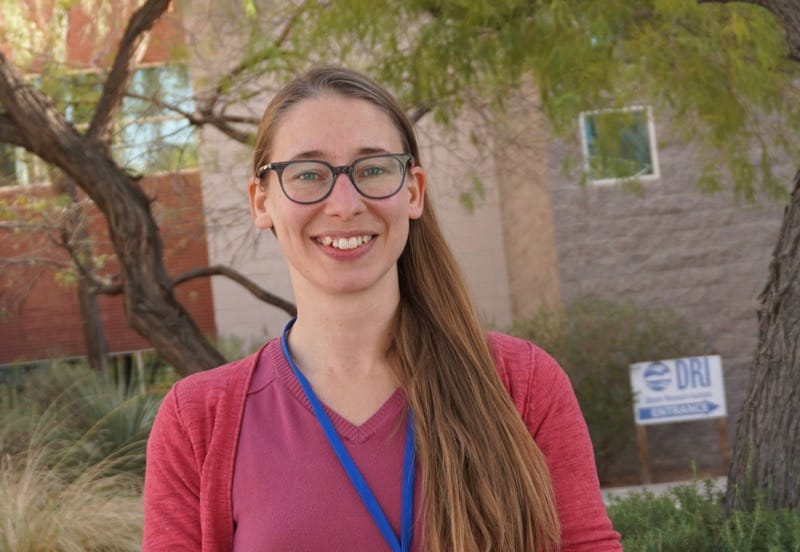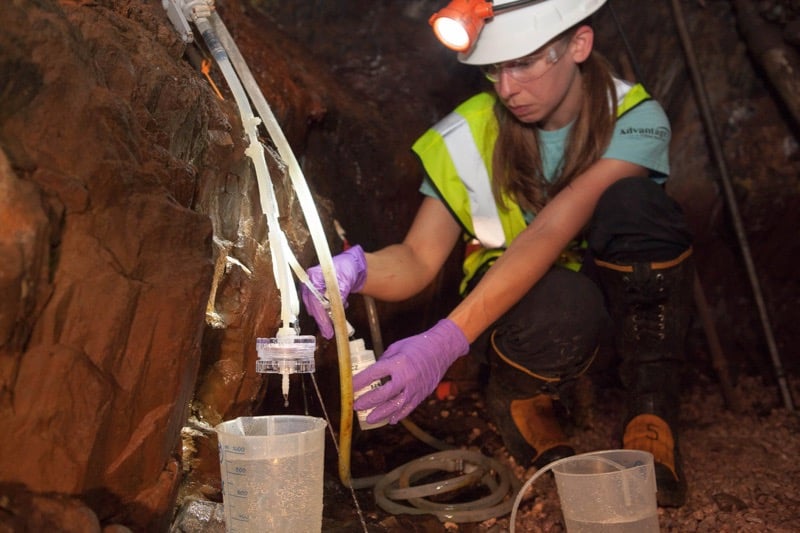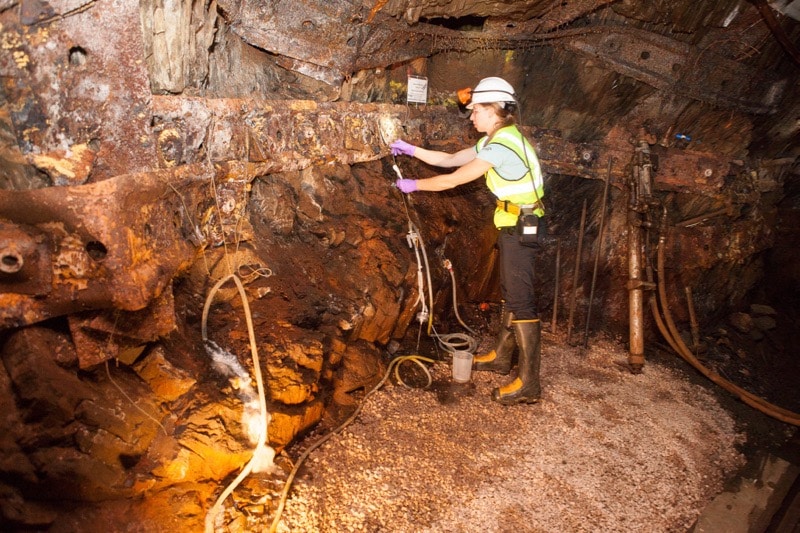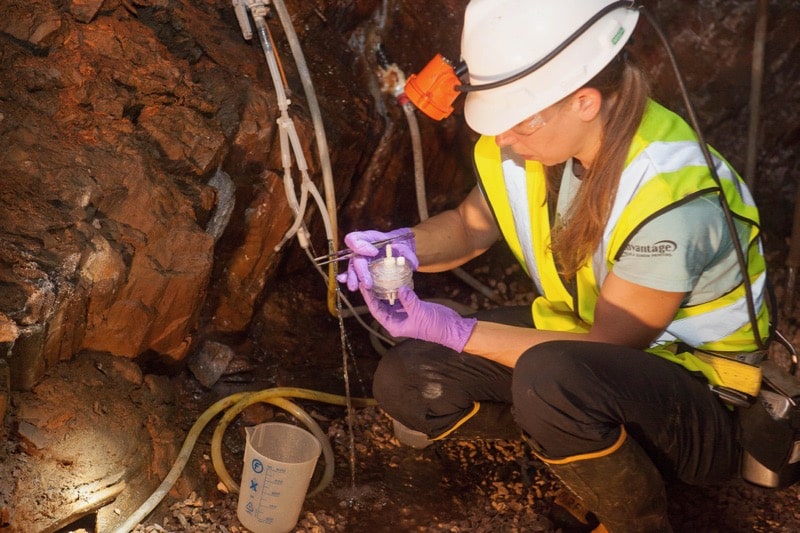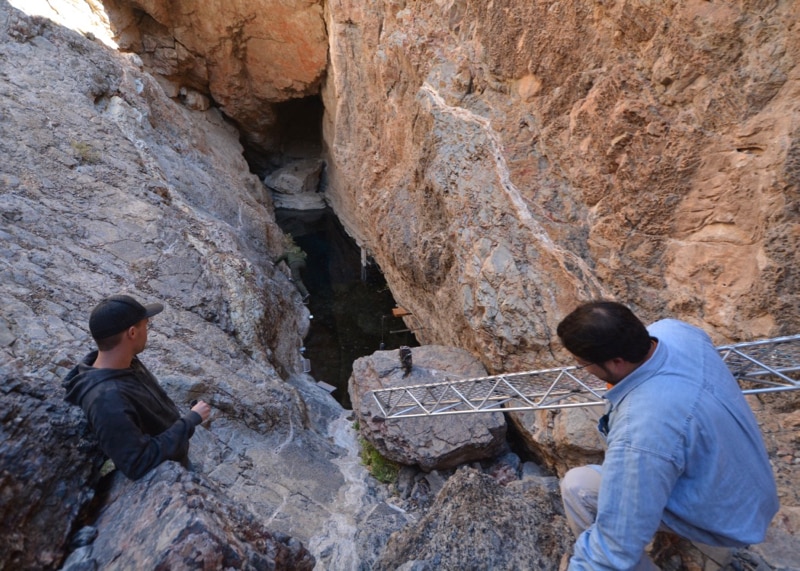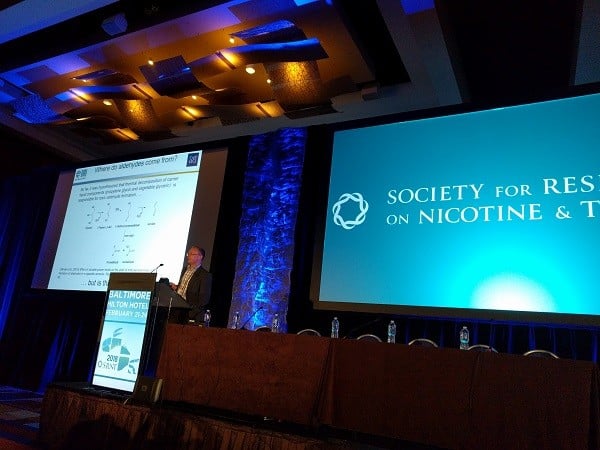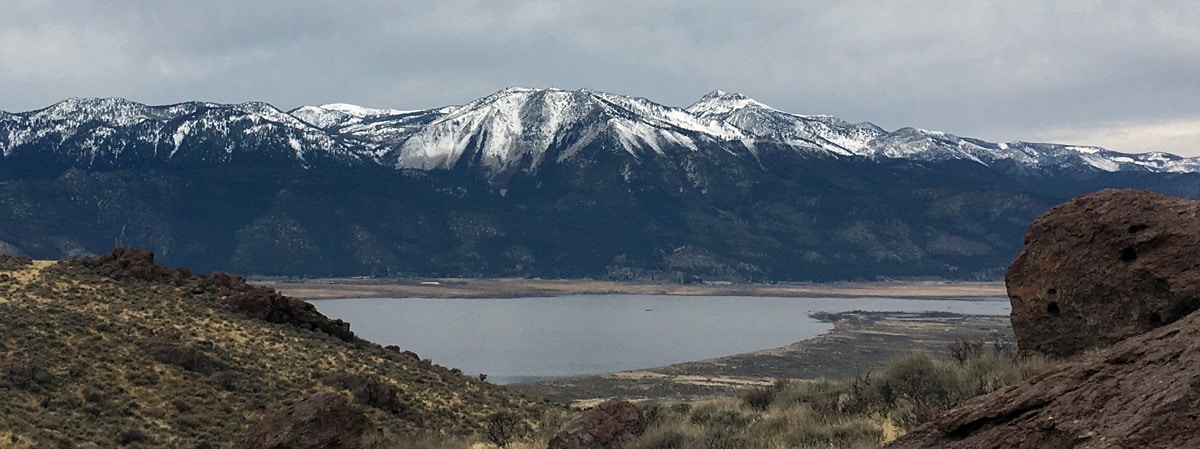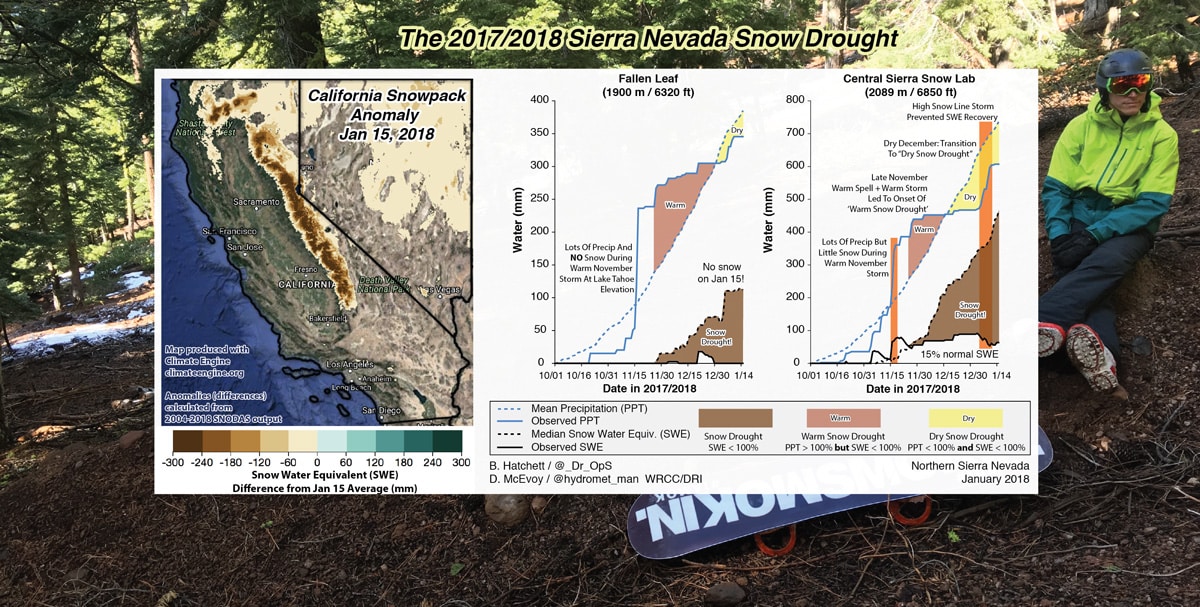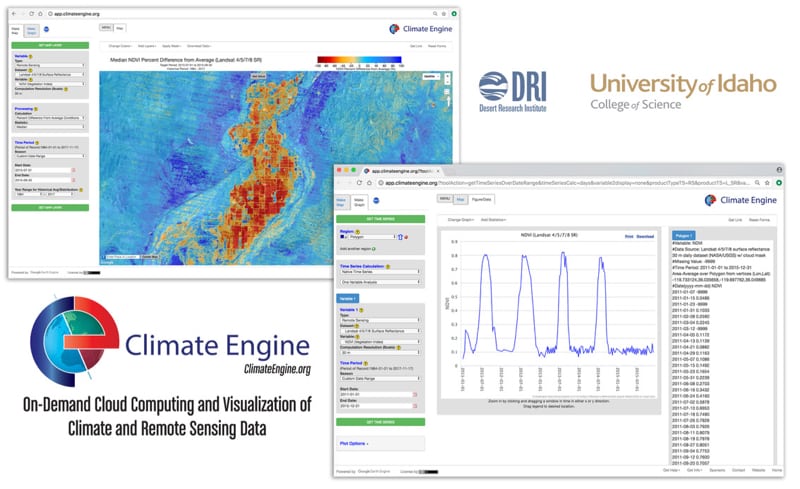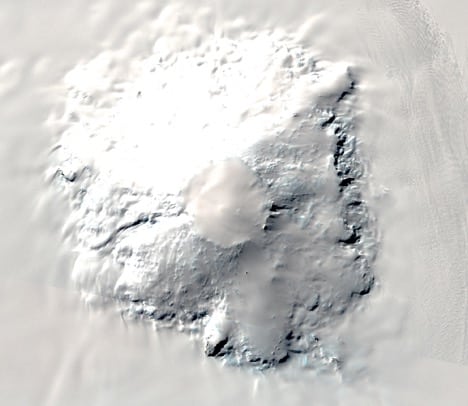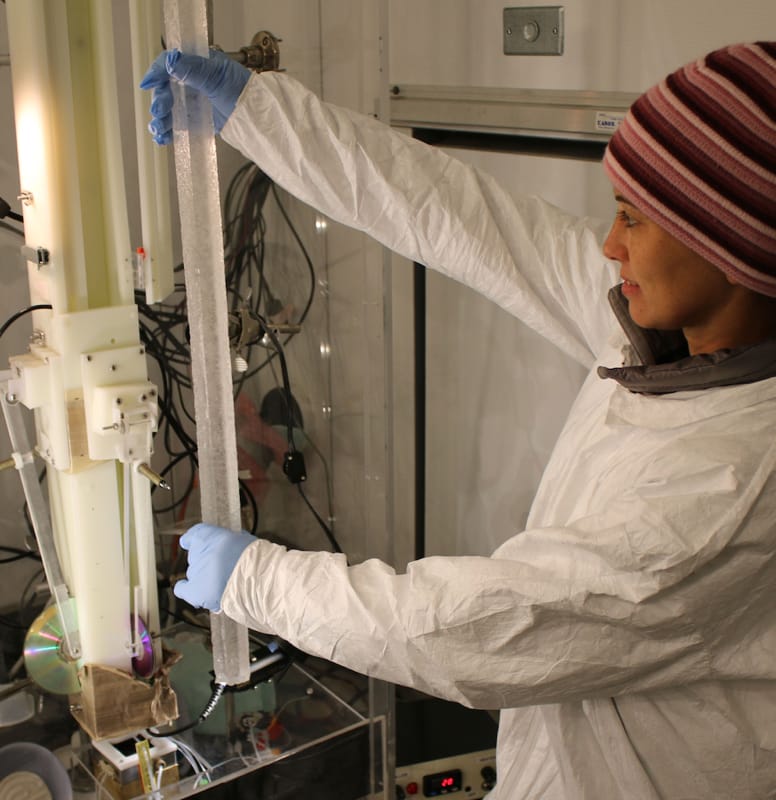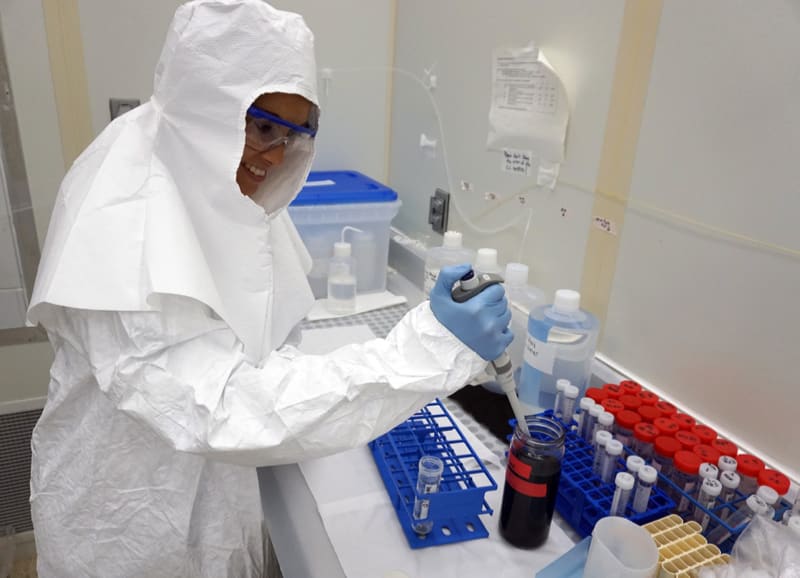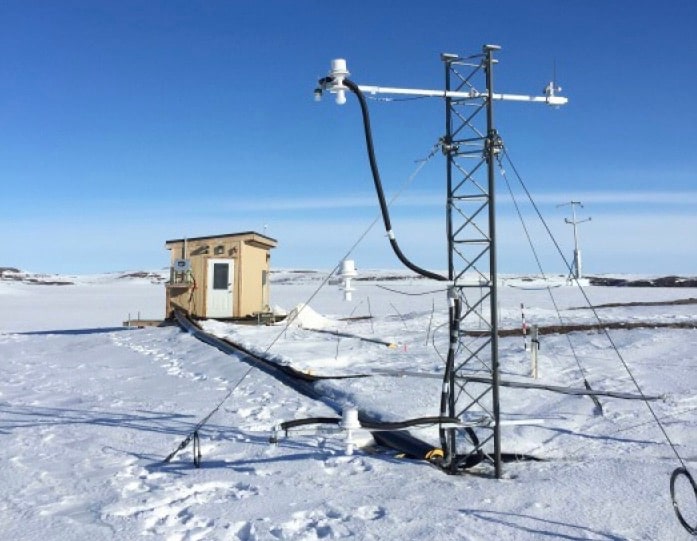
Nov 1, 2018 | Announcements, News releases
Las Vegas, NV (November 1, 2018): The Desert Research Institute, in partnership with the Bigelow Laboratory for Ocean Sciences and University of New Hampshire, announced receipt of a $6 million National Science Foundation grant today that will fund the development of new genetic research technologies and build economic capacity in Nevada, Maine, and New Hampshire.
The multifaceted effort, which the researchers will launch next week at the National Science Foundation in Washington, D.C., aims to unlock the genomic data of microscopic organisms that help to degrade environmental contaminants and drive major biogeochemical cycles that shape global climate.
“There has been an explosion of genomics data over the last two decades, and the next step is connecting that data to what’s actually happening in the environment,” said Ramunas Stepanauskas, Ph.D., director of the Single Cell Genomics Center at Bigelow Laboratory and principal investigator on the project. “We need new infrastructure and approaches to harness the power of genomic technologies, which will help solve some of the great biological mysteries of our planet.”
Single-celled organisms make up the vast majority of biological diversity on our planet, but many are found in hard-to-access places such as the Earth’s subsurface or deep ocean environments, can’t be seen with the naked eye, and can’t yet be grown in lab cultures. As a result, much about these organisms – including their potential for production of natural products for bioenergy, pharmaceuticals, bioremediation, and water treatment – remains unknown.

Bigelow Laboratory scientist Ramunas Stepanauskas collects a water sample on the institute’s dock. He is the principle investigator on a new $6 million project that will connect the genetic makeup of individual microbes to their environmental roles and build economic capacity in Maine, New Hampshire, and Nevada. Credit: Bigelow Laboratory for Ocean Sciences.
This four-year project will develop and apply new tools and techniques in genetic analysis to learn about links between the genomes (DNA, or genetic material) and phenomes (observable characteristics) expressed by single-celled organisms in diverse marine and continental environments. The main technical innovation of this project is that information is gained at the level of the individual cell sampled directly from the environment in near-real-time.
To achieve their objectives, the team will gather microbes from coastal ocean habitat in the Gulf of Maine, deep ocean and marine subsurface habitat along the Juan de Fuca Ridge of the northwestern Pacific Ocean, and terrestrial deep subsurface habitat in boreholes that intersect geological fault zones associated with Death Valley, Calif.
Duane Moser, Ph.D., head of DRI’s Environmental Microbiology and Astrobiology Labs in Las Vegas, will lead portions of the project related to the continental subsurface. Moser specializes in microbial and molecular ecology, and has studied microbes of deep underground environments in locations ranging from mines of South Africa, Canada, and the U.S., to caves, especially at Lava Beds National Monument of northern California, to deeply sourced springs from around the Great Basin.

DRI scientist Duane Moser collecting dissolved gas samples from the main project borehole near Death Valley, CA. Credit: Duane Moser/DRI.
The deep subsurface appears to serve as a unique repository for microbial diversity, preserving an evolutionary legacy that may range back to the early stages of cellular evolution, says Moser.
“Evidence continues to mount that the deep subsurface can be regarded as its own distinct biome, yet we lack the tools to determine how rock-hosted life persists in isolation over geologic timescales,” Moser said. “This project promises to not only teach us about the identities of to-date mysterious groups of microorganisms, but literally allows us to eavesdrop on the activities of individual cells in mixed communities from deep underground. That is truly unprecedented.”
Moser is also leading a task aimed at adapting the new technologies for the applied science of environmental bioremediation, using polyacrylamide as a test case. Polyacrylamide is a ubiquitous substance found in consumer products and used for drinking water treatment, amendment for agricultural soils, well drilling and fracking, and as a sealant for unlined irrigation canals. While generally considered non-toxic, commercial polyacrylamide preparations contain residues of acrylamide monomer, which do possess toxic properties.
“Microorganisms have a role in the degradation of most manmade contaminants, yet our mechanistic understanding of these essential transformations is largely limited to laboratory studies of a handful of easily cultured bacteria,” Moser said. “These new tools will enable us, for the first time, to identify and track the activities of the real actors behind the environmental degradation of contaminants.”

Image taken from within a naturally flowing artesian borehole in Death Valley, Calif., which will be utilized for the testing of experimental equipment prior to undersea deployment at the Juan de Fuca Ridge in the Pacific Ocean. Credit: Michael King, Hydrodynamics Group, LL.
The project funds come from the Established Program to Stimulate Competitive Research (EPSCoR), which aims to strengthen the research and technology capacity of states that have historically received low federal research funding. The project leverages Bigelow Laboratory’s state-of-the-art capacity in single cell genomics and flow cytometry, University of New Hampshire‘s expertise in polymer chemistry and synthesis of fluorescently labeled tracer molecules, and the Desert Research Institute’s experience and infrastructure for studying subsurface environments and contaminants of emerging concern.
“Combing single-cell genomics with measurements of microbial metabolism will help us better understand the role of microbes in cycling biologically important compounds,” said Kai Ziervogel, Ph.D., the microbial biogeochemist leading project efforts at University of New Hampshire. “I am excited that this project will provide undergraduate and graduate students opportunities to participate in interdisciplinary research that will contribute to environmental science in a unique way.”
In addition to creating new research infrastructure, the project will spur economic growth through skilled workforce training opportunities and several new jobs – including a new postdoctoral scientist at the Desert Research Institute, new senior research scientist and postdoctoral positions at Bigelow Laboratory, as well as a faculty member at University of New Hampshire. The research team will also provide professional development opportunities, including the training of graduate students and bioinformatics workshops in Maine, New Hampshire, and Nevada.
“As we improve our understanding of the critical functions of life, we can also improve our three collaborating states,” Stepanauskas said. “By enabling novel research, educational programs and workforce development, this work will have broad impact on the research community and beyond.”
Rachel Kaplan and Steven Profaizer from Bigelow Laboratory for Ocean Sciences contributed to this release.
###
The Desert Research Institute (DRI) is a recognized world leader in basic and applied interdisciplinary research. Committed to scientific excellence and integrity, DRI faculty, students, and staff have developed scientific knowledge and innovative technologies in research projects around the globe. Since 1959, DRI’s research has advanced scientific knowledge, supported Nevada’s diversifying economy, provided science-based educational opportunities, and informed policy makers, business leaders, and community members. With campuses in Reno and Las Vegas, DRI serves as the non-profit research arm of the Nevada System of Higher Education. Learn more at dri.edu, and connect with us on social media on Facebook, Instagram and Twitter.
Bigelow Laboratory for Ocean Sciences is an independent, nonprofit research institute on the coast of Maine. Its research ranges from the microscopic life at the bottom of marine food webs to large-scale ocean processes that affect the entire planet. Recognized as a leader in Maine’s emerging innovation economy, the Laboratory’s research, education, and technology transfer programs are contributing to significant economic growth. Learn more at bigelow.org, and join the conversation on Facebook,Instagram, and Twitter.
The University of New Hampshire (UNH) is a public research university in the University System of New Hampshire. With over 15,000 students between its Durham, Manchester, and Concord campuses, UNH is the largest university in the state. The School of Marine Science and Ocean Engineering, the heart of UNH’s oceanographic research, is the university’s first ‘interdisciplinary school’, designed to address today’s highly complex ocean and coastal challenges through integrated graduate education, research and engagement. As such, it serves as an interdisciplinary nexus for marine science and ocean engineering teaching and research across the University. Learn more at www.marine.unh.edu

Oct 31, 2018 | Blog, Featured researchers
Meet Nic Beres, a Ph.D. student in atmospheric sciences. At DRI, Beres is working with Dr. Hans Moosmüller from the Division of Atmospheric Science (DAS) in Reno to study the mechanisms by which light-absorbing impurities such as dust reduce surface reflectance of snow and ice.
What brought you to DRI?
I began my master’s degree in atmospheric science through DRI after working in the gaming industry here in Reno. Instead of helping to develop ways to trick people into losing their money behind a slot machine, I wanted to learn more about the natural environment and contribute to a greater good through some subset of climate science. Growing up in the Reno/Tahoe area, DRI was the perfect fit to satisfy this desire to learn more.
What are you studying?
For my Ph.D., I am working to better understand the mechanisms by which light-absorbing impurities reduce surface reflectance of snow and ice. These impurities can include aerosol such as mineral dust or black/brown carbon from combustion processes, or biological material like snow algae.

Graduate student Nic Beres conducts field research on surface reflectance of snow and ice. February 2018.
What research projects are you working on? And who at DRI are you working with?
I am primarily working alongside my graduate advisor, Hans Moosmüller. Together, we designed an experimental solution to artificially deposit aerosol of known properties onto the snow surface to derive its incremental reflectance-reducing effect. We can then compare those results to those predicted through modeling. Additionally, I am exploring the lesser-known effect that brown carbon aerosol – which is emitted through combustion processes like wildfire – has on the snowpack. I find myself spending as much time in the field as I do in the lab or behind a computer, so I feel lucky to be where I am.
What are your short-term and long-term goals while at DRI?
Short term: publish.
Long term: publish.
Tell us about yourself. What do you do for fun?
Like many staff, students, and researchers here at DRI, I find myself getting into the mountains. I love rock climbing, hiking, and skiing. I also enjoy photography, travel, and spending time with family, friends, and others that inspire and explore with me.

In his free time, graduate student Nic Beres enjoys spending time in the mountains.

Oct 30, 2018 | Blog, Featured projects
On a Monday morning in mid-October, several small groups of students from Pyramid Lake Junior/Senior High School gathered around tables inside of a conference room at the Desert Research Institute in Reno, sketching ideas, visions, and plans of what they want life on Earth to look like for future generations.
Schuyler Chew, a University of Arizona graduate student who is currently studying climate change resilience and vulnerability with the Pyramid Lake Paiute Tribe, encouraged the students to incorporate indigenous language, words, drawings, maps, poems, and stories into their drawings.
“Enlightenment. Growth. Water is life,” one group of students wrote on their poster paper, with key words and themes surrounding a drawing of Pyramid Lake. Another group sketched native wildlife and buildings outfitted with solar panels.

A Youth Day participant sketches his vision for Earth’s future. October 2018. Credit: NWAL/DRI.

A team of Native Waters on Arid Lands Youth Day facilitators adds their visions for the future. October 2018. Credit: NWAL/DRI.
The activity, part of a day-long event called Youth Day, was one of many hands-on activities, presentations, and discussions designed to engage the students in thinking about how to embrace the challenges of the future with regard to climate, water, and food.
The event was held as part of the Native Waters on Arid Lands project (NWAL), which partners scientists from research institutions such as DRI and the University of Nevada Reno with extension experts and members of tribal communities from across the Great Basin and American Southwest to explore the potential impacts of climate change and evaluate adaptation options for sustaining water resources and agriculture.
“The young people here today are incredibly gifted and creative, and our communities will rely on them to employ those gifts in facing the challenges of water, food, and climate in the future,” said Meghan Collins, youth engagement coordinator for the Native Waters on Arid Lands project and Assistant Research Scientist in environmental science at DRI.
Although the NWAL project did not initially place an emphasis on youth engagement, early feedback from project participants from various tribes was that they did not want to be talking about issues of climate without including younger voices in the conversation. In response, the NWAL team has held a series of events for tribal youth and college students at locations such as Salish Kootenai College in Montana, Navajo Technical University in New Mexico, and DRI in 2017 and 2018.

Youth Day organizer Meghan Collins of DRI instructs students in the use of Stories in the Snow kits. October 2018. Credit: NWAL/DRI.
During the course of their day at DRI, the group heard from Chris Caldwell from the College of Menominee Nation in Wisconsin, who discussed the work that he does with the school’s Sustainable Development Institute. Schuyler Chew, the graduate student from Arizona State University, described his research on climate change resilience and vulnerability with the Pyramid Lake Paiute Tribe. Steven Chischilly, Associate Professor at Navajo Technical University, described some of the educational opportunities available at his school in New Mexico.
Collins, the event organizer, led the students through an outdoor activity using Stories in the Snow macro-photography kits to explore the environment on the DRI campus and get a taste for scientific inquiry. DRI’s Science Alive Americorps volunteers Brooke Stathis and Chelsea Ontiveros concluded the event with an activity on the salinity and water quality of western rivers.
“The lively and reflective conversations that I heard today were inspiring,” Collins said. “Students brought their best, and we had a lot of intergenerational dialogue that meant everyone in the room walked away with new perspectives on these issues related to the environment.”

DRI Science Alive team members Brooke Stathis and Chelsea Ontiveros lead an activity at DRI Youth Day. October 2018. Credit: NWAL/DRI.
Later in the week, the Native Waters on Arid Lands project hosted their fourth annual Tribal Summit at the Atlantis Casino Resort in Reno. This event featured two days of presentations and interactive discussions related to climate change, water resources, agriculture, traditional knowledge, livestock and ranching, conservation practices, and other topics. More than 90 people attended the 2018 Tribal Summit, travelling from communities and reservations located across Nevada, North Dakota, New Mexico, Montana, Arizona, Idaho, Utah, Wisconsin, California, Ohio, and Hawaii.
Native Waters on Arid Lands is funded by a five-year, $4.5 million grant from the U.S. Department of Agriculture’s National Institute of Food and Agriculture. Partners in the project include the Desert Research Institute, the University of Nevada, Reno, the University of Arizona, the First Americans Land-Grant Consortium, Utah State University, Ohio University, United States Geological Survey, and the Federally Recognized Tribal Extension Program in Nevada and Arizona.
DRI faculty involved in this project include Maureen McCarthy, Ph.D. (program director), Christine Albano, Kyle Bocinsky, Ph.D., Meghan Collins, Richard Jasoni, Ph.D., Alex Lutz, Ph.D., Anna Palmer, Beverly Ramsey, Ph.D., and Kelsey Fitzgerald.

The Native Waters on Arid Lands team at DRI in October, 2017. Credit: NWAL/DRI.
For more information on Native Waters on Arid Lands, please visit https://nativewaters-aridlands.com or follow the project on Facebook and Twitter.

Oct 24, 2018 | Blog, Featured projects
Visit DRI’s Northern Nevada campus on a clear afternoon, and you may hear a near-deafening buzzing. A massive swarm of bees? Thankfully, no—it’s an unmanned aircraft system (UAS), or drone, being flown by researchers from DRI’s Airborne Systems Testing and Environmental Research (ASTER) laboratory.
Adam Watts, Ph.D., associate research professor of fire ecology and director of the ASTER lab, has worked over the last several years to apply UAS technology in a variety of research projects in dangerous or hard-to-access environments. Perhaps most notably, Watts led a 32-mile UAS flight at 1,500 feet above ground, the longest commercial UAS flight in American aviation history, in 2017. This historic flight was part of a larger effort to determine the feasibility of routinely using UAS for aerial cloud-seeding operations, which until recently have required pilots to fly in dangerous winter storm conditions. (You can read a full write up on the project in Popular Science.)

Drone America’s Savant sUAS flies with cloud seeding flares at the Hawthorne Industrial Airport in Hawthorne, Nev. on Friday, April 29, 2016. The test was successful by igniting the silver-iodide flares at 400 feet and flying for approximately 18 minutes. Photo by Kevin Clifford/Drone America.
More recently, Watts and his team in the ASTER lab have been working in entirely different environmental conditions: above prescribed burns.
“One of the big questions in land management, and in public health, is how smoke from prescribed fires versus wildfires differ, and what the effects are,” said Watts. His team is looking to UAS technology to explore this question and learn more about the differences between prescribed fire emissions and those from wildfire.
Earlier this year, postdoctoral researcher and fire ecologist Kellen Nelson, Ph.D., led the development of an innovative air sampling payload—a set of sensors and sampling equipment installed aboard the UAS—used to collect samples of wildland fire smoke. Traditionally, smoke has been collected by researchers from the air thousands of feet above the fire, or from a safe position on the ground far from the center of the smoke plume. Using a UAS, the research team has the unprecedented ability to collect samples directly from plumes and to move with a fire as its behavior changes, taking real-time measurements of CO2, CO, particulate matter, temperature, humidity, and pressure.

Jayne Boehmler holds up the data logger she designed to track real-time air quality measurements and remotely open the sampling canisters aboard the UAS. Kellen Nelson (left) and Adam Watts prepare the UAS (center) for flight in the background. October 2018.
“By collecting air samples, we’ll be able to test for trace gases and other constituents that we don’t have sensors to measure in real-time,” explained Nelson.
To do this work, the ASTER lab team has worked collaboratively with the researchers in DRI’s Organic Analytical Laboratory (OAL), a group that’s conducted ground-breaking air quality research over the last several years, including work to better understand the compounds present in e-cigarette emissions. The OAL provided sampling canisters to be installed on the UAS that are evacuated of all their contents. While in flight, the canisters are opened remotely to suck in the surrounding air, all using a handheld touchscreen controller developed by the team’s research physicist, Jayne Boehmler. Once the UAS is back on ground, the canisters are removed and returned to the OAL for analysis. Researchers hope these air quality data will improve understanding of smoke emissions from different fuel types.
“Smoke is really ephemeral,” explained Watts. “You’ll have a smoke plume moving around, or a little column of smoke coming up from a patch of vegetation that’s burning. Our custom payload on an unmanned aircraft is a powerful tool to make targeted measurements.”

Adam Watts explains how he’ll pilot the UAS for the test on DRI’s Northern Nevada Campus on October 11th, 2018.
Nelson and Watts successfully tested the payload at the Prescribed Fire Research Consortium’s research burn in Florida this spring and under laboratory conditions this fall. They’ve shown that the UAS can handle eight pounds of equipment with minimal vibration in flight and that the real-time data measurement is accurate. Going forward, Watts, Nelson, and Boehmler hope to test the payload in the field over live prescribed burns.
Last week, the team traveled to the Sycan Marsh Preserve, a Nature Conservancy property in southern Oregon, to test the UAS in the field with the Missoula Fire Lab and the Nature Conservancy. Unfavorable conditions prevented prescribed burns from happening on this trip, but the team has their sights set on getting the UAS back in the field soon.

Boehmler and Nelson work on the UAS at the Sycan Marsh Preserve in October 2018. Credit: Craig Bienz/The Nature Conservancy.
Watch the video to hear from Watts, Nelson, and Boehmler as they prepare for their trip to Oregon and learn more about UAS applications for wildland fire research.
To learn more about the range of UAS research happening at DRI, please visit: https://www.dri.edu/labs/aster/.

Oct 3, 2018 | Blog, Featured researchers
Henry Sun, Ph.D., is an associate research professor of microbiology with the Division of Earth and Ecosystem Sciences at the Desert Research Institute in Las Vegas. Henry specializes in the study of microscopic organisms that live in extreme environments, often using specimens from here on earth to learn about possibilities for life on Mars. He is originally from China and has a bachelor’s degree in botany and master’s degree in phycology (the study of algae) from Nanjing University. He also holds a Ph.D. in microbiology from Florida State University and completed a post-doc in astrobiology (the study of life in the universe) at the Jet Propulsion Lab in Pasadena, CA. Henry has been a member of the DRI community since 2004. In his free time, he enjoys playing pickup basketball with friends in Las Vegas, and spending time with his wife and two kids.
DRI: What do you do here at DRI?HS: I do quite a few things, all centered around the study of life in extreme environments – places that are in one way or another similar to Mars. We are studying what we call analog environments, trying to understand whether there’s life in these places that are comparable to Mars, learning how to go about detecting life and organisms, and developing ideas for reliable instruments that we can send to Mars to look for life there.
DRI: How did you become interested in this line of work?
HS: It started in graduate school, when I was given the opportunity to go to Antarctica, to a place called the Dry Valleys, to do my dissertation work. Until 1976, this was a place thought to be devoid of all life. But my former adviser, Imre Friedmann, extrapolating from his work in the hot deserts in the southwestern U.S., discovered thriving communities of microalgae and cyanobacteria in the pore spaces in the Antarctic sandstone. Sandstone is translucent, so sunlight can penetrate the first few millimeters. The stone holds onto water in the pore spaces so it doesn’t dry out right away. And that’s all you need to support life. I fell in love with these organisms on my very first trip there.

Henry Sun at work in Antarctica, January 2005.
DRI: What did you learn from studying those organisms?
HS: Probably the most remarkable thing we have learned about these organisms is that they have a very slow growth rate. We have monitored a few rocks closely over the last 50 years and never saw any appreciable signs of growth. In fact, they are so long-lived that their age can be determined by radiocarbon decay. In other words, if you look at their radiocarbon content, you would think they are dead, fossilized organisms. But we know they are alive because as soon as we thaw them to a normal temperature they start to breathe, taking up carbon dioxide and releasing oxygen. And because they start to grow and reproduce when we put them in a petri dish and incubate at more favorable temperature conditions.
That said, we still have a lot to learn about these organisms, and the opportunity for a serious study presented itself this year. When my former advisor passed away in 2007, he left behind a large collection of thousands of rocks from Antarctica, amassed over his career, in a walk-in -30oC freezer at Florida State University in Tallahassee, Florida. Last year, Florida State decided to decommission that building, and the samples were about to be thrown out. This past June, with a little help from DRI and NASA, we raised some money and purchased three freezers. I drove to Florida and hauled all of the samples back in a cargo van full of coolers and dry ice. I moved the entire collection to Las Vegas without them ever being thawed, so now they are sitting at DRI waiting to be studied.

An outcrop of Antarctic sandstone at one of Henry Sun’s field sites.
DRI: What are you planning to do with these samples?
HS: Inside of the freezers, the samples are kept at temperatures of -30oC (-22oF) and in complete darkness, but the microbes are still alive. As I said, we have thousands of samples. Only two samples have been studied using modern-day DNA analysis. So, the first thing we want to is a comprehensive molecular study and find out what lives in these samples.
We are also working with colleagues at the NASA Ames Research Center to look for cyanobacteria that can grow not using the visible light, but using the infrared. Visible light, which photosynthetic organisms prefer, is filtered out by the sandstone. But the infrared is still present. It is not as good as the visible, but that is all the organisms at the bottom of the colonized zone have. We speculate that they may subsist on the infrared.

Closeup of one of Henry Sun’s Antarctic rock samples, home to unknown species of microorganisms.
DRI: What do you like best about what you do?
HS: I feel most rewarded when we engage school teachers and their students in what we do. We do this through a program called Spaceward Bound, which was created by Chris McKay, DRI’s Nevada Medalist from two years ago. The goal is to train the next generation of space explorers in remote but scientifically interesting places that are analogous to the moon or Mars. The reason why we need to start this now is because the first human mission to Mars may happen as early as the 2030s. The scientists who will go to Mars to study its environment are still in school today. We have done several Spaceward Bound expeditions in the Mojave and Death Valley area with teachers and students from Nevada. To me, there is no greater reward than to see children get inspired by the work we do so that one day they may become scientists themselves and continue to push back the frontier of knowledge.

Henry Sun talks with a student at DRI’s 2018 ‘May Science Be With You’ event in Las Vegas.
For more information on Henry Sun and his research, continue to his research page: https://www.dri.edu/directory/henry-sun

Oct 1, 2018 | Blog, Featured projects
Students from DRI’s WASH Capacity Building Program learn about dry sanitation during a field trip to the University of eSwatini (Swaziland) project site at the community of Buka, eSwatini. September 2018. Credit: Braimah Apambire/DRI.
In August and early September 2018, several faculty members from the Desert Research Institute (DRI) found themselves far from home – teaching courses in water, sanitation, and hygiene (WASH) and environmental issues in the Kingdom of eSwatini, formerly known as Swaziland, a small country nestled along South Africa’s eastern border with Mozambique.
The courses, all focused on a set of interconnected environmental issues and public health challenges referred to by the acronym “WASH” (short for water, sanitation, and hygiene) are part of an ongoing WASH Capacity Building Program, operated by DRI’s Center for International Water and Sustainability (CIWAS). This program received a five-year funding award from humanitarian non-governmental organization World Vision earlier in 2018 and provides technical capacity training to field staff who work in the WASH sector in developing countries.

Students from DRI’s WASH Capacity Building Program on a field trip to a World Vision and eSwatini Water Services Corporation Program site in Matsanjeni, southeastern eSwatini. Students learned about management of piped water supply systems, sanitation technologies and transboundary water issues. September 2018. Credit: Braimah Apambire/DRI.

Students from DRI’s WASH Capacity Building Program on a University of eSwatini University-led field trip to the Mbabane Wastewater Treatment site. Credit: Braimah Apambire/DRI. September 2018.
“The WASH Capacity Building Program is a partnership between DRI, the University of Nevada, Reno, Drexel University, and World Vision,” explained Braimah Apambire, Director of CIWAS. “We’ve developed six courses which we teach partly online and partly face-to-face, and the students take four of those courses to complete our post-graduate certificate program. In April, we taught two courses in Ghana, and the two courses that we just taught in eSwatini were the next in the series.”
The current cohort — the third since the program’s pilot season in 2016 — consists of 30 students from 18 African countries. In eSwatini, their coursework focused on water supplies and environmental management in developing countries, and on cross-cutting issues in WASH. The classes were taught by Apambire, DRI’s Rosemary Carroll, Ph.D., and Alan Heyvaert, Ph.D., and Emmanuel Opong, Ph.D., of World Vision.

Participants in DRI’s WASH Capacity Program gathered in eSwatini during August and early September 2018 to complete courses in cross-cutting issues in water, sanitation, hygiene and environmental issues. The 2018 cohort includes 30 students from 18 countries. Sept. 2018. Credit: World Vision eSwatini Communications.

From left to right: Courses were taught by instructors Braimah Apambire, Ph.D. (DRI), Emmanuel Opong, Ph.D. (World Vision), Rosemary Carroll, Ph.D. (DRI), and Alan Heyvaert, Ph.D. (DRI). Sept 2018. Credit: World Vision eSwatini Communications.
The classroom time was interspersed with field trips to rural areas, dams, water and sanitation facilities, wastewater treatment plants, and more. Students got a firsthand look at some of the WASH challenges that are common in eSwatini and a chance to experience some of the region’s unique culture and countryside. CIWAS collaborators from the University of eSwatini gave guest lectures and organized field trips for the students during face-to-face teaching in the country.
“ESwatini is a mountainous country and very, very beautiful,” Apambire said. “It is a kingdom with a king who is the ruler of the country, and a traditional culture that is almost completely intact. Their government and NGOs, including World Vision, take interest in developing social programs that help people, especially the poor. But they still have rural areas that do not have water and sanitation facilities.”

Sibebe Rock, north of Mbabane, Capital of eSwatini, one of southern Africa’s most impressive geological features. Sept 2018. Credit: Braimah Apambire/DRI.

Students from DRI’s WASH Capacity Building Program take a field trip to eSwatini’s Buka Community. September 2018. Credit: Braimah Apambire/DRI.
Most notably, says Apambire, people of eSwatini are currently experiencing WASH challenges related to an ongoing drought, which neighboring South Africa is experiencing as well. DRI has had discussions with the University of eSwatini and some governmental departments about how the institute can help address their challenges.
“Because of the impact of climate change and reductions in rainfall, they are having some existing wells dry up,” Apambire said. “There needs to be more research to find out what some of the causes are and how to mitigate that. Artificial recharge is one option, and they probably also need to look for alternative sources of drinking water for those communities. That’s their biggest challenge right now.”

Students from DRI’s WASH Capacity Building Program on a University of eSwatini University-led field trip to a house in the Buka community where wastewater is used to grow vegetables. Credit: Braimah Apambire/DRI.

Five women are enrolled in the 2018 cohort of the WASH Capacity Building Program, receiving training that will help them become leaders in the WASH sector. Sept 2018. Credit: Braimah Apambire/DRI.
For women and girls in many African nations, challenges related to WASH impact everything from their ability to go to school each day to the survival and well-being of their children and families. For this reason, Apambire is pleased to report that, for the first time, five of the students in this year’s cohort are female.
“DRI is helping to build women leaders in this sector,” Apambire said. “Women in Africa are the ones that the burden of fetching water falls on. When you are a girl and there is no water in your village, you spend a lot of time going to fetch water, sometimes a mile or two away. Then you are not able to go to school, so it affects education. Having women become trained as WASH professionals and go back to the villages really empowers them to become a part of the implementation and management of these projects.”
This fall, students in the 2018 cohort of the WASH Capacity Building Program will finish their coursework online, with instruction from Apambire, Seshadri (Shey) Rajagopal, Ph.D. of DRI, Emmanuel Opong, Ph.D., and John Akudago, Ph.D., WASH Sector Expert. The program is now accepting applications for their 2019 cohort.
Learn more:
Follow CIWAS on Twitter at @driciwas – https://twitter.com/driciwas
For more information on CIWAS, please visit: https://www.dri.edu/ciwas/
For more information on the WASH Capacity Building Program, please visit: https://www.dri.edu/ciwas/wash-capacity-building-program/

Sep 28, 2018 | OAL
OAL scientists Drs. Vera Samburova and Yeongkwon Son attended the 2018 Nevada Public Health Association annual conference in Las Vegas. They gave presentations on potential hazards of e-cigarette use to the broad audience of health care providers, clinicians, educators, and researchers. The talks generated a lot of interest among the attendees and initiated productive discussions. Well done, Yeong and Vera!

Sep 26, 2018 | Blog, Featured projects
Several DRI researchers reported on recent projects at the Nevada Water Resources Association (NWRA) Fall Symposium in Reno this week. They were among engineers, resource managers, water rights professionals, and other stakeholders from across Nevada brought together by NWRA to discuss current water resource management topics, research and technology development, and legal issues related to water in the state.
DRI researchers explored a wide range of topics in their presentations, including drought and fire danger, innovations in irrigation, hydromechanics in mining operations, and more:
- Tim Brown, Ph.D., research professor of climatology and Director of the Western Regional Climate Center, explored the relationship between fuel moisture and fire danger.
- Dan McEvoy, Ph.D., assistant research professor of climatology and regional climatologist at the Western Regional Climate Center, identified a correlation between drought and dire danger indices and is now working with stakeholders to develop prediction strategies for fire based on EDDI (evaporative demand drought index).
- Alan Heyvaert, Ph.D., associate research professor of biochemistry, discussed the impacts of wildfire on surface water, including ash deposition, erosion, and declining water clarity.
- Zhiqiang Fang, Ph.D., postdoctoral researcher in the Division of Hydrologic Sciences, described two recent projects, including evaluating the effects of stresses on tunnels in mining operations using coupled hydromechanical models, and analyzing constant rate fluid injection into rock in geothermal systems.
- Hai Pham, Ph.D., postdoctoral fellow in the Division of Hydrologic Sciences, showed how his team has used groundwater models to examine the effect of groundwater pumping on surface water in the Tahoe Valley South groundwater basin.
- Maureen McCarthy, Ph.D., research faculty in the Division of Earth and Ecosystem Sciences, Christine Albano, graduate research assistant in the Division of Earth and Ecosystem Sciences, and Justin Huntington, Ph.D., research professor of hydrology, presented with colleagues from other institution–including the University of Nevada, Reno and USGS–about the Water for the Seasons project, a program that partners scientists with community water managers and water right holders in the Truckee-Carson River System (TCRS), to explore new strategies and solutions for dealing with extreme climate events such as droughts and floods. The four year study is funded by the National Science Foundation and the U.S. Department of Agriculture, and uses the TCRS in a pilot study to learn how to best link science with decision-making in snow-fed arid-land river systems. By working collaboratively with stakeholders, Water for the Seasons aims to create a model for improving community climate resiliency, or ability to adapt to extreme climatic conditions.
In operation for more than 70 years, NWRA is a non-profit professional association that provides education, networking, and training opportunities for water resources professionals in Nevada. To learn more about NWRA, visit: http://www.nvwra.org/
To learn more about the wide range of water resources research conducted at DRI, please visit: https://www.dri.edu/hydrologic-sciences
Sep 21, 2018 | Announcements, News releases
Reno, Nev. (Friday, Sept. 21) – Mountain snowpack and rainfall are the primary sources of water for the arid western United States, and water allocation rules determine how that water gets distributed among competing uses, including agriculture. Historically, agriculture in the West has benefited from predictable snowmelt, but under changing climate conditions, earlier melting of mountain snowpack is altering the timing of runoff, putting additional pressure on water storage and delivery infrastructure to meet the needs of agricultural water rights holders.
To explore solutions for these critical water problems, a research team led by the University of Nevada, Reno and including interdisciplinary experts from the Desert Research Institute, Colorado State University, Northern Arizona University, and Arizona State University has received $4.97 million from the USDA National Institute of Food and Agriculture for a major research effort into snowpack and water resources in the West.
Over the next five years, the research team will investigate:
- How changes in mountain snowpack affect available water,
- Which basins in the arid West are most at risk,
- The effectiveness of existing water allocation laws and regulation in managing these changes, in comparison with proposed modifications, and
- How changes in available water, and laws and regulations, affect the economic well-being of various groups in society – including the sustainability of agricultural production in the arid West.
“The impacts of changing mountain snowmelt on water rights holders are profound,” said Kim Rollins, University of Nevada, Reno professor and project director for the grant. “Increased risk affects private decisions to sell irrigation water rights, potentially causing permanent losses in the capacity for food production in the arid West. Decision-making can be improved with a better understanding of how changes in water flows influence agriculture producer decision-making and how laws and regulations can exacerbate or relieve constraints imposed by these changes.”
DRI’s Seshadri Rajagopal, Ph.D., assistant research professor of hydrometeorology, and Greg Pohll, Ph.D., research professor of hydrogeology, will be contributing their expertise in hydrologic modeling to the project. Specifically, Rajagopal and Pohll will be studying three significant watersheds throughout the arid West: the Walker in Nevada, the Verde in Arizona, and the South Platte in Colorado.
“We’ll be utilizing the national water model, a hydrologic model that simulates observed and forecasted streamflow over the entire continental United States, and adapting it for the study area to represent physical processes such as snowmelt, infiltration, and soil water storage,” explained Rajagopal. “This data will allow economists and policy makers to understand how water supply in these watersheds changes and to study its impact on water allocation and institutions.”
This project is one of seven total projects supported by the U.S. Department of Agriculture’s (USDA) National Institute of Food and Agriculture (NIFA) $34 million in grants for research through the Agriculture and Food Research Initiative (AFRI) Water for Food Production Systems Challenge Area, which is authorized by the 2014 Farm Bill.
The research team:
- Kimberly Rollins, professor, University of Nevada, Reno, College of Business, Department of Economics and Nevada Agricultural Experiment Station, College of Agriculture, Biotechnology and Natural Resources
- Loretta Singletary, interdisciplinary outreach liaison, University of Nevada Cooperative Extension and professor, University of Nevada, Reno, College of Business, Department of Economics
- Adrian Harpold, assistant professor in Natural Resources and Environmental Sciences, and Nevada Agricultural Experiment Station at the University of Nevada, Reno, College of Agriculture, Biotechnology and Natural Resources; Global Water Center
- Michael Taylor, assistant professor, University of Nevada, Reno, College of Business, Department of Economics and state specialist in agricultural and resource, University of Nevada Cooperative Extension
- Gi-Eu Lee, postdoctoral fellow, University of Nevada, Reno, College of Business, Department of Economics
- Seshadri Rajagopal, assistant research professor, Desert Research Institute, Division of Hydrologic Sciences
- Greg Pohll, professor, Desert Research Institute, Division of Hydrologic Sciences
- Dale Manning, assistant professor, Colorado State University, College of Agricultural Sciences, Agricultural and Resource Economics Department
- Christopher Goemans, associate professor, Colorado State University, College of Agricultural Sciences, Agricultural and Resource Economics Department
- Abigail York, associate professor, Arizona State University, School of Human Evolution and Social Change
- Benjamin Ruddell, associate professor, Northern Arizona University, School of Informatics, Computing and Cyber Systems
- Bryan Leonard, assistant professor, Arizona State University, School of Sustainability
To learn more about the USDA National Institute of Food and Agriculture grant recipients, please visit: https://nifa.usda.gov/. Nicole Shearer of the University of Nevada, Reno and Aaron Pugh of Arizona State University contributed to this release.
###
The Desert Research Institute (DRI) is a recognized world leader in basic and applied interdisciplinary research. Committed to scientific excellence and integrity, DRI faculty, students, and staff have developed scientific knowledge and innovative technologies in research projects around the globe. Since 1959, DRI’s research has advanced scientific knowledge, supported Nevada’s diversifying economy, provided science-based educational opportunities, and informed policy makers, business leaders, and community members. With campuses in Reno and Las Vegas, DRI serves as the non-profit research arm of the Nevada System of Higher Education.

Sep 20, 2018 | News releases, Research findings
Above: A lone researcher is silhouetted by the summer sun, low in the Antarctic sky. Credit: Bradley Markle, UCSB.
Reno, Nev. (Sept. 20, 2018) – In September, new research by a team from the University of California, Santa Barbara, the University of Washington, Columbia University, and the Desert Research Institute (DRI) was published in the journal Nature Geoscience. The study, titled Concomitant variability in high-latitude aerosols, water isotopes and the hydrologic cycle, utilized data provided by Joe McConnell, Ph.D., director of DRI’s Ultra-Trace Chemistry Laboratory in Reno, Nev.
The study explains an observed connection between concentrations of aerosols (small atmospheric particles such as mineral dust and sea-salt) and the ratios of different isotopes of water (variant forms of H20 in which the atoms carry extra neutrons) found in Antarctic ice cores.
Aerosol measurements for this study, which consisted of more than 500,000 measurements of calcium and sodium in 2.1 kilometers (1.3 miles) of Antarctic ice, were made in the Ultra-Trace Chemistry Laboratory using a unique continuous flow system and inductively coupled plasma mass spectrometry. Parts of these aerosol records have been published previously, but they are published in full in the new study. The full news release from U.C. Santa Barbara is below.

These shallow cores help us with the interpretation of the deep one,” explained UC Santa Barbara’s Bradley Markle. Credit: Bradley Markle, UCSB.
Dust, Rain and the Poles
Warmer climates will likely decrease the amount of airborne sediments reaching the poles
By Harrison Tasoff, University of California, Santa Barbara
Every year, the global climate transports billions of tons of dust around the world. These aerosols play a key role in many of Earth’s geological and biological cycles.
For instance, wind blows millions of tons of dust from the Sahara Desert across the Atlantic Ocean, where it fertilizes the Amazon Rainforest. The collective action of billions of trees pumping water from the ground then generates its own weather pattern, affecting the whole of South America.
When climate scientist Bradley Markle, at UC Santa Barbara’s Earth Research Institute, spotted a correlation between the ratios of heavy molecules and the concentration of particulate matter in the Antarctic ice cores he was studying, he immediately set out to uncover the deeper connection. His findings appear in the journal Nature Geoscience.
For decades scientists have been puzzled by the relationship between aerosol concentrations and the ratios of different molecules of water in ice cores, and Markle appears to have finally found the connection. His research increases our understanding of the processes at work in Earth’s atmosphere and could help to improve our climate models.
Markle focuses on understanding how climactic processes concentrate atoms of different weights in certain areas. Consider oxygen, for example. Every oxygen atom has eight positively charged protons. That’s what makes it oxygen. However, the number of neutrally charged neutrons it contains can vary from eight to 10. And the greater the number of neutrons, the heavier the isotope.
Water has one oxygen atom bonded to two hydrogen atoms, so water containing lighter isotopes, like 16O — which has eight neutrons — weighs less than water with heavier ones, like 18O — which has 10. Certain processes affect heavier molecules more than their lighter counterparts, leading to varying distributions of different weights across the globe. So even though 99.7 percent of oxygen on Earth is 16O, slight differences in the ratio between 16O and 18O provide scientists with valuable clues about the planet’s climate. In fact, measurements of these ratios in ice cores underlie our most detailed long records of Earth’s temperature history, Markle explained. They span hundreds of thousands of years before humans started measuring temperature directly.

Researchers examine the ice cores, which are backlit by the sun. Credit: Bradley Markle, UCSB.
Scientists noticed that ice layers with higher ratios of heavy isotopes also contained a greater concentration of trapped aerosols. “And it’s a very unique relationship, too,” Markle said. “It’s very clearly logarithmic … so it seems like it needs a strong, logarithmic process to account for it.
“The correlation between the thing that records the climate (the water isotope ratios) and these aerosols is extremely good,” he continued. “Better than you get in almost anything else in this field.”
Precipitation has the most influence on the percentage of heavy isotopes that make it to high latitudes, since heavier water molecules condense more readily compared to light ones, Markle explained. Warm air holds more moisture than cold air, so as it cools on its way toward the poles, the moisture condenses and preferentially loses the heavier molecules. If the poles become warmer, the air will not cool as much, so a greater number of heavy molecules will make it to higher latitudes. As a result, scientists associate low ratios of heavy isotopes with colder periods in Earth’s history.
Scientists suspected that these climatic conditions impacted the locations these aerosols came from, somehow effecting greater emissions during cooled periods than warm ones. However, years of research had yet to produce a model that fit the data. In addition, source variability is challenging to investigate because it requires looking at myriad factors in many different places. “People have investigated it, and they can’t get the sources to have such large changes in aerosol emissions,” Markle said.
Markle compared aerosol data from the Antarctic ice cores with similarly aged seafloor sediment from the oceans just below South America, which is the dominant source of the airborne dust found in Antarctica. He discovered that aerosol levels in the ocean sediment increased three- to six-fold during the last glacial maximum. However, concentrations in the ice cores soared to levels 20 to 100 times baseline rates. Clearly most of the change seen in the ice cores must be due to factors far from the source of the aerosols.
Then Markle recognized a similarity between the isotope ratios and the aerosol concentrations: The physics of moisture in the atmosphere is driving both of them.

A view of the Antarctic coast from the Southern Ocean. Credit: Bradley Markle, UCSB.
Without aerosols, the world would have no rain. Water vapor needs a surface to condense, or form droplets. This could be a steamy shower window or a fleck of dust floating high in the clouds. In this way, precipitation washes the sky of aerosols. More precipitation between the source of the aerosols and the poles means lower concentrations of aerosols make it to the glaciers, and thus into the ice cores. And more precipitation also leads to lower ratios of heavy isotopes. Markle had discovered the connection.
What’s more, the scouring effect precipitation has on aerosols is exponential, meaning its influence increases the longer, and farther, the aerosols travel from their source. Precisely the sort of relationship Markle needed to match the data.
“This rainout theory ends up solving a whole bunch of things at once,” Markle said. It clarifies the correlation between aerosol concentrations and water isotopes, as well as the greater variability in aerosol levels at the poles than in locations closer to the source of the debris. The effect also explains why dust levels vary more than sea salt levels in the aerosol record: The ocean is closer to Antarctica than the source of dust, so precipitation has less impact on the amount of sea salt that makes it to the West Antarctic ice-sheet.
Markle is cautious about making predictions for our current climate change. “The effect that we saw in the ice cores was a really big effect, but it’s a big effect on multicentury, multimillennium time scales,” Markle said. Other sources of variability may be more prominent over shorter timeframes, he explained.
Nonetheless, warming temperatures would forecast decreasing concentrations of aerosols reaching the Arctic and Antarctic. Since aerosols reflect heat and sunlight, this could exacerbate warming trends over long periods of time. Changes in aerosol distribution could also affect the ocean, since they also contain nutrients and minerals vital to ocean’s food web.
Markle plans to leverage his newfound understanding of these relationships to investigate changes not only in the strength of hydrologic cycle but also in its spatial pattern. “Because the hydrologic cycle is tied to Earth’s temperature gradients, I think we can use these records to understand changes in polar amplification,” he explained. This is the phenomenon where the poles warm more than lower latitudes during climate change.
“This is a big deal in modern climate change,” he added, “and understanding how it has happened in the past would be extremely useful.”
This news release was originally published by the University of California, Santa Barbara. To view the original story, please visit: http://www.news.ucsb.edu/2018/019185/dust-rain-and-poles
To view the study titled Concomitant variability in high-latitude aerosols, water isotopes and the hydrologic cycle, published in Nature Geoscience on 10 September 2018, please visit: https://www.nature.com/articles/s41561-018-0210-9
###
The Desert Research Institute (DRI) is a recognized world leader in basic and applied interdisciplinary research. Committed to scientific excellence and integrity, DRI faculty, students, and staff have developed scientific knowledge and innovative technologies in research projects around the globe. Since 1959, DRI’s research has advanced scientific knowledge, supported Nevada’s diversifying economy, provided science-based educational opportunities, and informed policy makers, business leaders, and community members. With campuses in Reno and Las Vegas, DRI serves as the non-profit research arm of the Nevada System of Higher Education. For more information, please visit www.dri.edu.

Sep 17, 2018 | OAL
The recent OAL publication “Aldehydes in Exhaled Breath during E-cigarette Vaping: Pilot Study Results” in the open access journal Toxics is highlighted in the DRI news release! Please read the full story here.

Sep 14, 2018 | OAL
Dr. Andrey Khlystov was invited to give a keynote speech at the 25th International Conference on Aerosol Science and Technology (ICAST) in Tainan, Taiwan. His presentation “Light-absorbing organic carbon in biomass burning aerosols, its properties and transformation” highlighted NSF-sponsored research done at the OAL.

Sep 10, 2018 | Announcements, News releases
Reno, NV (Sept 10, 2018) – Scientists from the Western Regional Climate Center (WRCC) at the Desert Research Institute (DRI) in Reno, NV are pleased to announce the release of a long-awaited update to a climate mapping tool called the California Climate Tracker (https://wrcc.dri.edu/Climate/Tracker/CA/).
Originally launched in 2009, the California Climate Tracker was designed to support climate monitoring in California and allows users to generate maps and graphs of temperature and precipitation by region. The 2018 upgrade incorporates substantial improvements including a more user-friendly web interface, improved accuracy of information based on PRISM data, and access to climate maps and data that go back more than 120 years, to 1895.

The map above, created using California Climate Tracker, shows mean temperature percentile rankings for different climatological regions in California during June – August 2018. Credit: Dan McEvoy, DRI.
“One really significant change between the old and new versions of the California Climate Tracker is that in the previous version, you weren’t able to look at archived maps,” said Daniel McEvoy, Ph.D., Assistant Research Professor of Climatology at DRI and member of the Climate Tracker project team. “Now you can say for example, ‘I want to see what the 1934 drought looked like,’ and go back and get the actual maps and data from 1934. You can also look at graphs of the data and see trends in temperature and precipitation over time.”
In addition to providing historical and modern data for regions across California, this easy-to-use web-based tool can be used to produce publication-quality graphics for reports, articles, presentations or other needs. It can be accessed for free by anyone with a standard web browser and an internet connection.
“The California Climate Tracker was initially designed and developed for use by the California Department of Water Resources, but we hope it is also useful to a much broader community of water managers, climatologists, meteorologists and researchers in California,” McEvoy said.

The map above, created using California Climate Tracker, shows precipitation percentile rankings for various climatological regions in California during October 2017 – August 2018. Credit: Dan McEvoy, DRI
The recent upgrade to this tool was the work of Nina Oakley, Ph.D., Justin Chambers, and McEvoy, all of whom are part of the Western Regional Climate Center at DRI. The original version of the California Climate Tracker tool was developed at DRI and designed by John Abatzoglou, Ph.D., now of the University of Idaho, based on a system for identifying regional patterns of climate variability within the state of California that he developed with Laura Edwards, M.S, now State Climatologist and Climate Field Specialist for the South Dakota State Climate Office, and the late Kelly Redmond, Ph.D., former regional climatologist for WRCC and DRI.
The California Climate Tracker was built with support from and in collaboration with the California Department of Water Resources. The team is currently in the process of building a similar tool for Nevada and are seeking funding partners to sponsor that work.
To access the California Climate Tracker tool, please visit: https://wrcc.dri.edu/Climate/Tracker/CA/
For more information on the Western Regional Climate Center at DRI, please visit: https://wrcc.dri.edu
###
The Desert Research Institute (DRI) is a recognized world leader in basic and applied interdisciplinary research. Committed to scientific excellence and integrity, DRI faculty, students, and staff have developed scientific knowledge and innovative technologies in research projects around the globe. Since 1959, DRI’s research has advanced scientific knowledge, supported Nevada’s diversifying economy, provided science-based educational opportunities, and informed policy makers, business leaders, and community members. With campuses in Reno and Las Vegas, DRI serves as the non-profit research arm of the Nevada System of Higher Education. For more information, please visit www.dri.edu.

Sep 5, 2018 | OAL
Deep Sengupta presented a poster “Semi-Volatile Organic Compounds in Fresh and Laboratory-Aged Biomass Burning Aerosols” and gave a talk “Estimation of Snow Albedo Reduction due to Deposition of Light Absorbing Aerosols Using a Monte Carlo Radiative Transfer Model” at the 10th International Aerosol Conference in St.Louis, USA. Well done, Deep!!

Sep 4, 2018 | Blog, Featured projects
Photo caption: Prototype sky-imaging camera. Credit: Eric Wilcox.
By: Jane Palmer
Reno, NV (September 1, 2018) – Solar energy is a clean and renewable energy source, but integrating solar power into the grid is not without challenges. For electricity to be useful, it needs to be delivered to users in a steady, reliable, and affordable way, says NEXUS scientist Eric Wilcox of the Desert Research Institute (DRI). But solar energy can only be generated when the sun is shining, so to guarantee a reliable source of electricity requires using power from other sources when the sun goes down or clouds shade solar panels. “This poses both a technical and an economic challenge,” Wilcox says. “How can we design systems so that solar power is maximized and backup power generation is minimized?”
NEXUS researchers have addressed this question from a variety of perspectives. Scientists at DRI and the University of Nevada, Las Vegas (UNLV) have investigated the fluctuations in solar power production due to cloudiness, in an attempt to build accurate forecasts. At UNLV, researchers have built a microgrid—a mini version of the electric power grid—that can operate independently of the main grid for testing “smart” technology. Such technologies will maintain a steady power supply when transitioning between solar power, gas-generated backup, and battery storage systems. Economics researchers at the University of Nevada, Reno (UNR) have also been performing economic analyses to determine how behavioral economics can motivate greater efficiency and utilization of renewable energy.“The promise of the approaches used and technology under development by this group is central to the mission of increasing the utilization of solar energy and mitigating pollution, by reducing the amount of fossil-fuel generated backup power needed to protect electricity grids from fluctuations in solar power generation,” Wilcox says.
Calculating Cloudiness
Although Nevada enjoys many sunny days each year, every few weeks or so, the North American monsoon effect carries moisture from the Gulf of California to form clouds over Southern Nevada. And when these clouds come, solar facilities can’t produce as much power.
Numerical weather prediction models can determine when one of these weather events will arrive up to five days in advance, but the models can’t predict when a particular cloud will move in between a solar panel array and the sun. Typically during these times, the amount of sunlight reaching a panel can vary dramatically over very short time scales, causing large fluctuations in voltage and power. Ideally, grid operators could anticipate from the forecasts when these events occur, so that they could coordinate a smooth transition toward using alternative power sources.
“The research has demonstrated the validity of using fluctuations in regional humidity over Las Vegas to characterize the error in solar forecasts derived from numerical weather prediction models,” Wilcox says. “So it will help achieve more accurate day-ahead solar forecasting.”
To detect and predict these quick power fluctuations, Wilcox and his team have built a prototype sky-imaging camera that takes images of the sky in the vicinity of solar photovoltaic (PV) arrays. The weatherproof camera takes the pictures and then analyzes them to distinguish cloudy pixels, which are the smallest units of a digital image, from clear sky pixels. Using this information, a computer algorithm can then track the movement of a cloud and predict when it will shade the PV array.
Following from this work, UNLV assistant professor Brendan Morris has explored more accurate prediction algorithms and UNLV scientist Venkatesan Muthukumar has investigated other concepts to produce distributed sensors for forecasting solar fluctuations. “This idea has really seemed to have caught on now and spread well beyond our DRI lab,” Wilcox says.
The low cost of the developed tool means the scientists could deploy the instruments at distributed solar PV sites in the city of Las Vegas and develop a shared database of sky images. This wealth of data will mean the researchers can continue to refine the algorithms that predict the cloud movements. “The goal is to build networks of sensors that can make predictions of solar generation fluctuations and communicate those forecasts to advanced control systems,” Wilcox says.
The researchers are continuing to work on developing the idea of making short-term forecasts of cloud cover in as little as 5 to 20 minutes away. The goal is to determine if the low-cost forecasting technology can make a difference in optimizing the use of batteries, such as the Tesla Powerwall batteries. “Grid operators may also be interested in the networked nature of this solution, so that optimization can happen at the neighborhood scale,” Wilcox says.
Mighty Microgrids
As the U.S. electric grid has been starting to run up against its limitations, the Department of Energy (DOE) has developed a vision of a future, more resilient, “smart” electric power infrastructure. The DOE Smart Grid Research and Development Program considers microgrids— localized grids that can disconnect from the traditional grid to operate autonomously—as key building blocks for this smart grid. Using such microgrids would facilitate integrating renewable sources of energy into the electrical infrastructure and offer other advantages for grid reliability.
“Microgrids can strengthen the grid resilience which is becoming increasingly important in the face of the increased frequency and intensity of power outages caused by severe weather due to climate change,” says NEXUS scientist Dr. Yahia Baghzouz of UNLV.
Baghzouz and his team have built a small microgrid at UNLV, which acts as a test bed to investigate the various devices that will be needed for the smart grid and technologies that will ultimately help with the integration of renewable energy resources into the grid infrastructure. Using this microgrid, the scientists have demonstrated that advanced inverters, which convert the output of photovoltaic solar arrays into utility frequency alternating current, can be configured to ride through voltage and frequency disturbances as well as assist with voltage support and reactive power requirements.
Simultaneously, NEXUS scientists Mehdi Etezadi-Amoli and M. Sami Fadali at UNR have built a new lab for simulating real-time digital monitoring and control of remote systems, such as the UNLV microgrid. Baghzouz is also testing the DRI forecasting technology for its ability to smooth out variations in solar power output to the electricity grid when coordinated with a battery energy storage system.
“The microgrid is the natural place to see how we can combine forecasting technology with other smart grid technology with the goal of increasing the reliability of solar power on the electric grid,” Wilcox says.
A Different Type of Forecast
Solar power has the potential to supply a sustainable and clean source of energy to households and industry in the state of Nevada and beyond, but to fully realize its benefits requires a detailed understanding of the economic costs and risks associated with its use. “The incorporation of solar into our power supply has to be done with the highest of knowledge, not only in engineering but also in economics,” says NEXUS economist Dr. Thomas Harris at UNR.
Consequently, Harris has also been looking at the risks, for investors, associated with this sustainable energy source. His work has demonstrated that income tax credits and appropriate depreciation schedules can yield rates of return on solar development greater than 15 percent, which is sufficient for private investment. The study also estimates that solar energy development on the 60,000 acres of Nevada designated by the Bureau of Land Management as Solar Economic Zones has the potential to yield $326 million annually in positive impacts on output, employment, and household income.
NEXUS economist Dr. Dilek Uz has been looking into solar energy policy and its political implications. “If, as a society, we have ambitious environmental goals, it is important that we reach them in the most cost effective way possible,” Uz says. When it comes to solar, large-scale projects seem to offer significant cost advantages relative to residential rooftop installations, however the whole issue is highly controversial and politically charged, Uz says.
Storage is the key to integrating renewables into the grid and this is where the new frontier in power utility regulation is, Uz says. Currently the renewable energy policy toolbox of many states includes rebates for residential rooftop solar installations as well as favorable rates for residential solar power. Uz is researching how the different benefits provided by owning a rooftop panel are valued at the residential level. It is research that will inform policy on the correct subsidy level for better use of tax payer money. She is also looking into how owning a rooftop solar panel correlates with voting patterns on energy related issues.
The economics team is also collaborating with the DRI researchers in analyzing the benefits of improved cloud forecasting techniques to mitigate the impacts of intermittency on the economics of solar. “How much does using this technology cost?” Harris says. “It is a very complicated issue from a solar standpoint.”
For solar power to be not just sustainable, but profitable, in future decades economists have to investigate all the variables and permutations associated with this relatively new industry, Harris says.
A Model Future
A common thread running through the research investigating maximizing the benefits of solar power while minimizing the costs is that of building models to test out different systems, technologies and theories. At DRI, the scientists numerically simulate the weather using a supercomputer and at UNLV, the engineers have constructed a physical model of a grid in the form of the experimental microgrid.
Creating such models allows the scientists to see how such complex systems would react in different scenarios e.g., to investigate how the solar power responds to different degrees of cloudiness, or how different technologies can smooth out fluctuations in the grid. Questions like these are difficult to answer only by observing real systems because often so many elements of the system change at the same time. “Modeling is an important research tool for estimating the behavior of such complex systems because we can carefully control the environment,” Wilcox says.
Similarly, at UNR, the NEXUS economists have constructed numerical models to simulate the economic relationships among participants in the energy and development markets in Nevada.
Fluctuations in solar and wind generation are often cited as a limiting factor in preventing generation of a large majority of electricity from renewable sources, Wilcox says. “We seek to understand the economic factors that may limit solar electricity development and then we seek to mitigate the fluctuations that limit the extent to which the grid can depend on solar electricity,” he says. “Overcoming these limitations is essential to reducing greenhouse gases and other pollution emissions from traditional fossil fuel sources of electricity generation.”###
This article was written by Jane Palmer for the Solar Nexus project. The original post is available here: https://solarnexus.epscorspo.nevada.edu/secrets-of-successful-solar/
Started June 1, 2013, the Solar Nexus Project is a multifaceted five-year research project focusing on the nexus (or linkage between) solar energy generation and Nevada’s limited water resources and fragile environment. The focus of the Solar Nexus Project is creating a center of research excellence on solar energy conversion to electricity, minimizing its negative impacts on water usage and the environment. In essence, seeking to create a paradigm shift in how solar plants are built and utilized, helping Nevada establish itself as a competitive state in the field of solar nexus research.
The Desert Research Institute (DRI) is a recognized world leader in basic and applied interdisciplinary research. Committed to scientific excellence and integrity, DRI faculty, students, and staff have developed scientific knowledge and innovative technologies in research projects around the globe. Since 1959, DRI’s research has advanced scientific knowledge, supported Nevada’s diversifying economy, provided science-based educational opportunities, and informed policy makers, business leaders, and community members. With campuses in Reno and Las Vegas, DRI serves as the non-profit research arm of the Nevada System of Higher Education.

Aug 28, 2018 | News releases, Research findings
Above: In semi-arid ecosystems such as the Humboldt-Toiyabe National Forest near Las Vegas, which burned as part of the Carpenter 1 fire during July and August 2013, fuel is limited and fires tend to be short lived and low in peak temperature. New research shows that these fires are more harmful to soils than they initially appear. This photo was taken on January 6, 2015 – approximately 18 months after the wildfire. Credit: Teamrat Ghezzehei, UCM.
New research shows negative effects of fire on soil structure and organic matter
Las Vegas, NV (August 28, 2018): Low-severity wildland fires and prescribed burns have long been presumed by scientists and resource managers to be harmless to soils, but this may not be the case, new research shows.
According to two new studies by a team from the University of California, Merced (UCM) and the Desert Research Institute (DRI), low-severity burns – in which fire moves quickly and soil temperature does not exceed 250oC (482oF) – cause damage to soil structure and organic matter in ways that are not immediately apparent after a fire.
“When you have a high-severity fire, you burn off the organic matter from the soil and the impact is immediate,” said Teamrat Ghezzehei, Ph.D., principal investigator of the two studies and Associate Professor of Environmental Soil Physics at UCM. “In a low-severity fire, the organic matter doesn’t burn off, and there is no visible destruction right away. But the burning weakens the soil structure, and unless you come back at a later time and carefully look at the soil, you wouldn’t notice the damage.”
DRI researcher Markus Berli, Ph.D., Associate Research Professor of Environmental Science, became interested in studying this phenomenon while visiting a burned area near Ely, Nev. in 2009, where he made the unexpected observation that a prescribed, low-severity fire had resulted in soil structure damage in the burned area. He and several colleagues from DRI conducted a follow-up study on another controlled burn in the area, and found that soil structure that appeared to be fine immediately after a fire but deteriorated over the weeks and months that followed. Berli then teamed up with Ghezzehei and a team from UCM that included graduate student Mathew Jian, and Associate Professor Asmeret Asefaw Berhe, Ph.D., to further investigate.

Researcher Markus Berli from the Desert Research Institute examines the soils at a burned area in the Humboldt-Toiyabe National Forest near Las Vegas on January 6, 2015, approximately 18 months after the area burned in the Carpenter 1 fire of 2013. Credit: Teamrat Ghezzehei, UCM.
Soil consists of large and small mineral particles (gravel, sand, silt, and clay) which are bound together by organic matter, water and other materials to form aggregates. When soil aggregates are exposed to severe fires, the organic matter burns, altering the physical structure of the soil and increasing the risk of erosion in burned areas. In low-severity burn areas where organic matter doesn’t experience significant losses, the team wondered if the soil structure was being degraded by another process, such as by the boiling of water held within soil aggregates?
In a study published in AGU Geophysical Research Letters in May 2018, the UCM-DRI team investigated this question, using soil samples from an unburned forest area in Mariposa County, Calif. and from unburned shrubland in Clark County, Nev. to analyze the impacts of low-severity fires on soil structure. They heated soil aggregates to temperatures that simulated the conditions of a low-severity fire (175oC/347oF) over a 15-minute period, then looked for changes in the soil’s internal pore pressure and tensile strength (the force required to pull the aggregate apart).
During the experiment, they observed that pore pressure within the soil aggregates rose to a peak as water boiled and vaporized, then dropped as the bonds in the soil aggregates broke and vapor escaped. Tensile strength measurements showed that the wetter soil aggregates had been weakened more than drier soil samples during this process.
“Our results show that the heat produced by low-severity fires is actually enough to do damage to soil structure, and that the damage is worse if the soils are wet,” Berli explained. “This is important information for resource managers because it implies that prescribed burns and other fires that occur during wetter times of year may be more harmful to soils than fires that occur during dry times.”Next, the research team wondered what the impact of this structural degradation was on the organic matter that the soil structure normally protects. Soil organic matter consists primarily of microbes and decomposing plant tissue, and contributes to the overall stability and water-holding capacity of soils.
In a second study that was published in Frontiers in Environmental Science in late July, the UCM-DRI research team conducted simulated burn experiments to weaken the structure of the soil aggregates, and tested the soils for changes in quality and quantity of several types of organic matter over a 70-day period.
They found that heating of soils led to the release of organic carbon into the atmosphere as CO2 during the weeks and months after the fire, and again found that the highest levels of degradation occurred in soils that were moist. This loss of organic carbon is important for several reasons, Ghezzehei explained.
“The loss of organic matter from soil to the atmosphere directly contributes to climate change, because that carbon is released as CO2,” Ghezzehei said. “Organic matter that is lost due to fires is also the most important reserve of nutrients for soil micro-organisms, and it is the glue that holds soil aggregates together. Once you lose the structure, there are a lot of other things that happen. For example, infiltration becomes slower, you get more runoff, you have erosion.”

Researcher Rose Shillito from DRI collects soil samples in a burned area in the Humboldt-Toiyabe National Forest near Las Vegas on January 6, 2015, approximately 18 months after the area burned in the Carpenter 1 fire of 2013. Credit: Teamrat Ghezzehei, UCM.
Although the research team’s findings showed several detrimental effects of fire on soils, low-severity wildfires and prescribed burns are known to benefit ecosystems in other ways — recycling nutrients back into the soil and getting rid of overgrown vegetation, for example. It is not yet clear whether the negative impacts on soil associated with these low-severity fires outweigh the positives, Berli says, but the team hopes that their research results will help to inform land managers as they manage wildfires and plan prescribed burns.
“There is very little fuel in arid and semi-arid areas, and thus fires tend to be short lived and relatively low in peak temperature,” Ghezzehei said. “In contrast to the hot fires and that burn for days and weeks that we see in the news, these seem to be benign and we usually treat them as such. Our work shows that low-severity fires are not as harmless as they may appear.”
The study, “Soil Structural Degradation During Low‐Severity Burns,” was published on May 31, 2018 in the journal AGU Geophysical Research Letters and is available here: https://agupubs.onlinelibrary.wiley.com/doi/full/10.1029/2018GL078053.
The study, “Vulnerability of Physically Protected Soil Organic Carbon to Loss Under Low Severity Fires,” was published July 19, 2018 in the journal Frontiers in Environmental Science, and is available here: https://www.frontiersin.org/articles/10.3389/fenvs.2018.00066/full.
###
The Desert Research Institute (DRI) is a recognized world leader in basic and applied interdisciplinary research. Committed to scientific excellence and integrity, DRI faculty, students, and staff have developed scientific knowledge and innovative technologies in research projects around the globe. Since 1959, DRI’s research has advanced scientific knowledge, supported Nevada’s diversifying economy, provided science-based educational opportunities, and informed policy makers, business leaders, and community members. With campuses in Reno and Las Vegas, DRI serves as the non-profit research arm of the Nevada System of Higher Education. For more information, please visit www.dri.edu.

Aug 27, 2018 | OAL
A Warning About Vaping
OAL’s e-cigarette research is on the front page of Reno Gazette Journal!

Aug 22, 2018 | Uncategorized
We had lunch at the OAL’s favorite sushi place today to welcome Dr. Ting Zhang to the lab. Ting will be working with Dr. Andrey Khlystov at DRI and Dr. Sergey Varganov at UNR to study thermal decomposition of e-cigarette flavorants. Her project has both laboratory and modeling components. Welcome, Ting!

Aug 21, 2018 | OAL
The latest OAL publication by Vera Samburova et al. on aldehydes in exhaled breath attracted the attention of all major local media outlets! Please click “Continue reading” to see image gallery and enable links to videos.
Reno Gazette Journal (RGJ) story: https://www.rgj.com/story/news/2018/08/20/vaping-leaves-cancer-causing-chemicals-lungs-study/1015582002/ and RGJ Facebook Live: https://www.facebook.com/RGJmedia/videos/301882897057641/

RGJ reporter interviews OAL team for FB live
KTVN Channel 2 news story: http://www.ktvn.com/story/38910498/pilot-study-shows-significant-amount-of-carcinogens-stay-in-lungs-after-vaping

KTVN2 reporter interviews Dr. Vera Samburova
News 4-Fox 11 story: https://mynews4.com/news/local/dri-scientists-e-cigs-leave-dangerous-amounts-of-cancer-causing-chemicals-in-lungs

Fox 11 reporter and cameraman interviews Dr. Khlystov

Aug 15, 2018 | News releases, Research findings
Above: Dr. Vera Samburova works in the organic analytical lab at Desert Research Institute, in Reno, Nev., on Tuesday, Feb. 20, 2018.
Photo by Cathleen Allison/Nevada Momentum
Reno, NV (August 15, 2018) – E-cigarettes have become increasingly popular as a smoke-free alternative to conventional tobacco cigarettes, but the health effects of “vaping” on humans have been debated in the scientific and tobacco manufacturing communities. While aldehydes—chemicals like formaldehyde that are known to cause cancer in humans—have been identified in e-cigarette emissions by numerous studies, there has been little agreement about whether such toxins exist in large enough quantities to be harmful to users.
Now, a recently published pilot study by a team of researchers from the Desert Research Institute (DRI) and the University of Nevada, Reno shows that significant amounts of cancer-causing chemicals such as formaldehyde are absorbed by the respiratory tract during a typical vaping session, underscoring the potential health risks posed by vaping.
“Until now, the only research on the respiratory uptake of aldehydes during smoking has been done on conventional cigarette users,” said Vera Samburova, Ph.D., associate research professor in DRI’s Division of Atmospheric Sciences and lead author of the study. “Little is known about this process for e-cigarette use, and understanding the unique risks vaping poses to users is critical in determining toxicological significance.”
Samburova and fellow DRI research professor Andrey Khlystov, Ph.D., have been investigating the health risks associated with e-cigarettes for several years. In 2016, they published findings confirming that dangerous levels of aldehydes are formed during the chemical breakdown of flavored liquids in e-cigarettes and emitted in e-cigarette vapors.
In this study, Samburova and her team estimated e-cigarette users’ exposure to these hazardous chemicals by analyzing the breath of twelve users before and after vaping sessions using a method she and Khlystov have developed over the course of their work together. Through this process, they determined how much the concentration of aldehydes in the breath increased. Researchers then subtracted the concentration of chemicals in exhaled breath from the amount found in the vapors that come directly from the e-cigarette.
The difference, Samburova explains, is absorbed into the user’s lungs.

E-cigarettes in the Organic Analytical Lab at DRI.
“We found that the average concentration of aldehydes in the breath after vaping sessions was about ten and a half times higher than before vaping,” Samburova said. “Beyond that, we saw that the concentration of chemicals like formaldehyde in the breath after vaping was hundreds of times lower than what is found in the direct e-cigarette vapors, which suggests that a significant amount is being retained in the user’s respiratory tract.”
The research team took care to ensure that the test conditions of the study mirrored real-life vaping sessions as much as possible. Most participants used their own e-cigarette devices during the study, used e-liquid flavors that were familiar to them, and inhaled for the amount of time that they ordinarily would, which allowed the research team to understand how e-cigarettes are typically used by regular users. Because they tested “normal” vaping experiences, researchers confirmed that the high concentrations of aldehydes found in other studies aren’t limited to laboratory conditions.
“Our new pilot study underlines the potential health risk associated with the aldehydes generated by e-cigarettes,” said Samburova. “In the future, e-cigarette aldehyde exposure absolutely needs to be studied with a larger set of participants.”
The study, “Aldehydes in Exhaled Breath during E-Cigarette Vaping: Pilot Study Results,” was published on August 7th in the journal Toxics and is available here: https://www.mdpi.com/2305-6304/6/3/46/htm#app1-toxics-06-00046. DOI: 10.3390/toxics6030046
This research was independently funded by DRI and conducted in DRI’s Organic Analytical Laboratory located in Reno, Nevada. For more information about the Organic Analytical Lab, visit: https://www.dri.edu/labs/oal/.
###
The Desert Research Institute (DRI) is a recognized world leader in basic and applied interdisciplinary research. Committed to scientific excellence and integrity, DRI faculty, students, and staff have developed scientific knowledge and innovative technologies in research projects around the globe. Since 1959, DRI’s research has advanced scientific knowledge, supported Nevada’s diversifying economy, provided science-based educational opportunities, and informed policy makers, business leaders, and community members. With campuses in Reno and Las Vegas, DRI serves as the non-profit research arm of the Nevada System of Higher Education. For more information, please visit www.dri.edu.
Jul 30, 2018 | Announcements, News releases
ACCRA, GHANA (July 30, 2018) – Highlighted by a meeting with President Nana Akufo-Addo, the successful first leg of Governor Brian Sandoval’s trade mission to Africa wrapped up in Ghana on Sunday. Coordinated by the Governor’s Office of Economic Development (GOED), the trade mission features higher education, mining and trade contingents as well as selected Nevada state officials. On Thursday, the delegation joined the Ghana business community for a meeting hosted by the American Chamber of Commerce-Ghana, Newmont Mining, and U.S. Ambassador to Ghana Robert P. Jackson.
“The friendship between Ghana and Nevada is a special one and it is wonderful to see the real impact partnerships, such as the nearly 27-year relationship between the Desert Research Institute and Ghana, has on the lives of people here,” said Governor Brian Sandoval. “There is a solid foundation in Ghana for a growing relationship based on innovation and trade to the mutual benefit of Ghanaians and Nevadans and I am pleased to have played a part in helping continue discussions.”
On Friday, the delegation heard from Dr. Kristen Averyt of the Desert Research Institute (DRI) about the Institute’s work in Ghana. Since 1991, DRI has provided technical training and research to water project staff in West Africa in the latest exploration and management techniques. DRI also has a memorandum of understanding with the University for Development Studies (UDS) in Northern Ghana to establish a first-in-the-region Water, Sanitation and Hygiene (WASH) Center at UDS.
In January 2018, DRI and UDS cohosted the first international conference through the WASH Center. DRI and UDS also partnered with Catholic Relief Services (CRS) to support the ongoing Integrated Sanitation, Hygiene, and Nutrition for Education (I-SHINE) project in 138 communities in Northern Ghana.
“The partnership with CRS on this critical work arose from the Nevada Governor’s trade mission to the Vatican,” GOED Director Paul Anderson said. “The focus of this project is to address the drop off in school attendance by girls reaching adolescence as a result of inadequate WASH services. Our meeting on Friday was a wonderful way to hear from various organizations about the philanthropic work being done in Ghana, as well as the opportunities for both Nevadan and Ghanaian businesses.”
After departing Ghana, the Nevada trade mission has moved on to South Africa, with stops over the next week in Cape Town and Durban.
This release was originally published by the Governor’s Office of Economic Development (GOED). To learn more about GOED, visit www.diversifynevada.com.
To learn more about DRI’s Center for International Water and Sustainability, visit: https://www.dri.edu/ciwas/.
###
The Desert Research Institute (DRI) is a recognized world leader in basic and applied interdisciplinary research. Committed to scientific excellence and integrity, DRI faculty, students, and staff have developed scientific knowledge and innovative technologies in research projects around the globe. Since 1959, DRI’s research has advanced scientific knowledge, supported Nevada’s diversifying economy, provided science-based educational opportunities, and informed policy makers, business leaders, and community members. With campuses in Reno and Las Vegas, DRI serves as the non-profit research arm of the Nevada System of Higher Education. For more information, please visit www.dri.edu.

Jul 20, 2018 | News releases, Research findings
Stone tool assemblage recovered from the Gault Site. Credit: Produced by N Velchoff, The Gault School of Archaeological Research.
Luminescence dating confirms human presence in North America prior to 16 thousand years ago, earlier than previously thought
July 20, 2018 (Reno, NV) – For decades, researchers believed the Western Hemisphere was settled by humans roughly 13,500 years ago, a theory based largely upon the widespread distribution of Clovis artifacts dated to that time. Clovis artifacts are distinctive prehistoric stone tools so named because they were initially found near Clovis, New Mexico, in the 1920s but have since been identified throughout North and South America.
In recent years, though, archaeological evidence has increasingly called into question the idea of “Clovis First.”Now, a study published by a teamincluding DRI’s Kathleen Rodrigues, Ph.D. student, and Amanda Keen-Zebert, Ph.D., associate research professor, has dated a significant assemblage of stone artifacts to 16-20,000 years of age, pushing back the timeline of the first human inhabitants of North America before Clovisby at least 2,500 years.
Significantly, this research identifies a previously unknown, early projectile point technology unrelated to Clovis, which suggests that Clovis technology spread across an already well-established, indigenous population.
“These projectile points are unique. We haven’t found anything else like them,” said Tom Williams, Ph.D., Postdoctoral Research Associate in the Department of Anthropology at Texas State University and lead author of the study. “Combine that with the ages and the fact that it underlies a Clovis component, and the Gault site provides a fantastic opportunity to study the earliest human occupants in the Americas.”
The research team identified the artifacts at the Gault Site in Central Texas, an extensive archaeological site with evidence of continuous human occupation. The presence of Clovis technology at the site is well-documented, but excavations below the deposits containing Clovis artifacts revealed well-stratified sediments containing artifacts distinctly different from Clovis.

To determine the ages of these artifacts, Rodrigues, Keen-Zebert, and colleagues used a process called optically stimulated luminescence (OSL) dating on the sediments surrounding them. In OSL, researchers expose minerals that have long been buried under sediment layers to light or heat, which causes the minerals to release trapped potassium, uranium, and thorium electrons that have accumulated over time due to exposure to ambient, naturally occurring radiation.When the trapped electrons are released, they emit photons of light which can be measured to determine the amount of time that has elapsed since the materials were last exposed to heat or sunlight.
“The fluvial nature of the sediments deposited at the Gault Site have created a poor environment for preservation of organic materials, so radiocarbon dating has not been a useful technique to apply in this region,” said Kathleen Rodrigues, graduate research assistant in DRI’s Division of Earth and Ecosystem Sciences. “This made luminescence dating a natural choice for dating the archaeological materials here. We are really pleased with the quality of the results that we have achieved.”
Jayme Blaschke of the Texas State University Office of Media Relations contributed to this release.
The Desert Research Institute (DRI) is a recognized world leader in investigating the effects of natural and human-induced environmental change and advancing technologies aimed at assessing a changing planet. For more than 50 years DRI research faculty, students, and staff have applied scientific understanding to support the effective management of natural resources while meeting Nevada’s needs for economic diversification and science-based educational opportunities. With campuses in Reno and Las Vegas, DRI serves as the non-profit environmental research arm of the Nevada System of Higher Education. For more information, please visit www.dri.edu.
Jul 19, 2018 | Announcements, News releases
Reno, NV (July 19, 2018): The Desert Research Institute is proud to announce that the DRI Science Alive K-12 Outreach Program has been selected as one of several recipients of the first round of funding through Tesla’s new Nevada K-12 Education Investment Fund. This funding is an initial disbursement, part of a multi-year proposed plan Tesla has developed in partnership with DRI to invest in Nevada’s education system.
Because of the proven success and expertise of DRI’s Science Alive K-12 Outreach Program in engaging students in STEM and training Nevada educators, Tesla has looked to DRI to help develop and implement a statewide professional development infrastructure for educators that will give Nevada students the chance to get excited about STEM early on in their education and give them the skills needed to success in a STEM career.
“On behalf of everyone at the Desert Research Institute, we are honored to be a part of this important moment for Nevada students and we are tremendously proud that Tesla has looked to DRI to help develop and implement Nevada’s teacher training infrastructure,” said DRI President Kristen Averyt, Ph.D.
With an initial investment from Tesla of $263,924, the DRI Science Alive program staff will develop a statewide teacher professional development curriculum and onboarding process for new robotics programs in partnership with FIRST, the REC Foundation (VEX), Solar Roller, and the University of Nevada, Reno and the University of Nevada, Las Vegas.
In addition to coordinating teacher trainings, DRI will also be evaluating the effectiveness of robotics programs in student achievement and attitudes toward STEM.
“Our hope is that after implementing and evaluating this model of encouraging STEM engagement through robotics, we can improve upon current methods and ultimately develop best practices for all schools,” said Amelia Gulling, DRI’s K-12 STEM Education Manager. “If we find that this model is successful in Nevada, where we have some of the worst education rankings in the country, then it’s the model that we need to use across the country.”
Official Nevada Department of Education release:
TESLA ANNOUNCES INITIAL $1.5M IN K-12 EDUCATION GRANTS
CARSON CITY, Nev. – As part of its commitment to contribute $37.5 million over five years to K-12 education in Nevada, Tesla announced an initial $1.5 million in funding grants at today’s Nevada Board of Education meeting. The goal of the investment is to encourage students of all backgrounds to consider a career in science, technology, engineering and math (STEM) or sustainability, and to develop the next generation of engineers in Nevada.
“An integral part of our vision for the new Nevada economy is developing an educated workforce that meets the demands of the industries coming into our state,” said Gov. Brian Sandoval. “With this initial investment, even more students in Nevada will be exposed to STEM education and we are grateful to Tesla for their commitment to education in Nevada.”
Tesla announced the following education grants today:
- $315,550 to FIRST Nevada and $127,100 to Robotics Education and Competition Foundation (VEX) as part of a multi-year investment for the establishment of a quality robotics program at every school in Nevada.
- $263,924 to the Desert Research Institute for the initial development of a statewide teacher training infrastructure focusing on robotics and STEM, with future collaboration in partnership with the University of Nevada, Reno and the University of Nevada, Las Vegas.
- $262,700 to The Envirolution, Inc. for the Project ReCharge initiative, a STEM-based program which collaborates with community partners, school districts, teachers and students, to deliver hands-on education related to energy, sustainability, and project-based learning opportunities that empower students to make local schools and businesses more energy efficient.
- $200,000 to Jobs for Nevada’s Graduates (JAG Nevada) to deliver mentoring, employability skills development, career association, job development, and job placement services to students across the state. JAG Nevada will be developing a new Education to Employment pathway across Nevada industries, and expanding access to 20 percent more students with this first investment.
- $154,083 to Sierra Nevada Journeys (SNJ) to foster students’ STEM passion and achievement at an early age. SNJ will provide 250 scholarships for students in underserved communities to attend the Overnight Outdoor Learning program at Grizzly Creek Ranch, increase access to SNJ STEM programs to 900 additional students, and kickstart a new Girls in Engineering camp in partnership with Tesla team members.
- $76,643 to Energetics Education, Inc. to pilot the Solar Rollers program in Washoe County. This initiative challenges high school teams to design, build, test and race sophisticated solar-powered radio-controlled cars while learning the fundamental concepts of a complete energy system.
- $50,000 each to the Clark County and Washoe County School Districts as part of the establishment of multi-year special assignment roles in career technical education (CTE) offices to train and implement programming from within, while also supporting neighboring districts.
“The demand for STEM jobs in Nevada will continue to grow dramatically over the next few years,” said JB Straubel, Tesla’s Chief Technology Officer. “That is why we’re investing in initiatives that inspire students to choose a career in STEM and sustainability and give them a foundation for success.”
Tesla selected these entities in collaboration with an advisory group comprised of Nevada education leaders, business leaders, non-profits and government officials.
“Tesla’s commitment supports our vision of becoming the fastest improving state in the nation in education,” said Steve Canavero, Ph.D., Superintendent of Public Instruction. “Lofty goals such as these don’t materialize in a vacuum. In addition to the partners we have in our school districts and charter schools, we have also sought out partners in industry. Tesla has been incredibly collaborative and thoughtful in providing us data and evidence based material that will help inform our decisions and their investment in the new Nevada economy.”
Tesla will be making continuing investments in existing initiatives, and regularly announcing new entities receiving funding on a quarterly basis, pending investment reviews. In addition to this K-12 investment, Tesla currently has a high school graduate apprenticeship, the Manufacturing Development Program, encouraging Nevadans to learn about manufacturing fundamentals in partnership with the Governor’s Office of Economic Development, and regularly hosts students and teachers at Gigafactory 1 near Sparks, Nev. Tesla’s mission is to accelerate the world’s transition to sustainable energy. Tesla builds not only all-electric vehicles but also infinitely scalable clean energy generation and storage products. Entities interested in learning more about this investment and opportunities to partner with Tesla can reach out to educationprograms@tesla.com.

Jun 27, 2018 | OAL
Congratulations to Chiranjivi Bhattarai who successfully defended his Master of Science in Atmospheric Chemistry thesis on June 27th, 2018, at the Desert Research Institute! Chiranjivi has joined the OAL in fall 2014, and conducted a detailed study of “Physical and Chemical Characterization of Fresh and Aged Biomass Burning Emissions” under the supervision of Dr. Andrey Khlystov. Results of this study will be published in the journal Aerosol Science and Technology, stay tuned! Update Feb 2019: the paper was published in November 2018 (AS&T vol 52 No 11) and is among the Top Ten downloaded despite its limited accessibility!

Jun 21, 2018 | OAL
DRI President Dr. Kristen Averyt presented Dr. Vera Sumburova with the NSHE Rising Researcher Award during a ceremony at the DRI’s Las Vegas location on June 21, 2018.

Jun 8, 2018 | OAL
A DRI team (DAS Executive Director Marc Pitchford and OAL scientists Drs. Andrey Khlystov and Vera Samburova) traveled to Carson City to meet with the officials from the Nevada Department of Health and Human Services. Dr. Khlystov presented results of OAL’s study on the hazardous levels of toxic aldehydes in e-cigarette flavorings and the new OAL’s findings on emissions from very popular JUUL e-cigarettes. While having relatively low carbon monoxide and formaldehyde emissions, JUUL pods subject users to very high concentrations of nicotine, a known addictive substance. Active discussion followed the presentation, and a visit by NV DHHS representative to DRI is expected in the near future. Nevada leads the nation in juvenile e-cigarette use, causing serious concern among state health officials. E-cigarette emissions research done by the OAL at DRI helps to educate and empower the lawmakers.

May 24, 2018 | OAL
The OAL team is a part of the “Drone-based Remote-sensing Experiments and Atmospheric Measurements” (Lead: Dr. Adam Watts).
Today we had our first fly test!

May 14, 2018 | News releases, Research findings
Dr. Monica Arienzo inspects an ice core sample in the ice core lab at the Desert Research Institute in Reno, Nev. Photo credit: DRI.
Reno, NV (May 14, 2018): To learn about the rise and fall of ancient European civilizations, researchers sometimes find clues in unlikely places: deep inside of the Greenland ice sheet, for example.
Thousands of years ago, during the height of the ancient Greek and Roman empires, lead emissions from sources such as the mining and smelting of lead-silver ores in Europe drifted with the winds over the ocean to Greenland – a distance of more than 2800 miles (4600 km) – and settled onto the ice. Year after year, as fallen snow added layers to the ice sheet, lead emissions were captured along with dust and other airborne particles and became part of the ice-core record that scientists use today to learn about conditions of the past.
In a new study published in PNAS, a team of scientists, archaeologists and economists from the Desert Research Institute (DRI), the University of Oxford, NILU – Norwegian Institute for Air Research and the University of Copenhagen used ice samples from the North Greenland Ice Core Project (NGRIP) to measure, date and analyze European lead emissions that were captured in Greenland ice between 1100 BC and AD 800. Their results provide new insight for historians about how European civilizations and their economies fared over time.
“Our record of sub-annually resolved, accurately dated measurements in the ice core starts in 1100 BC during the late Iron Age and extends through antiquity and late antiquity to the early Middle Ages in Europe – a period that included the rise and fall of the Greek and Roman civilizations,” said the study’s lead author Joe McConnell, Ph.D., Research Professor of Hydrology at DRI. “We found that lead pollution in Greenland very closely tracked known plagues, wars, social unrest and imperial expansions during European antiquity.”

Map showing location of NGRIP ice core in relation to Roman lead/silver mines. Credit: DRI.
A previous study from the mid-1990s examined lead levels in Greenland ice using only 18 measurements between 1100 BC and AD 800; the new study provides a much more complete record that included more than 21,000 precise lead and other chemical measurements to develop an accurately dated, continuous record for the same 1900-year period.
To determine the magnitude of European emissions from the lead pollution levels measured in the Greenland ice, the team used state-of-the-art atmospheric transport model simulations.
“We believe this is the first time such detailed modeling has been used to interpret an ice-core record of human-made pollution and identify the most likely source region of the pollution,” said co-author Andreas Stohl, Ph.D., Senior Scientist at NILU.
Most of the lead emissions from this time period are believed to have been linked to the production of silver, which was a key component of currency.
“Because most of the emissions during these periods resulted from mining and smelting of lead-silver ores, lead emissions can be seen as a proxy or indicator of overall economic activity,” McConnell explained.
Using their detailed ice-core chronology, the research team looked for linkages between lead emissions and significant historical events. Their results show that lead pollution emissions began to rise as early as 900 BC, as Phoenicians expanded their trading routes into the western Mediterranean. Lead emissions accelerated during a period of increased mining activity by the Carthaginians and Romans primarily in the Iberian Peninsula and reached a maximum under the Roman Empire.

Chronology of European lead emissions that were captured in Greenland ice between 1100 BC and AD 800 in relation to major historic events. Credit: DRI.
The team’s extensive measurements provide a different picture of ancient economic activity than previous research had provided. Some historians, for example, had argued that the sparse Greenland lead record provided evidence of better economic performance during the Roman Republic than during the Roman Empire.
According to the findings of this study, the highest sustained levels of lead pollution emissions coincided with the height of the Roman Empire during the 1st and 2nd centuries AD, a period of economic prosperity known as the Pax Romana. The record also shows that lead emissions were very low during the last 80 years of the Roman Republic, a period known as the Crisis of the Roman Republic.
“The nearly four-fold higher lead emissions during the first two centuries of the Roman Empire compared to the last decades of the Roman Republic indicate substantial economic growth under Imperial rule,” said coauthor Andrew Wilson, Professor of the Archaeology of the Roman Empire at Oxford.
The team also found that lead emissions rose and fell along with wars and political instability, particularly during the Roman Republic, and took sharp dives when two major plagues struck the Roman Empire in the 2nd and 3rd centuries. The first, called the Antonine Plague, was probably smallpox. The second, called the Plague of Cyprian, struck during a period of political instability called the third-century crisis.
“The great Antonine Plague struck the Roman Empire in AD 165 and lasted at least 15 years. The high lead emissions of the Pax Romana ended exactly at that time and didn’t recover until the early Middle Ages more than 500 years later,” Wilson explained.
The research team for this study included ice-core specialists, atmospheric scientists, archaeologists, and economic historians – an unusual combination of expertise.
“Working with such a diverse team was a unique experience in my career as a scientist,” McConnell said. “I think that our results show that there can be great value in collaborating across disciplines.”
Analysis and interpretation of archived NGRIP2 ice-core samples were supported by the John Fell Oxford University Press Research Fund and All Souls College, Oxford, as well as the Desert Research Institute.

The project team included an interdisciplinary team of researchers, including (left to right) Dr. Audrey Yau, ice core specialist and former DRI post-doc; Dr. Monica Arienzo, ice core specialist, DRI; Elisabeth Thompson, doctoral student, Oxford University; Professor Andrew Wilson, historian, Oxford University; and Professor Joe McConnell, ice core specialist, DRI.

Apr 24, 2018 | Announcements, News releases
Program now accepting applications for 2018
Reno, NV (Tuesday, April 24, 2018): From malware infections to attacks on critical infrastructure like electricity grids, cybercrime is a growing concern across all industries and sectors of our world – and the prevention of cyber attacks of the future requires the training of a new generation of internet security specialists, today.
To provide cybersecurity skills and experience for interested individuals, the Desert Research Institute (DRI) in Reno, NV is seeking applicants for the 2018 DRI cybersecurity internship program. This program has been launched in partnership with the SANS Institute (Sans.org), a world-renowned internet security research and education organization.
The internship, which will run from August through December 2018, is open to residents of northern Nevada, including high school graduates, college students, and/or people interested in making a career change. Applicants will compete to earn one of several positions in the program, which includes a scholarship for the SANS CyberStart Essentials course, the CyberStart Essentials certification exam, and a 120-hour, hands-on cybersecurity internship at DRI.
During the semester-long internship, participants will work under DRI’s Chief Information Security Officer, Brandon Peterson, to gain hands-on experience building cyberinfrastructure using best practices from the National Institute of Standards and Technology (NIST). The internship will prepare students to install, configure, and harden operating systems; validate operating systems against NIST standards; and cover penetration and testing. Students will learn about treating malware infections, defending against real-time denial of service attacks, and providing security awareness training to end-users. Students will also train in DRI’s new cyber range to practice state-of-the-art hacking tools in our advanced facilities.
“Cybersecurity is incredibly essential to many aspects of our lives and careers, as well as too much of the infrastructure that we rely on in our communities, whether we realize it or not,” said Meghan Collins, Cybersecurity Internship Program Manager for DRI. “This internship will provide a fantastic opportunity for interested individuals to gain hands-on experience and marketable job skills related to cybersecurity, as well as professional certifications that we hope will help participants find employment if they choose to continue down this career path.”
To apply for the cybersecurity internship program, candidates must complete an online application by May 31,2018, and take part in a five-day SANS CyberStart Game held on the DRI campus in Reno on June 18 – 22. The game will help gauge the applicant’s skills in solving puzzles, cracking codes, and creating new software tools to find security flaws.
Successful applicants will be notified of their selection for the internship program by mid-July, and take the five-day Cyberstart Essentials Course in August. The 120-hour internship at DRI will continue from August to December 2018 (interns will work 8-hours per week, on Fridays), and culminate in the completion of the CyberStart Essentials Certification exam. The internship is unpaid, however, can be completed for college credit (the student is responsible for the cost of credits at their respective institutions).No previous cybersecurity training or experience is necessary to apply.
Funding for this new program was provided by a STEM Workforce Challenge Grant from the Nevada Governor’s Office of Science, Innovation and Technology. STEM Workforce Challenge Grants seek to create lasting partnerships between Nevada’s STEM industries and workforce training providers focusing on certificate and degree programs of two years or less.
More details about this program, including the application form, are available on DRI’s website.
For more information about the SANS Institute, visit www.sans.org.
###
The Desert Research Institute (DRI) is a recognized world leader in investigating the effects of natural and human-induced environmental change and advancing technologies aimed at assessing a changing planet. For more than 50 years DRI research faculty, students, and staff have applied scientific understanding to support the effective management of natural resources while meeting Nevada’s needs for economic diversification and science-based educational opportunities. With campuses in Reno and Las Vegas, DRI serves as the non-profit environmental research arm of the Nevada System of Higher Education. For more information, please visit www.dri.edu.

Apr 24, 2018 | News releases, Research findings
Above: Cave opening at the Mule Springs Rockshelter in southern Nevada’s Spring Mountain Range. Credit: Jeffrey Wedding, DRI.
Las Vegas, NV (April 24, 2018): If you want to know about your ancestors today, you can send a little saliva to a company where – for a fee – they will analyze your DNA and tell you where you come from. For scientists trying to find out about ancient peoples, however, the challenge is more complex.
Research published in the journal PLOS ONE by a team of archaeologists and microbiologists from Nevada’s Desert Research Institute (DRI) and Southern Illinois University Carbondale (SIU) showcases the use of modern research methods to uncover clues about the genetic ancestry of Native Americans who inhabited the Desert Southwest during the last thousand years.
“We were surprised by the consistency with which we were able to recover intact human DNA from a common type of plant-based artifact,” explained co-principal investigator Duane Moser, Ph.D., an associate research professor of microbiology at DRI and director of DRI’s Environmental Microbiology Laboratory.
During the Late Holocene Epoch, which began 12,000 to 11,500 years ago and continues through the present, occupants of the Mule Spring Rockshelter in the foothills of the Spring Mountains of southern Nevada commonly gathered agave and yucca plants for food. The artichoke-like hearts and inner leaves of the plants were roasted then chewed to consume the sweet fleshy pulp. This left wads of stringy fibers called ‘quids,’ which were spit out and left behind.
In the late 1960s, researchers from DRI and the University of Nevada, Las Vegas (UNLV) led by Richard Brooks, recovered thousands of quids at the rockshelter. Put into storage for half a century without any consideration for DNA preservation, a DRI-led research team decided to re-examine the quid specimens as possible repositories for ancient DNA.
“The quid’s coarse texture is excellent for capturing skin cells from the mouth, making them the equivalent of the modern-day cheek swab,” explained Susan Edwards, an associate research archaeologist at DRI and co-principal investigator who first thought of applying DNA extraction techniques to the quid samples.

A wad of stringy agave plant fibers commonly called ‘quids’. Credit: DRI
The research team used laboratory and computational resources at DRI’s Southern Nevada Science Center in Las Vegas, and later at SIU, to identify changes in the mitochondrial DNA sequences that are maintained in ancestrally related populations called haplogroups. These haplogroups can then be compared to Native American tribes and other ancient DNA lineages.
The study showed that the Mule Spring Rockshelter quid specimens ranged in age from about 350 to 980 years old. Because Mule Spring Rockshelter sits at a crossroads between the southern Great Basin, the Mojave Desert, and the Southwest Puebloan cultures, these results may provide a better timeline for an important but contentiously debated event in human history known as the Numic Spread.
Today’s Numic people contend they have always been here, a position some scientists readily support. However, some evidence suggests that Numic-speaking ancestors of contemporary native peoples spread from southern California throughout the Great Basin about 500 to 700 years ago; a date range which overlaps with the current study. Other studies suggest a much earlier arrival.
This research marks only the second time that scientists have been able to sequence human DNA from plant-based artifacts, expanding upon an approach utilized by Steven LeBlanc of Harvard University.
“Since these materials were also radiocarbon dated, in essence they provide a time-resolved hotel registry for this unique site over a period of hundreds of years,” added Moser.
As an added benefit of utilizing DNA from quid samples (rather than from more traditional sources such as bones or teeth), the research team found that they were able to obtain the information they needed while being respectful of cultural sensitivities.
“The distinct advantage of this genetic technique, is that it does not require the sampling of human remains” said Scott Hamilton-Brehm, lead author on the study and assistant professor of microbiology at SIU who completed his postdoctoral research at DRI.
In the future, the team hopes to continue this work by targeting additional quids from the Mule Spring Rockshelter collection, with the possibility of corroborating evidence of older dates for habitation of the site suggested by prior studies of more traditional cultural artifacts. Plans are in the works to perform similar studies on quids from other Great Basin sites to glean additional information about the movements of ancient peoples and utilize more powerful analytical approaches to obtain greater DNA sequence coverage than was obtained by this pilot study.
“We look forward to learning more about Native American presence in the Great Basin and Southwest area, and how the data compares over time,” added Lidia Hristova, a graduate of the UNLV Anthropology Program who conducted much of the hands-on DNA extraction from the samples while working as an undergraduate research assistant at DRI and studying at UNLV.
The full study, “Ancient human mitochondrial DNA and radiocarbon analysis of archived quids from the Mule Spring Rockshelter, Nevada, USA,” is available online from PLOS ONE: http://journals.plos.org/plosone/article?id=10.1371/journal.pone.0194223
Mule Spring Rockshelter is a protected cultural resource located on BLM-managed lands. DRI access to the Mule Spring collection was granted under permit and loan agreement.
Tim Crosby, Communications and Marketing Strategist at SIU Carbondale contributed to this press release.
Additional photos available upon request.
###
The Desert Research Institute (DRI) is a recognized world leader in investigating the effects of natural and human-induced environmental change and advancing technologies aimed at assessing a changing planet. For more than 50 years DRI research faculty, students, and staff have applied scientific understanding to support the effective management of natural resources while meeting Nevada’s needs for economic diversification and science-based educational opportunities. With campuses in Reno and Las Vegas, DRI serves as the non-profit environmental research arm of the Nevada System of Higher Education. For more information, please visit www.dri.edu.

Apr 6, 2018 | OAL
Dave Campbell, Associate Research Scientist at the DRI’s Division of Atmospheric Sciences and the Organic Analytical Lab member, participated in a 5-week long monitoring campaign near Paramount, CA, sponsored by the South Coast Air Quality Management District and conducted in collaboration with Aerodyne Research Inc.
Dave used Steam-Jet Aerosol Collector – long Pathlength Absorbance Spectroscopy (SJAC-LPAS) instrument developed by Dr. Khlystov to perform real-time on-line measurements of hexavalent chromium concentration in the air, while riding aboard Aerodyne Mobile Laboratory.

Apr 5, 2018 | Blog, Featured researchers
Brittany Kruger, Ph.D., is a staff research scientist in geobiology with the Division of Hydrologic Sciences at the Desert Research Institute in Las Vegas, NV. She specializes in the study of microbes that live in deep underground environments, such as those found inside of deep mines. Brittany is a Minnesota native, and holds a Ph.D. and Master’s Degree in Water Resources Science from the University of Minnesota, Duluth. Her work has taken her to diverse environments, including Lake Superior, Lake Malawi in Africa, Woods Hole, MA, Japan, and a mile-deep abandoned gold mine in South Dakota. She has been a member of the DRI community since 2014, when she moved to Las Vegas for a position in Dr. Duane Moser’s Environmental Microbiology Lab. In her free time, Brittany enjoys rock climbing in Red Rock Canyon and making trips into the Sierras.
DRI: What do you do here at DRI?
BK: I am a staff scientist here at DRI. I support a number of different projects that focus on deep biosphere life, which essentially means we try and examine life as deep as we can access it underground. Specifically, we look for microbial life and try and understand how those organisms are functioning given the stresses that they encounter deep underground.
DRI: How do you access deep underground environments?
BK: There are a couple different ways you can access the deep biosphere. One way is to actually go there – you can go down in deep mines, for example. In that scenario we can actually bring instruments and equipment down with us. One of our most recently active field sites is an old gold mine in South Dakota, where we are able to go about a mile underground.
Another option to access subsurface life is to use deeply drilled wells that access water or aquifers that are very far underground. This is the approach that we use at active field sites in the Death Valley and Armargosa Valley areas. There aren’t a lot of places in the world where you can access the very hottest, deepest part of the earth quite as easily as we can in this area, because that surface layer of the earth is a little bit thinner here, particularly in the Death Valley region.

Brittany Kruger collects samples from an underground mine site.
DRI: We understand that some of your research has implications for life on other planets. Can you tell us about that?
BK: One of the projects that I’ve been focusing on since I started here at DRI is the NASA Astrobiology Life Underground Project. I have served as continental fieldwork coordinator for that project since joining DRI. We try to access the deep biosphere in multiple locations to install experimentation and collect samples, and we use what we learn about the way microbes are metabolizing and surviving in those locations to help us understand how life might be functioning on other planets that experience the same or similar stressors, like extreme heat, temperature, pressure, radiation, lack of sunlight, etc.
Right now, we’re installing experiments that focus on better understanding exactly what chemical reactions microbes are using to live in these deep environments. If you think about it, the majority of life that we understand well, the life on the surface of the planet, uses sunlight for energy at some point in their food chain. But these microbes deep underground do not. Instead they’re able to rely on dissolved metals or other compounds to produce the energy they need to live. Sometimes they need to be in actual physical contact with these compounds, and attach to those surfaces to live. It’d be similar to us having to go touch a rusty car in order to breathe. So we’re installing various mineral materials into these deep biosphere environments and studying the microbial populations that colonize them.
As an additional component to that project, we also work closely with members of the SHERLOC instrument team at the NASA Jet Propulsion Laboratory, who are developing an instrument slated to fly on the Mars 2020 Rover that uses Raman and Luminescence scanning to detect organics and chemicals. A lot of the field samples and experiment results are analyzed with that instrument to learn more about our samples and to help provide background data for the instrument prior to its Mars deployment.

Brittany Kruger collects samples from an underground mine site.
DRI: What is it like to work deep underground?
BK: It’s great. I love it. I’m always excited to go down. It’s absolute pitch black, and it gets hotter the deeper you go. At our hottest underground site, it is something like 90 degrees and 90 percent humidity. It is uncomfortable to be there for a long time, for sure. But the facility we work in does a really good job of trying to mitigate air flow while we’re there to keep that a little more comfortable.
One of the best parts is also spending time with the old miners. I go to South Dakota every few months, and spend multiple days underground accessing our sites in what was once the Homestake Gold Mine. Mining has ceased in the facility, and the entire mine has now been dedicated solely to science and is called the Sanford Underground Research Facility. So it’s a really unique facility where people who previously mined the workings are now employed as underground guides for scientists. There are extremely high-level physics labs located about a mile underground on the deepest accessible level. You’d never know you were underground in those labs; they’re like any state of the art aboveground facility.
But, that’s not where we want to go – we want to go to the far away, dirty, dark, hot places where it’s not maintained and where we can access the unaltered water flowing out of the mine wall. So, we get to hang out with the old miners that know the mine, and know how to access those places and know how to do it safely. So that’s fantastic – we get to see some really exciting things and some really awesome old history. It’s fun.

Brittany Kruger collects samples from an underground mine site.

Mar 20, 2018 | News releases, Research findings
Above: Researchers Joshua Sackett (left) and Duane Moser (right) of DRI help National Park Service officials move scaffolding infrastructure during a routine sampling visit to Devils Hole on December 13, 2014. Credit: Jonathan Eisen.
DRI study finds key differences between artificial habitat and the real Devils Hole
Las Vegas, NV (Tuesday, March 20, 2018): In a first-of-its kind study of comparing the microbiology of Devils Hole with that of a constructed scale replica at the Ash Meadows Fish Conservation Facility (AMFCF), a team of scientists from the Desert Research Institute (DRI) in Las Vegas discovered key differences in nutrient levels and species composition that may be impacting the ability of the highly endangered Devils Hole Pupfish (Cyprinodon diabolis) to survive in captivity.
“We were interested in taking a closer look at the chemical and biological factors that control productivity at both sites,” said Duane Moser, Ph.D., an associate research professor of microbiology at DRI who has been involved with research at Devils Hole since 2008. “In studying both, we could gain some insights into how well the artificial refuge actually replicates Devils Hole, and in turn, offer recommendations for ways to make the refuge a better habitat for the pupfish.”
Devils Hole Pupfish (population 115 in autumn 2017) are an iridescent blue, one-inch-long pupfish. They are native only to Devils Hole, an isolated water-filled cavern of unknown depth located in a detached unit of Death Valley National Park within the Ash Meadows National Wildlife Refuge in Amargosa Valley, Nevada. Devils Hole is an extreme environment, with water temperatures and dissolved oxygen concentrations near their lethal limits for most fishes.
Since 2013, scientists have been trying to establish a backup population of these endangered fish in a constructed tank at the AMFCF, which is located a short distance west of Devils Hole. Although the facility was designed to match the climate, water chemistry and physical dimensions of an area of shallow shelf habitat in Devils Hole, the pupfish have had only limited success reproducing and surviving in this artificial environment.
In 2015, Moser and a team of researchers from DRI set out to learn if there were other factors that might be impacting the success of these fish. Their new study, published in the March edition of PLOS One, characterizes and compares water chemistry and microbial communities between Devils Hole and the AMFCF.
Although water temperature and dissolved oxygen at the AMFCF are intentionally maintained at values that are slightly lower and higher, respectively, from those of Devils Hole, this work shows that the nutrient balance between the two sites is also very different, with AMFCF being strongly nitrogen limited – about five times lower than that of Devils Hole.
In the microbial communities, which contribute to the distribution and availability of dissolved nutrients in the water and are also a food source for the pupfish, the research team discovered more than 2,000 microbial species from 44 distinct phyla present in the water at Devils Hole. They detected similar levels of species diversity at AMFCF, but found that different bacterial phyla were dominant at each site. These differences may relate to the observed differences in nitrogen concentrations.
“Nitrogen levels have an effect on the types of organisms that you’ll find, and the types of metabolisms that they have,” said Joshua Sackett, a graduate research assistant with the Desert Research Institute and doctoral student in the School of Life Sciences at the University of Nevada, Las Vegas. “We found a lot fewer of at least one major category of primary producers – the cyanobacteria – in the AMFCF compared to Devils Hole, and we think that’s due to differences in nutrient concentration.”
One of the strengths of the comparative power of this study is that the data from each site were gathered on the same day. This study highlights the potential importance of considering water chemistry and microbiology when constructing artificial fish habitats – and the team hopes that the information will provide a valuable contribution to the continued survival of the Devils Hole Pupfish in captivity.
“This work revealed very different microbial populations, which we infer might correspond to large differences in nutrient dynamics between the sites – especially in terms of nitrogen,” Moser said. “Consequently, some relatively modest tweaks in how the refuge is operated could potentially improve the prospects for continued survival of one of Earth’s most imperiled fishes.”
The full version of the study – A comparative study of prokaryotic diversity and physicochemical characteristics of Devils Hole and the Ash Meadows Fish Conservation Facility, a constructed analog – is available online: http://journals.plos.org/plosone/article?id=10.1371/journal.pone.0194404
For more information about DRI, visit www.dri.edu
Photo caption: Researchers Joshua Sackett (left) and Duane Moser (right) of DRI help National Park Service officials move scaffolding infrastructure during a routine sampling visit to Devils Hole on December 13, 2014. Credit: Jonathan Eisen.
Additional photos are available upon request.
###
The Desert Research Institute (DRI) is a recognized world leader in investigating the effects of natural and human-induced environmental change and advancing technologies aimed at assessing a changing planet. For more than 50 years DRI research faculty, students, and staff have applied scientific understanding to support the effective management of natural resources while meeting Nevada’s needs for economic diversification and science-based educational opportunities. With campuses in Reno and Las Vegas, DRI serves as the non-profit environmental research arm of the Nevada System of Higher Education. For more information, please visit www.dri.edu.
Mar 15, 2018 | Announcements, News releases
Reno, Nev. (March 15, 2018) – Eighteen months ago, northern Nevada made history welcoming a first-of-its-kind, community-based population health study combining clinical, genetic and environmental data with the goal of providing personalized, precision medicine for individuals while improving health statewide.
The Healthy Nevada Project is making history again with the opening of phase two genomic sequencing to an additional 40,000 northern Nevadans, bringing the study’s total participation to 50,000 residents and making it one of the largest population health studies in the country. Project leaders are also sharing insights from the 10,000-person pilot study and announcing lessons learned, which are now being integrated directly into patient care.
When healthcare network Renown Health and the world leader in environmental sciences, the Desert Research Institute (DRI), partnered to launch this landmark project in September 2016, the response was unprecedented with 10,000 community members signing up in just 48 hours and DNA sample collection completed in 69 working days.
Today, research teams with Renown Institute for Health Innovation (Renown IHI) – a collaboration between Renown and DRI – announced the first findings from that 10,000-person pilot. Study researchers explained how care providers and scientists will begin working on a number of clinical programs and scientific studies focused specifically on Washoe County’s high age-adjusted death rates for heart disease, cancer and chronic lower respiratory disease. Collectively, these conditions among local residents stand at 33 percent above the national rate.
In the coming months, Renown IHI will begin providing advanced calcium score screenings to pilot phase participants at higher risk for cardiovascular disease. This will allow researchers to examine the link between genetics and calcium buildup in the heart. Additionally, based on pilot phase data, researchers have seen increased use of regional healthcare correlated with fluctuations in air quality and so-called “bad air events” such as wildfires and atmospheric inversions. In phase two, Renown IHI will evaluate possible links between genetics and increased susceptibility to respiratory ailments.
“From the start, this project has been focused on improving health statewide. We are now not only seeing those results, but also acting on them,” said Anthony Slonim, M.D., DrPH, FACHE, president and CEO of Renown Health and president of Renown IHI. “Healthcare organizations around the country are moving from solely providing care inside hospital walls to improving health outcomes across communities. It starts with health literacy, and this is the largest health literacy project in the country. We are helping people understand their risks and getting involved at the clinical level to help them live healthier lives.”
Leveraging Renown’s forward-thinking approach to community healthcare and DRI’s data and environmental expertise, Renown IHI has evolved and grown its capabilities to lead a larger, more complex research study of significance that will analyze and model public health risks in the Silver State and serve as a model for future population health studies across the country.
“Nevada is leading the country in growth and innovation. But sadly, we continue to rank among the worst in regards to health at 47th in the nation,” said Nevada Gov. Brian Sandoval, the pilot study’s first participant. “Through the Healthy Nevada Project, we now have the gift of insight to make needed changes not just for ourselves and our loved ones, but for Nevada.”
For the second phase of this monumental project, research teams will have greater depth and quality of DNA data thanks to a partnership with Helix, a personal genomics company that uses Next Generation Sequencing (NGS) technology instead of genotyping and operates one of the world’s largest CAP- and CLIA-accredited exome sequencing labs. The Helix.com marketplace model will also enable the Healthy Nevada Project to work with other research groups and industry-leading companies at the forefront of using genetics to drive better health outcomes.
“Taken individually, environmental, genetic and clinical data are each powerful tools for advancing health. But a comprehensive picture of these data can be even more powerful – finding new risk factors within populations and further improving community health,” said James Lu, M.D., Ph.D., co-founder and senior vice president of Applied Genomics at Helix. “Each person who chooses to participate in the Healthy Nevada Project will be contributing their genetics to better scientific understanding and ultimately, helping everyone live longer, healthier lives.”
In phase two, an additional 40,000 Nevadans are invited to test using Helix’s proprietary NGS pipeline. Helix’s Exome+ assay testing reads all 20,000 protein-coding genes and other regions in the body important to providing genetic insights which allows for 100 times more data.
Study volunteers will take Helix’s DNA saliva test and automatically receive access to the popular Helix-powered ancestry app, Geno 2.0 by National Geographic, and a Helix.com account that lets them explore additional DNA-powered products on the Helix App store. If study participants choose to complete a follow-up survey from the Healthy Nevada Project, they will have the chance to pick an additional health and wellness app specific to their individual genetic results.
Renown IHI is opening 10,000 testing slots to any northern Nevadan interested in taking part. Once those 10,000 slots are filled, researchers will focus on matching the demographics that comprise northern Nevada. This means study participants will be eligible based on specific demographic variables including: gender, age group, ethnicity and rural versus urban residents.
“Fitting these criteria will ensure this landmark population health study mirrors the people of northern Nevada,” said Joseph Grzymski, Ph.D., senior director of the DRI Applied Innovation Center; co-director of Renown IHI; and principal investigator of the Healthy Nevada Project. “Thanks to years of research, we know gender, age and ethnicity all play key roles in a person’s health risks. By accurately representing our region, we will be able to better understand the health issues we’re seeing communitywide and how to address them.”
In the years ahead, Renown IHI aspires to offer genetic testing through the Healthy Nevada Project to every Nevadan interested in learning more about their health and genetic profile, and ultimately, drive positive health outcomes statewide. Simultaneously, the Healthy Nevada Project will expand the state’s access to leading-edge clinical trials and foster new connections with biotechnology and pharmaceutical companies.
To see if you are eligible to participate in the study, to sign up for study updates and for full details on the Healthy Nevada Project, please visit HealthyNV.org.
###
Renown Institute for Health Innovation is a collaboration between Renown Health – a locally governed and locally owned, not-for-profit integrated healthcare network serving Nevada, Lake Tahoe and northeast California; and the Desert Research Institute – a recognized world leader in investigating the effects of natural and human-induced environmental change and advancing technologies aimed at assessing a changing planet. Renown IHI research teams are focused on integrating personal healthcare and environmental data with socioeconomic determinants to help Nevada address some of its most complex environmental health problems; while simultaneously expanding the state’s access to leading-edge clinical trials and fostering new connections with biotechnology and pharmaceutical companies. Learn more at www.healthynv.org.
Helix is a personal genomics company with a simple but powerful mission: to empower every person to improve their life through DNA. We’ve created the first marketplace for DNA-powered products where people can explore diverse and uniquely personalized products developed by high-quality partners. Helix handles sample collection, DNA sequencing, and secure data storage so that our partners can integrate DNA insights into products across a range of categories, including ancestry, entertainment, family, fitness, health and nutrition. Helix is headquartered in the San Francisco Bay Area and operates a CLIA-and-CAP-accredited Next Generation Sequencing lab in San Diego, powered by Illumina (NASDAQ:ILMN) NGS technology. Helix was founded in 2015 with support from Illumina, its largest shareholder. Learn more at www.helix.com.

Mar 14, 2018 | News releases, Research findings
Detailed photographs help local scientists understand regional storms, collect weather data
Reno, NV (Wednesday, March 14, 2018): No two snow crystals are alike, an old saying goes – and this winter, students, and adults from across the Reno-Tahoe region are helping researchers from the Desert Research Institute (DRI) discover exactly what the unique shape of each freshly-fallen snowflake means for Nevada’s changing climate.
As part of a new citizen science project called “Stories in the Snow” (storiesinthesnow.org), DRI researchers are enlisting help from a quickly-growing network of students and volunteers in the Reno-Tahoe region to collect photographs of snow crystals each time it snows.
To date, the project has collected more than 400 photographs and data points from around the region, including more than 40 images from a recent storm that hit Reno-Tahoe in early March. In April, the research team will begin analysis of the data that has been collected this winter.
“To participate, all you need is a smartphone, a magnifying lens, and a flake of freshly fallen snow,” said Meghan Collins, education lead for the Stories in the Snow program and Assistant Research Scientist of Environmental Science at DRI. “We have partnered with 15 classes from schools in the local area and several educational non-profits. We are really excited to get students and community members involved in studying our snow and learning about climate science in our region.”
Project participants use a smartphone and data collection kit (available through the Stories in the Snow crowdfunding site) to capture up-close photographs of snowflakes, then submit the photos along with weather data on time, temperature and location to a DRI research team through the Citizen Science Lake Tahoe mobile app. The app, which was developed in partnership with the U.C. Davis Tahoe Environmental Research Center (TERC), is available for iPhone and Andriod operating systems. Following the Tom’s Shoes philanthropic model, each snowflake picture kit purchased through the project’s crowdfunding site provides a one-to-one matching donation of Stories in the Snow kits and training for local students.
By combining the photographs with common weather information on the time and location from which each snow crystal image was captured, DRI atmospheric research teams are learning about the temperature and water content of winter storm clouds. They are using the pictures and the weather data to better understand how snow storms in our region form and how warmer winters are impacting cloud physics and snow levels.
“We want to unravel what goes on in the clouds as a storm moves over the Sierra Crest and through our region,” said Frank McDonough, research lead for the Stories in the Snow project and associate research professor of atmospheric science at DRI. “The ice crystals tell us a lot about what happened during each snowflake’s journey – from how it first formed in the cloud all the way to how early it might melt and where it could land.”
From star-shaped “dendrites” too pointy “needles” and hexagonal “plates,” the shape and condition of each flake tells a unique story, McDonough explained. And if a flake appears covered in tiny, frozen droplets called “rime”, that is especially interesting to the research team – with possible implications for the aviation industry including research into airplane wing icing.
“If you see a snowflake with rime, you know that cloud had sub-freezing liquid water drops in it,” McDonough said. “Under those conditions, if an airplane flies through, the water droplets freeze on the airplane just like they freeze on the ice crystals. In extreme cases, the airplane can’t fly. Our main goal is to just understand clouds that exist below freezing, and what goes on in them when the water is present or absent.”
DRI initially piloted the Stories in the Snow program in several area schools during the winter of 2016-17 and launched a successful crowdfunding campaign to continue the project in October 2017. Now halfway through the 2017-18 season, Stories in the Snow is working in cooperation with teachers at ten local schools and three educational non-profits from the Reno-Tahoe region to enlist participation from students. They have also distributed more than 75 kits to other interested members of the public.
Data collected by the Stories in the Snow program is being used to support numerous projects, including improvements to climate and weather prediction models, validation of radar and satellite precipitation data, and data and insight for highway snow removal crews, avalanche forecasters, and water use planning groups. The research team also plans to make the data available to the public, so that any student or science-minded citizen can conduct their own investigations.
“If an amateur scientist wants to do a study on snowflakes, to see if they look different in March than in January, for example, we are excited to have them do that,” McDonough said. “We want the community to have access to the data. That’s the whole point with citizen science – giving people the opportunity to use these crystal images for their own projects, or just their own enjoyment.”
Stories in the Snow is supported during the 2017-2018 winter season by the Truckee-Tahoe Community Foundation and Nevada Space Grant. For more information about the Stories in the Snow program, please visit http://storiesinthesnow.org, or follow along on Facebook (@storiesinthesnow) or Instagram (@storiesinthesnow).
Additional photos available on Flickr: https://flic.kr/s/aHsmfQxuZL
###
The Desert Research Institute (DRI) is a recognized world leader in investigating the effects of natural and human-induced environmental change and advancing technologies aimed at assessing a changing planet. For more than 50 years DRI research faculty, students, and staff have applied scientific understanding to support the effective management of natural resources while meeting Nevada’s needs for economic diversification and science-based educational opportunities. With campuses in Reno and Las Vegas, DRI serves as the non-profit environmental research arm of the Nevada System of Higher Education. For more information, please visit www.dri.edu.

Mar 1, 2018 | OAL
The Nevada System of Higher Education (NSHE) Board of Regents this week awarded Vera Samburova, Ph.D., an assistant research professor of atmospheric chemistry and air pollution at DRI, with its annual Rising Researcher Award.
She was recognized for her early-career accomplishments and leading a new and exciting area of research at DRI looking at inhalation and indoor air quality related health effects. The honor is given annually to one NSHE faculty member from DRI, UNR, and UNLV.
Reno, Nev. (Thursday, March 1, 2018) – The Nevada System of Higher Education (NSHE) Board of Regents this week awarded Vera Samburova, Ph.D., an assistant research professor of atmospheric chemistry and air pollution at DRI, with its annual Rising Researcher Award.
She was recognized for her early-career accomplishments and leading a new and exciting area of research at DRI looking at inhalation and indoor air quality related health effects. The honor is given annually to one NSHE faculty member from DRI, UNR, and UNLV.
As a member of the DRI’s Organic Analysis Laboratory, Samburova’s research focuses on the collection and analysis of atmospheric organic species, characterization and quantification of organic emissions from various sources like biomass burning and fossil fuels.
She recently initiated an internally funded research project investigating the emissions from e-cigarettes. Her research team found that the aerosols (commonly called vapors) produced by flavored e-cigarettes liquids contain dangerous levels of hazardous chemicals known to cause cancer in humans. Their research was published in Environmental Science & Technology (ES&T), a journal of the American Chemical Society.
“The health impacts of e-cigarettes are still widely unknown and not researched,” said Samburova. “I am incredibly honored to be recognized for this important work and everything that our team at DRI has done to advance this important and emerging field of research.”
Samburova has authored a total of 35 peer-reviewed publications, 20 since joining DRI, and seven of which she was the first author. She has served as a principal investigator, and co-principal investigator, and a key personnel/scientist for 15 projects that have received over $2 million in external research funding.
She is also actively involved in the Atmospheric Sciences Graduate Program at the University of Nevada, Reno where she has taught classes every year starting in 2008 and has been the Deputy Director of that program for the last five years.
Samburova received her Ph.D. in Environmental Organic Chemistry from the Swiss Federal Institute of Technology, Zurich in 2007, after which she was recruited at Desert Research Institute as a Post Doc and subsequently transitioned to an Assistant Research Professor.

Mar 1, 2018 | Announcements, News releases
Dr. Vera Samburova works in the organic analytical lab at Desert Research Institute, in Reno, Nev., on Tuesday, Feb. 20, 2018. Photo by Cathleen Allison/Nevada Momentum.
Reno, Nev. (Thursday, March 1, 2018) – The Nevada System of Higher Education (NSHE) Board of Regents this week awarded Vera Samburova, Ph.D., an assistant research professor of atmospheric chemistry and air pollution at DRI, with its annual Rising Researcher Award.
She was recognized for her early-career accomplishments and leading a new and exciting area of research at DRI looking at inhalation and indoor air quality related health effects. The honor is given annually to one NSHE faculty member from DRI, UNR, and UNLV.
As a member of the DRI’s Organic Analysis Laboratory, Samburova’s research focuses on the collection and analysis of atmospheric organic species, characterization and quantification of organic emissions from various sources like biomass burning and fossil fuels.
She recently initiated an internally funded research project investigating the emissions from e- cigarettes. Her research team found that the aerosols (commonly called vapors) produced by flavored e-cigarettes liquids contain dangerous levels of hazardous chemicals known to cause cancer in humans. Their research was published in Environmental Science & Technology (ES&T), a journal of the American Chemical Society.
“The health impacts of e-cigarettes are still widely unknown and not researched,” said Samburova. “I am incredibly honored to be recognized for this important work and everything that our team at DRI has done to advance this important and emerging field of research.”
Samburova has authored a total of 35 peer reviewed publications, 20 since joining DRI, and seven of which she was the first author. She has served as a principal investigator, and co-principal investigator, and a key personnel/scientist for 15 projects that have received over $2 million in external research funding.
She is also actively involved in the Atmospheric Sciences Graduate Program at the University of Nevada, Reno where she has taught classes every year starting in 2008 and has been the Deputy Director of that program for the last five years.
Samburova received her Ph.D. in Environmental Organic Chemistry from the Swiss Federal Institute of Technology, Zurich in 2007, after which she was recruited at Desert Research Institute as a Post Doc and subsequently transitioned to an Assistant Research Professor.
The Desert Research Institute (DRI) is a recognized world leader in investigating the effects of natural and human-induced environmental change and advancing technologies aimed at assessing a changing planet. For more than 50 years DRI research faculty, students, and staff have applied scientific understanding to support the effective management of natural resources while meeting Nevada’s needs for economic diversification and science-based educational opportunities. With campuses in Reno and Las Vegas, DRI serves as the non-profit environmental research arm of the Nevada System of Higher Education. For more information, please visit www.dri.edu.

Feb 22, 2018 | OAL
Dr. Andrey Khlystov has been named a “2018 New Investigator Award Winner for Best Abstract” by the Society for Research on Nicotine & Tobacco for his presentation “The Effect of Puff Topography and Power Settings on Aldehyde and Carbon Monoxide in E-cigarette Aerosols”. The award was presented at the Society’s annual meeting in Baltimore, MD. Dr. Khlystov is the Director of the Organic Analytical Laboratory and a Research Professor of Atmospheric Chemistry at DRI. Two other OAL members presented posters at the SRNT meeting: Dr. Vera Samburova (“Carbonyl Compounds in Exhaled E-cigarette Aerosols”) and Dr. Yeongkwon Son (“Indoor Air Quality in Electronic Cigarette Vape Shops”).
Feb 1, 2018 | News releases, Research findings
To a casual observer, desert lands may appear a barren vista of sand and soil, sparsely dotted with shrubbery and cacti but, in reality, they are lush with microscopic plants: lichens, mosses, and cyanobacteria. There isn’t an inch of soil that is without these organisms.
“These organisms are a critical component of the desert ecosystem: they stabilize soils against erosion and provide essential nutrients to plants,” says NEXUS scientist Dr. Henry Sun, a research microbiologist at the Desert Research Institute (DRI).
These coverings-known as cryptogamic crusts-while providing essential ecosystem services, are also very fragile. Both the installation of solar farms and regular maintenance activities can disturb and remove this biological layer. “Such activities can destroy the crusts and result in increased dust emission,” Sun says. “And, once destroyed, they take decades to recover.”
Consequently, Sun and his graduate student, Lynda Burns, are trying to understand the impacts that large scale solar farms will have on this component of desert ecosystems and how to develop mitigation strategies to help prevent, or remediate any damage. “The goal of our research is to know the vulnerabilities of the organisms that build these protective crusts and to use the information to guide future restoration mitigation efforts in the context of solar plant impacts,” Sun says.
Banking Biology
The presence of these non-flowering plants is a key indicator of a healthy desert ecosystem. As well as forming a protective soil crust, and a barrier to erosion, they also provide nutrients to plants, mediate the transfer of water and provide a base for seed germination and plant growth. In addition, the cyanobacteria can convert the nitrogen in the atmosphere into compounds that act as fertilizers for other plants, via a process called nitrogen fixation. “So you fix nitrogen using solar energy into a form that is available to plants,” Sun says.
Recognizing the importance of these crusts, and also their vulnerabilities, scientists have been investigating how to protect them. One suggested approach has been to harvest the crusts prior to a disturbance such as the installation of a solar farm, and save them. Once the construction is complete, the researchers’ suggestion is then to use the preserved crusts to inoculate the soil and aid in restoring the new crust.
The desert can prove a harsh environment for plants with temperatures and rainfall fluctuating between extremes. Also, a process called photochemical oxidation, facilitated by the sun’s ultraviolet rays can result in reactive oxygen species that are extremely damaging to life. “For this strategy to be effective, we need to know if the organisms lose vitality during storage, how long they would survive, and how to help them survive and thrive once they’ve been re-introduced to the desert habitat,” Sun says.
The scientific community does not yet know the answers to such questions and it was a knowledge gap that the NEXUS team set out to close. They began by collecting and saving the organisms in the soil crust and set about trying to understand how long those samples could survive and whether they could be successfully reintroduced to the desert environment. “There were two questions we’re trying to answer,” Sun says. “One, whether you can store the organisms and, two, when you reintroduce them what can we do to help them re-establish?”
Putting Crusts to the Test
In the lab, the scientists started their investigations by storing lichen samples from the Mojave Desert for different periods of time. In their natural habitat the lichens in the crusts alternate between drying out and hydration. During the desiccation process, they suffer from cellular damage but once they are hydrated repair and growth is possible. In their experiments, the researchers watered the stored samples and then monitored their recovery. “Healthy specimens become active within a minute of watering and compromised lichens go through a period of repair before they become productive,” Sun says. The researchers assumed that those lichens that showed no activity after 8 hours were dead.
Using this methodology, the scientists found that lichens can be stored dry at room temperature in ambient air for up to a year without any significant decline in vitality. One-year old samples showed similar behavior to fresh samples: once they were given water they were ready to use light energy and photosynthesize. Three and even ten-year-old samples were weaker and it would take them between 25 and 200 minutes to restore photosynthesis after the addition of water.
The scientists then attempted to determine how ultraviolet (UV) rays would impact the lichens when they were reintroduced back into the desert. The crust lichens protect themselves from UV light by synthesizing compounds that create a screen that blocks the harsh rays. Even when the researchers put intense UV source as close as 25 centimeters away for one week the lichens suffered only minor damage. “It was well within their ability to repair,” Sun says. “This level of ionizing radiation resistance is unparalleled in the microbial world.”
The scientists did find, however, that the lichens were vulnerable to high concentrations of ozone. Fumigation in ozone for long periods caused photochemical oxidation, killing Collema, a cyanobacterial lichen, and severely damaging Placidium, a green algal lichen. Previous studies on the stress tolerance of crust-forming organisms considered only the impacts of UV radiation and desiccation. “Our work showed that photochemical oxidation presents a more severe stress than UV and desiccation,” Sun says. “And this has implications for crust storage and restoration.”
Given the evidence that the crust lichens are primarily vulnerable to oxidation, Sun recommends that the samples be stored in a non-oxidizing gas, such as nitrogen, instead of ambient atmosphere, to minimize oxidative stress. In the field, amending the soil with antioxidants could protect the newly restored “seed” organisms from oxidation and thereby help them grow faster. Both the ability of the organisms to be stored and their ability to survive typical desert conditions bodes well for the future, Sun says. “The research suggests that crust restoration is feasible and should be considered by land managers and solar companies,” Sun says.
This story was written by Jane Palmer and was originally published by the Solar-Energy-Water-Environment Nexus Project. For more information about the Nexus Project, visit: https://solarnexus.epscorspo.nevada.edu/
The Desert Research Institute (DRI) is a recognized world leader in investigating the effects of natural and human-induced environmental change and advancing technologies aimed at assessing a changing planet. For more than 50 years DRI research faculty, students, and staff have applied scientific understanding to support the effective management of natural resources while meeting Nevada’s needs for economic diversification and science-based educational opportunities. With campuses in Reno and Las Vegas, DRI serves as the non-profit environmental research arm of the Nevada System of Higher Education. For more information, visit www.dri.edu.
Jan 9, 2018 | Announcements, News releases
Reno, Nev. and San Carlos, Calif. (Tuesday, January 9, 2018) – Fifteen months after launching the state’s landmark Healthy Nevada Project, Renown Institute for Health Innovation (Renown IHI) is taking steps toward significantly expanding public enrollment in its community-based population health initiative. Today, executives and research team members proudly announce they have partnered with personal genomics company, Helix, for the next phase of this study.
Utilizing Helix’s proprietary Next Generation Sequencing (NGS) technology and uniquely personalized suite of DNA-powered products, research teams at Renown Health and the Desert Research Institute (DRI) plan to offer an additional 40,000 Nevadans the opportunity to have their DNA sequenced and participate in phase two of the Renown IHI study expected to open for enrollment in spring 2018.
“From the beginning, our focus with the Healthy Nevada Project has been on delivering personalized health data to our communities that will ultimately drive positive change for our state,” said Anthony Slonim, M.D., DrPH, president and CEO of Renown Health, and president Renown IHI. “We are very excited about the opportunities the next phase of this groundbreaking study will offer. Community participants will be able to gain deeper, actionable insights into their DNA data, while our research teams gain unprecedented access to the largest clinical DNA sequencing facility in the world.”
Unlike other companies that use microarray technology, Helix uses NGS to sequence a proprietary assay called Exome+ that provides 100 times more data than was previously available. Exome+ includes all 22,000 protein-coding genes as well as additional regions known to be of interest. Helix sequences each participant’s DNA sample once, and then securely stores that information so the user can choose to explore many DNA-powered applications throughout their lifetime. All samples are processed in Helix’s CLIA- and CAP-accredited sequencing lab powered by Illumina (NASDAQ:ILMN) NGS technology, using the Exome+ assay.
“Our mission is to empower every person to improve their life through DNA. We invested heavily in our Exome+ assay, partner infrastructure, and CLIA- and CAP-accredited laboratory – which is now the largest clinical exome sequencing facility in the world – with the vision of empowering individuals with access to data about themselves and the DNA-powered products that enable them to take a more active role in their health,” said Robin Thurston, CEO of Helix. “Helix is proud to support this important project which will empower people to make better health choices and will contribute to novel genomics discoveries.”
The Healthy Nevada Project offers community members the opportunity to receive a product through Helix.com, at no cost, by volunteering for research. The Healthy Nevada Project will offer study participants a DNA kit from Helix that provides information on personal traits or ancestry, and a Helix.com account which will enable them to explore additional DNA-powered products through the Helix App store if they choose.
Researchers and data scientists leading the Healthy Nevada Project are combining genetic data with health and population data, as well as information from environmental databases to create a large health determinants data set. This health determinants platform is being used to identify and model public health risks ranging from disease and illness to the effects of environmental factors such as air quality on the health of Nevadans. The pilot phase of the study enrolled 10,000 participants in less than 48 hours and then completed subsequent DNA sample collection from each participant in just 60 working days. Participants in the pilot phase of the study range from ages 18-90 years old from 135 zip codes in northern Nevada. Socioeconomic survey information was also collected during the pilot phase using an advanced, confidential online survey tool.
Northern Nevada’s diverse healthcare catchment spans 100,000 square miles, an area the same size as New York, New Jersey, and Pennsylvania combined; and serves almost 1 million community members. These unique elements – the population, the comprehensive provider network offered by Renown Health, generational healthcare data and innovative combination of new research tools – make the region an ideal location for advanced health science.
“Our pilot phase used genotyping, which was a great start, but moving to exome sequencing and inviting an additional 40,000 people to participate will dramatically accelerate what we can learn about the human genome and has the potential to greatly improve preventative health and create incredible potential for new scientific discoveries,” said Joseph Grzymski, Ph.D., an associate research professor at DRI, co-director of Renown IHI, and principal investigator of the Healthy Nevada Project.
###
Renown Institute for Health Innovation is a collaboration between Renown Health– a locally governed and locally owned, not-for-profit integrated healthcare network serving Nevada, Lake Tahoe and northeast California; and the Desert Research Institute – a recognized world leader in investigating the effects of natural and human-induced environmental change and advancing technologies aimed at assessing a changing planet. Renown IHI research teams are focused on integrating personal healthcare and environmental data with socioeconomic determinants to help Nevada address some of its most complex environmental health problems; while simultaneously expanding the state’s access to leading-edge clinical trials and fostering new connections with biotechnology and pharmaceutical companies. Learn more at www.healthynv.org.
Helix is a personal genomics company with a simple but powerful mission: to empower every person to improve their life through DNA. We’ve created the first marketplace for DNA-powered products where people can explore diverse and uniquely personalized products developed by high-quality partners. Helix handles sample collection, DNA sequencing, and secure data storage so that our partners can integrate DNA insights into products across a range of categories, including ancestry, entertainment, family, fitness, health and nutrition. From profound insights to just-for-fun discoveries, Helix is here to help people live a fuller life. Helix is headquartered in the San Francisco Bay Area, and has a CLIA- and CAP-accredited Next Generation Sequencing lab in San Diego powered by Illumina (NASDAQ:ILMN) NGS technology. Helix was created in 2015 with founding support from Illumina, its largest shareholder. Learn more at www.helix.com.

Jan 7, 2018 | News releases, Research findings
Above: From the east side of Washoe Lake, the view of Slide Mountain and Mount Rose on January 7, 2018, showed the effects of the ongoing snow drought. Warm wet and dry periods in November and a dry period in December created snow drought conditions throughout the region. Credit Benjamin Hatchett, DRI.
Reno, NV (Wednesday, January 17, 2018): The Lake Tahoe Basin and northern Sierra Nevada are currently experiencing a condition known as snow drought, according to new research and data from scientists at the Desert Research Institute (DRI). Snow droughts, or periods of below-normal snowpack, occur when abnormally warm storms or abnormally dry climate conditions prevent mountain snowpack from accumulating.
“As of early January, the snowpack in the Lake Tahoe Basin was only 28 percent of normal,” said Benjamin Hatchett, Ph.D., a postdoctoral researcher with DRI’s Division of Atmospheric Sciences. “We experienced warm wet and dry periods in November and a dry period in December that has created snow drought conditions throughout the region, followed by warm, rainy weather so far in January that has caused snowpack levels to decline further, especially at low elevation sites.”
Snow droughts have become increasingly common in the Sierra Nevada and Cascade mountains in recent years, as warming temperatures push snow lines higher up mountainsides and cause more precipitation to fall as rain.
Hatchett, an avid backcountry skier, began to notice the trend several years ago and recently published research outlining an approximately 1,200-foot rise in the winter snow levels over the last ten years across the northern Sierra Nevada.
Looking deeper into the rising snow levels and a general continued lack of snow in their local region, Hatchett and fellow DRI climate researcher Daniel McEvoy, Ph.D., an assistant research professor of climatology and regional climatologist at DRI’s Western Regional Climate Center (WRCC), sought to expand upon the little that is currently known about snow droughts and their impacts to local watersheds and economies.
In a new study recently published in the journal Earth Interactions, Hatchett and McEvoy explored the root causes of snow droughts in the northern Sierra Nevada, and investigate how snow droughts evolve throughout a winter season. To do this, they used hourly, daily and monthly data to analyze the progression of eight historic snow droughts that occurred in the northern Sierra Nevada between 1951 and 2017.
“We were interested in looking at the different pathways that can lead to a snow drought, and the different implications that each pathway has for mountain systems,” McEvoy explained.

The snow drought of 2017/2018 as observed at Fallen Leaf Lake, Calif. and the Central Sierra Snow Lab in Soda Springs, Calif. Map created by ClimateEngine.org – Powered by Google Earth Engine. Credit Benjamin Hatchett, DRI.
Previous research has used April 1st (the date that snowpack levels, measured as snow water equivalent or SWE, in the Sierra Nevada typically reach a maximum) as the primary date for calculating snow drought, and classified each snow drought as one of two types, warm or dry. “Warm snow drought” years were characterized by above-average levels of precipitation and below-average snow accumulation (SWE); “Dry snow drought” years were characterized by below-average levels of precipitation and below-average snow accumulation (SWE).
Hatchett and McEvoy’s work expanded upon these concepts by examining the progression of snow droughts throughout the entire winter season.
Their results illustrate that each snow drought originates and develops along a different timeline, with some beginning early in the season and some not appearing until later. Snow droughts often occurred as a result of frequent rain-on-snow events, low precipitation years, and persistent dry periods with warmer than normal temperatures. The severity of each snow drought changed throughout the season, and effects were different at different elevations.
“We learned that if you just look at snow levels on April 1st, you miss out on a lot of important information,” McEvoy said. “For example, if you are in a snow drought all winter long and come out of it right at the end due to a few big storms, there are probably implications to that.”
Sometimes, McEvoy explained, snow droughts were found to occur in years with above-average precipitation. For example, in 1997, a powerful atmospheric river storm event led to record-breaking flooding throughout the region – but much of the moisture arrived as rain rather than snow, with detrimental effects on the snowpack.
Climate change is likely to make snow drought an even more common phenomenon in the future, said Hatchett, as temperatures in the northern Sierra Nevada are expected to continue warming.
“There has always been an occasional snow drought year in the mountains, but that was typically the ‘dry’ type of snow drought caused by lack of precipitation,” Hatchett said. “As the climate grows warmer and more precipitation falls as rain instead of snow, we are seeing that we can have an average or above-average precipitation year and still have a well below-average snowpack.”
The implications of snow drought have not yet been studied extensively, but may include impacts to water resources, snowmelt runoff, flooding, soil moisture, tree mortality, ecological system health, fuel moisture levels that drive fire danger, human recreation, and much more. In regions such as the Lake Tahoe Basin, where mountain snowpack sustains wildlife, ecosystems, local economies, and provides crucial water resources to downstream communities throughout the year, the impacts of snow droughts could be enormous.
The last four winters, Hatchett and McEvoy noted, have all exhibited some degree of snow drought in the northern Sierra Nevada. Even the recent huge winter of 2016/17, which ended with far above-average snowpack levels (205% of the long-term median on April 1, 2017 in the Lake Tahoe Basin), began with a period of early-season snow drought during a dry November. This winter has been no exception, with snow drought taking hold over low elevation areas in November, and moving to higher elevation sites in December.
Only time will tell how the 2017/2018 winter season will end, but in the meantime, snow drought is affecting the region in ways that have not yet been fully quantified.
Hatchet and McEvoy hope that their research will prompt further investigations into the potentially devastating impacts of snow drought, and will help to inform regional climate adaptation planning efforts.
“We spend a lot of time going out and skiing, climbing, and hiking in the mountains, which is what inspired us to study these things,” Hatchett said. “We’re seeing and experiencing snow drought first-hand, and we have to quantify it and understand it because these are changing patterns on the landscape that will have massive implications for the mountain environments that we experience each day and the mountain communities that we live in.”
The full version of the study—“Exploring the Origins of snow drought in the northern Sierra Nevada, California”—is available online at –http://journals.ametsoc.org/doi/10.1175/EI-D-17-0027.1
###
The Desert Research Institute (DRI) is a recognized world leader in investigating the effects of natural and human-induced environmental change and advancing technologies aimed at assessing a changing planet. For more than 50 years DRI research faculty, students, and staff have applied scientific understanding to support the effective management of natural resources while meeting Nevada’s needs for economic diversification and science-based educational opportunities. With campuses in Reno and Las Vegas, DRI serves as the non-profit environmental research arm of the Nevada System of Higher Education. For more information, please visit www.dri.edu.

Dec 7, 2017 | News releases, Research findings
Reno, NV (Thursday, December 7, 2017): Working with large environmental datasets is a complex and time-consuming endeavor, often requiring huge amounts of data storage, specialized high-performance computers and technical knowledge. Climate Engine (ClimateEngine.org), a new, free web-based application created by a team of scientists at the Desert Research Institute (DRI), University of Idaho, and Google is aiming to change all of that.
New research published and featured on the cover of the November issue of the Bulletin of the American Meteorological Society (BAMS) outlines how Climate Engine improves the accessibility of climate and weather data by allowing users to create on-demand maps or graphs of various earth observation datasets using a standard web browser. Datasets are stored and processed in the cloud on the Google Earth Engine platform, eliminating the need for users to download, store and process large data files on their computers.
Climate Engine provides access to a variety of geospatial datasets that track vegetation, snow and water across the planet, as well as climate datasets that track temperature, precipitation and winds.
One of the web application’s greatest strengths, according to Dr. Justin Huntington, co-principal investigator of the Climate Engine project and associate research professor of hydrology at DRI, lies in the application’s ability to quickly and easily pair satellite imagery with different climate variables.
“We can process field-scale Landsat satellite imagery like we’ve never been able to before,” Huntington said. “For example, we can look at over 30 years of vegetation changes in a certain area and then pair those changes with the same historical record of climate, all within one platform, in a matter of seconds.”
In the paper Climate Engine: Cloud Computing and Visualization of Climate and Remote Sensing Data for Advanced Natural Resource Monitoring and Process Understanding, the authors describe the development, design and potential uses for this tool. The paper highlights various case studies related to drought, wildfire and agriculture, which each provide examples of how Climate Engine can be used to generate on-demand maps and time-series analyses of different conditions and extreme events.
The authors outline the capability of this cutting-edge tool to analyze temperature change in the Arctic, evaluate vegetation stress during a historic drought in the Great Plains, map fire danger and burned acreage in Idaho, monitor groundwater-dependent ecosystems in Nevada, and support famine early-warning efforts in Ethiopia.
Because Climate Engine is free and requires no specialized software to use, Huntington and his colleagues hope that it will be useful to researchers and decision-makers around the world.
“Our work allows decision makers unprecedented access to analyzing big data related to environmental monitoring on their desktops and tablets without needing a supercomputer by using cloud computing resources provided by Google,” said John Abatzoglou, co-principle investigator of Climate Engine and associate professor of geography at the University of Idaho. “The ability to analyze such data in real time will help fill an information void and improve our ability to sustain our environmental resources including water.”
After using the web application to create a map or graph, results can be downloaded or shared in common file formats, saving users hours of time that was once spent downloading and processing large data archives.
“That’s the beauty of Climate Engine,” Huntington said. “Instead of downloading archives to get to the answer, you can just download the answer.”
Climate Engine was originally unveiled at the White House Water Summit in 2016. In the time since the product launched, the web application has been used by more than 8,000 unique visitors across the globe.
Recently, Climate Engine team members Huntington and Dr. Katherine Hegewisch of the University of Idaho presented a talk at the Famine Early Warning System (FEWS) science meeting in Washington D.C., and Hegewisch hosted a workshop for African FEWS field scientists.
Climate Engine will also be on display at the upcoming American Geophysical Union Annual Fall Meeting in New Orleans. The event is the largest and preeminent Earth and space science meeting in the world.
In the future, the Climate Engine team plans to continue adding new datasets such as sea surface temperature and European satellite data. They are also planning to add agency-specific spatial averaging domains, such as agency management boundaries and crop zones, and also hope to continue expanding their education and outreach efforts.
The idea behind Climate Engine, says Huntington, is to make large datasets available to researchers, decision-makers, journalists, farmers, or anyone else who might benefit from the information – and in an easy-to-use, approachable and simple format.
Climate Engine was primarily funded by Google and federal programs of the National Integrated Drought Information System, Famine Early Warning System Network, U.S. Geological Survey’s Landsat Science Team, and Bureau of Land Management’s Nevada State Office.
For more information and use the Climate Engine web application visit – ClimateEngine.org
###
The Desert Research Institute (DRI) is a recognized world leader in investigating the effects of natural and human-induced environmental change and advancing technologies aimed at assessing a changing planet. For more than 50 years DRI research faculty, students, and staff have applied scientific understanding to support the effective management of natural resources while meeting Nevada’s needs for economic diversification and science-based educational opportunities. With campuses in Reno and Las Vegas, DRI serves as the non-profit environmental research arm of the Nevada System of Higher Education. For more information, please visit www.dri.edu.
The University of Idaho, home of the Vandals, is Idaho’s land-grant, national research university. From its residential campus in Moscow, UI serves the state of Idaho through educational centers in Boise, Coeur d’Alene and Idaho Falls, a research and Extension center in Twin Falls, plus Extension offices in 42 counties. Home to more than 11,000 students statewide, UI is a leader in student-centered learning and excels at interdisciplinary research, service to businesses and communities, and in advancing diversity, citizenship and global outreach. UI competes in the Big Sky Conference and Sun Belt Conference. Learn more at www.uidaho.edu.
Nov 17, 2017 | Announcements, News releases
Reno, NV (Friday, November 17, 2017): A climate research program led by scientists at the Desert Research Institute (DRI) and the Scripps Institution of Oceanography at the University of California, San Diego has received funding from the National Oceanic and Atmospheric Administration (NOAA) to improve the ability of decision makers in California and Nevada to prepare and plan for extreme weather and climate events such as drought, wildfire, heatwaves, and sea level rise.
NOAA’s Regional Integrated Sciences and Assessments (RISA) Program granted a total of $7.5 million in competitive research awards to four institutions in Arizona, New Mexico, California, and Nevada.
The California-Nevada Applications Program (CNAP), a DRI and Scripps collaboration that has spent more than 15 years understanding climate risks and providing cutting-edge climate science to stakeholders in the region, will receive $3 million over the next five years. CNAP has been part of the RISA program since 1999.
“We (CNAP) do both research and work as a boundary organization,” explains Tamara Wall, Ph.D., co-director of CNAP and deputy director of the Western Regional Climate Center at DRI. “We work with the people who produce climate information and the people who use it on a daily basis. Our online data tools, observational data, and publications make the climate information pipeline both wider and shorter, thereby making the climate data critical to on-the-ground decisions more accessible and easier to understand.”
With the new grant, the CNAP program will focus on climate-driven impacts related to water resources, natural resources, and coastal resources. This includes wildfire warnings and health impacts, sea-level rise and flooding, precipitation events in the Great Basin, climate information for underserved farmers, communication and coordination of the California/Nevada Drought Early Warning System, and research projects related to extreme precipitation, seasonal to sub-seasonal forecasting, and incorporation of new evaporative demand data into water management in Southern Nevada.
“The RISA program helps bridge the gap by partnering scientists and key decision makers,” said Dan Cayan, research meteorologist at Scripps and co-director of CNAP. “The goal is to have informed stakeholders who can use the latest research to anticipate, prepare for, and respond to climate impacts, and for our researchers to be able to directly support on-the-ground decisions to improve climate resiliency and inform policy.”
The new RISA funding will allow CNAP staff to work closely with communities, resource managers, land planners, public agencies, nongovernmental organizations, and the private sector to advance new research on how weather and climate will impact the environment, economy, and society. These teams will also develop innovative ways to integrate climate information into decision-making.
For more than 20 years, the RISA Program has produced actionable weather and climate research, helping to reduce economic damages that Americans face due to droughts, floods, forest fires, vector-borne diseases, and a host of other extreme weather impacts. A network of 11 RISA teams across the country works hand-in-hand with stakeholders and decision makers across the United States to ensure that research and information is responsive and able to effectively support responses to extreme events. The interagency National Integrated Drought Information System (NIDIS) co-funds drought components of these awards.
CNAP draws together climate and hydrologic expertise at Scripps with physical and social scientists from DRI, as well as other research institutions in California and Nevada. CNAP research teams have developed collaborations with key decision makers across both states. CNAP has worked closely with Washoe County Emergency Management office, California Energy Commission and has taken a leading role in the three completed and now fourth ongoing, California Climate Assessments. In addition, the team has collaborated with California Department of Water Resources on several of their climate focused efforts and plays a key role in supporting the California Nevada Drought Early Warning System (CA/NV DEWS).
CNAP teams also work closely with fire agencies throughout the West to help officials better understand relationships between climate and fire, build institutional knowledge of fire fighters, and provide tools and information to help inform fire agency decisions.
In Nevada, CNAP teams work with Great Basin tribes to understand barriers to climate data and has helped develop a resilience plan with Washoe County. Most recently CNAP is working with Southern Nevada Water Authority, Science Climate Alliance – South Coast, and the Bureau of Land Management (BLM) on climate related projects. RISA is a program in the Climate Program Office, within NOAA’s Office of Oceanic and Atmospheric Research.
More information about the RISA program and teams is available at http://cpo.noaa.gov/Meet-the-Divisions/Climate-and-Societal-Interactions/RISA/RISA-Teams.
Learn more about CNPA at – https://scripps.ucsd.edu/programs/cnap/cnap-program/
###
The Desert Research Institute (DRI) is a recognized world leader in investigating the effects of natural and human-induced environmental change and advancing technologies aimed at assessing a changing planet. For more than 50 years DRI research faculty, students, and staff have applied scientific understanding to support the effective management of natural resources while meeting Nevada’s needs for economic diversification and science-based educational opportunities. With campuses in Reno and Las Vegas, DRI serves as the non-profit environmental research arm of the Nevada System of Higher Education. For more information, please visit www.dri.edu.
Scripps Institution of Oceanography at the University of California San Diego, is one of the oldest, largest, and most important centers for global science research and education in the world. Now in its second century of discovery, the scientific scope of the institution has grown to include biological, physical, chemical, geological, geophysical, and atmospheric studies of the earth as a system. Hundreds of research programs covering a wide range of scientific areas are under way today on every continent and in every ocean. The institution has a staff of more than 1,400 and annual expenditures of approximately $195 million from federal, state, and private sources. Scripps operates oceanographic research vessels recognized worldwide for their outstanding capabilities. Equipped with innovative instruments for ocean exploration, these ships constitute mobile laboratories and observatories that serve students and researchers from institutions throughout the world. Birch Aquarium at Scripps serves as the interpretive center of the institution and showcases Scripps research and a diverse array of marine life through exhibits and programming for more than 430,000 visitors each year. Learn more at www.scripps.ucsd.edu and follow us at Facebook, Twitter, and Instagram.
At the University of California San Diego, we constantly push boundaries and challenge expectations. Established in 1960, UC San Diego has been shaped by exceptional scholars who aren’t afraid to take risks and redefine conventional wisdom. Today, as one of the top 15 research universities in the world, we are driving innovation and change to advance society, propel economic growth, and make our world a better place. Learn more at www.ucsd.edu.
NOAA’s Climate Program Office helps improve understanding of climate variability and change in order to enhance society’s ability to plan and respond. NOAA provides science, data, and information that Americans want and need to understand how climate conditions are changing. Without NOAA’s long-term climate observing, monitoring, research, and modeling capabilities we couldn’t quantify where and how climate conditions have changed, nor could we predict where and how they’re likely to change.
Nov 8, 2017 | Announcements, News releases
Reno, NV (Weds, Nov. 8, 2017): The Desert Research Institute (DRI) is proud to announce that Science Alive, the Institute’s K-12 outreach program and home of the Green Box initiative, has been selected for inclusion on the Nevada STEM Advisory Council’s new list of recommended STEM programs.
DRI Science Alive provides inquiry-based STEM (science, technology, engineering, and mathematics) curriculum, classroom supplies, and professional trainings to any teacher in Nevada that is interested, free of charge.
The DRI Science Alive program is the only Nevada System of Higher Education (NSHE) program and one of only two non-profit programs (out of 16 total) to earn this commendation.
“This endorsement corroborates DRI’s reputation as a STEM education leader in our state,” said Dr. Kristen Averyt, President of DRI. “We are truly honored to be included in this group.”
The Governor’s Office of Science, Innovation and Technology (OSIT) and the Nevada STEM Advisory Council (Council) announced 16 STEM programs approved for inclusion on the Council’s list of recommended STEM programs in October 2017. Each program’s application was thoroughly evaluated by a group of trained, Nevada-based reviewers according to a Nevada-specific rubric and questions.
“Educators across the State have a mission to provide the best education possible to their students. This list will help teachers, principals, and school districts select the best STEM resources available to meet the needs of their students,” said Kelly Barber, Co-Chair of the Nevada STEM Advisory Council and STEM Coordinator for the Washoe County School District.
In its State Strategic Plan for STEM, the Nevada STEM Advisory Council established priorities and goals to ensure that all of Nevada’s students have the opportunity to gain a high-quality STEM education. The Strategic Plan recommends that Nevada identify and fund evidence-based, high-quality formal and informal STEM practices and programs. In order to determine which STEM programs meet this evidence-based, high-quality standard, OSIT and the STEM Advisory Council partnered with Change the Equation and WestEd to develop review criteria and vet STEM programs for inclusion on a list of recommended programs for funding. Programs that met the eligibility criteria for the national STEMworks database were eligible for consideration to be included on Nevada’s list.
“I am very impressed with the programs that made the Council’s list. This list of recommended STEM pro-grams will be a great resource for both the State and for our schools to guide funding decisions toward pro-grams that have demonstrated rigor in content, evaluation, replicability, and sustainability,” said Brian Mitchell, Director of OSIT. “I want to thank the evaluators from across Nevada for lending their time and expertise to review the applications.”
Inclusion on STEM Advisory Council’s list does not guarantee funding. In Nevada, schools and school districts make curricular, professional development, and other funding decisions. However, school districts in Nevada may apply for future STEM education funding from the Nevada Department of Education or from OSIT’s K-5 STEM Grant to fund STEM programs on the Nevada STEM Advisory Council’s list. Additionally, the Nevada Legislature, local school districts, and private philanthropy in Nevada may also use the Nevada STEM Advisory Council’s list to guide their own STEM education investments. The list is meant as a resource to school leadership; the list is not exhaustive of all good STEM programs and use of the list is not mandatory.
“Our mission with Science Alive is to extend the amazing science and innovation that happens every day at DRI into Nevada’s classrooms,” said Amelia Gulling, DRI Science Alive program administrator. “This incredible honor will not only allow DRI faculty and staff to enhance their collaborations with local teachers, schools and school districts, but also expand our fundraising efforts and community partnerships.”
Since its inception in 2000, DRI’s Science Alive program has reached over 60,000 students, in more than 400 schools, across every county in Nevada.
Learn more about DRI’s Science Alive program at – https://sciencealive.dri.edu/
Read the official OSIT announcement here – http://osit.nv.gov/uploadedFiles/ositnvgov/Content/News/STEMworks%20Announcement%20Press%20Release%20Final(2).pdf
The Desert Research Institute (DRI) is a recognized world leader in investigating the effects of natural and human-induced environmental change and advancing technologies aimed at assessing a changing planet. For more than 50 years DRI research faculty, students, and staff have applied scientific understanding to support the effective management of natural resources while meeting Nevada’s needs for economic diversification and science-based educational opportunities. With campuses in Reno and Las Vegas, DRI serves as the non-profit environmental research arm of the Nevada System of Higher Education. For more information, please visit www.dri.edu.
The Nevada STEM Advisory Council: The mission of the Nevada STEM Advisory Council is to increase student interest and achievement in the fields of science, engineering, technology, and mathematics, leading students to rewarding careers in the New Nevada economy. The STEM Advisory Council is charged with identifying and awarding recognition to students and schools throughout Nevada that excel in STEM.
The Governor’s Office of Science, Innovation and Technology (OSIT): The mission of OSIT is to coordinate, support, and align efforts by K-12 and higher education, workforce development and employers to improve science, technology, engineering, and mathematics (STEM) education and STEM workforce development so that Nevada’s workforce can meet the demands of its growing economy.

Sep 5, 2017 | News releases, Research findings
Above: A 15-meter pan-sharpened Landsat 8 image of the Mount Takahe volcano rising more than 2,000 meters (1.2 miles) above the surrounding West Antarctic ice sheet in Marie Byrd Land, West Antarctica. Credit: Landsat Image Mosaic of Antarctica (LIMA). USGS and NASA, LIMA Viewer, https://lima.gsfc.nasa.gov/. Image Date: March 4, 2015
New findings explain synchronous deglaciation that occurred 17,700 Years Ago
Reno, NV (Sept. 5, 2017) – New findings published today in the Proceedings of the National Academy of Sciences of the United States of America (PNAS) by Desert Research Institute (DRI) Professor Joseph R. McConnell, Ph.D., and colleagues document a 192-year series of volcanic eruptions in Antarctica that coincided with accelerated deglaciation about 17,700 years ago.
“Detailed chemical measurements in Antarctic ice cores show that massive, halogen-rich eruptions from the West Antarctic Mt. Takahe volcano coincided exactly with the onset of the most rapid, widespread climate change in the Southern Hemisphere during the end of the last ice age and the start of increasing global greenhouse gas concentrations,” according to McConnell, who leads DRI’s ultra-trace chemical ice core analytical laboratory.
Climate changes that began ~17,700 years ago included a sudden poleward shift in westerly winds encircling Antarctica with corresponding changes in sea ice extent, ocean circulation, and ventilation of the deep ocean. Evidence of these changes is found in many parts of the Southern Hemisphere and in different paleoclimate archives, but what prompted these changes has remained largely unexplained.
“We know that rapid climate change at this time was primed by changes in solar insolation and the Northern Hemisphere ice sheets,” explained McConnell. “Glacial and interglacial cycles are driven by the sun and Earth orbital parameters that impact solar insolation (intensity of the sun’s rays) as well as by changes in the continental ice sheets and greenhouse gas concentrations.”
“We postulate that these halogen-rich eruptions created a stratospheric ozone hole over Antarctica that, analogous to the modern ozone hole, led to large-scale changes in atmospheric circulation and hydroclimate throughout the Southern Hemisphere,” he added. “Although the climate system already was primed for the switch, we argue that these changes initiated the shift from a largely glacial to a largely interglacial climate state. The probability that this was just a coincidence is negligible.”
Furthermore, the fallout from these eruptions – containing elevated levels of hydrofluoric acid and toxic heavy metals – extended at least 2,800 kilometers from Mt. Takahe and likely reached southern South America.

Monica Arienzo, Ph.D., an assistant research professor of hydrology at DRI, loads an 18,000-year-old sample of the WAIS Divide ice core for continuous chemical analysis using DRI’s ultra-trace ice core analytical system in Reno, Nevada. Credit: DRI Professor Joseph R. McConnell, Ph.D.
How Were These Massive Antarctic Volcanic Eruptions Discovered and Verified?
McConnell’s ice core laboratory enables high-resolution measurements of ice cores extracted from remote regions of the Earth, such as Greenland and Antarctica. One such ice core, known as the West Antarctic Ice Sheet Divide (WAIS Divide) core was drilled to a depth of more than two miles (3,405 meters), and much of it was analyzed in the DRI Ultra-Trace Laboratory for more than 30 different elements and chemical species.
Additional analyses and modeling studies critical to support the authors’ findings were made by collaborating institutions around the U.S. and world.
“These precise, high-resolution records illustrate that the chemical anomaly observed in the WAIS Divide ice core was the result of a series of eruptions of Mt. Takahe located 350 kilometers to the north,” explained Monica Arienzo, Ph.D., an assistant research professor of hydrology at DRI who runs the mass spectrometers that enable measurement of these elements to as low as parts per quadrillion (the equivalent of 1 gram in 1,000,000,000,000,000 grams).
“No other such long-lasting record was found in the 68,000-year WAIS Divide record,” notes Michael Sigl, Ph.D., who first observed the anomaly during chemical analysis of the core. “Imagine the environmental, societal, and economic impacts if a series of modern explosive eruptions persisted for four or five generations in the lower latitudes or in the Northern Hemisphere where most of us live!”
Discovery of this unique event in the WAIS Divide record was not the first indication of a chemical anomaly occurring ~17,700 years ago.
“The anomaly was detected in much more limited measurements of the Byrd ice core in the 1990s,” notes McConnell, “but exactly what it was or what created it wasn’t clear. Most previous Antarctic ice core records have not included many of the elements and chemical species that we study, such as heavy metals and rare earth elements, that characterize the anomaly – so in many ways these other studies were blind to the Mt. Takahe event.”
DRI’s initial findings were confirmed by analysis of replicate samples from WAIS Divide, producing nearly identical results.
“We also found the chemical anomaly in ice from two other Antarctic ice cores including archived samples from the Byrd Core available from the University of Copenhagen and ice from Taylor Glacier in the Antarctic Dry Valleys,” said Nathan Chellman, a graduate student working in McConnell’s laboratory.
Extraction of the WAIS-Divide ice core and analysis in DRI’s laboratory were funded by the U.S. National Science Foundation (NSF).
“The WAIS Divide ice core allows us to identify each of the past 30,000 years of snowfall in individual layers of ice, thus enabling detailed examination of conditions during deglaciation,” said Paul Cutler, NSF Polar Programs’ glaciology program manager. “The value of the WAIS Divide core as a high-resolution climate record is clear in these latest results and is another reward for the eight-year effort to obtain it.”
###
The Desert Research Institute (DRI) is a recognized world leader in investigating the effects of natural and human-induced environmental change and advancing technologies aimed at assessing a changing planet. For more than 50 years DRI research faculty, students, and staff have applied scientific understanding to support the effective management of natural resources while meeting Nevada’s needs for economic diversification and science-based educational opportunities. With campuses in Reno and Las Vegas, DRI serves as the non-profit environmental research arm of the Nevada System of Higher Education. For more information, please visit www.dri.edu.

Aug 10, 2017 | News releases, Research findings
Monica Arienzo, PhD, assistant research professor of hydrology at DRI, demonstrates part of the black carbon analysis process in the clean room of DRI’s Ice Core Laboratory. Credit DRI.
DRI-led research team publishes longest ice core black carbon record to date
Reno, NV (Aug. 10, 2017): Smoky skies and burnt landscapes are the easily recognizable, local and immediate impacts of large wildfires. Long after these fires are gone, their emissions are cataloged and stored forever in ice covering the Earth’s polar regions.
New research, led by a team at the Desert Research Institute (DRI) in Reno, Nevada, has revealed that Earth’s ancient climate conditions affected large regional scale wildfires.
The new study identifies a link between the concentration of wildfire black carbon (BC) emissions —a type of biomass-burning aerosol particle commonly known as soot—found in Antarctic ice cores and climate conditions in the Southern Hemisphere during the mid-Holocene, about 6,000 years ago.
Led by Monica Arienzo, PhD, an assistant research professor of hydrology at DRI, a team of international researchers used DRI’s unique ultra-trace ice core analytical laboratory to measure BC concentrations in two Antarctic ice cores, ice that contains traces of compounds present in the atmosphere at the time the snow fell. This method allowed researchers to make comparisons to other records, such as lake and marine sediment cores, and develop a high-resolution record of biomass-burning emissions in the Southern Hemisphere from 14 to 2.5 thousand years before present day.
“This is the longest ice core black carbon record published to date,” Arienzo said, “and it tells us a fascinating story about wildfire.”
The new ice core record illustrates that, during the mid-Holocene, decreases in precipitation and soil moisture coupled with increases in temperature and fire season length in regions of South America were mirrored by increased concentrations of BC in Antarctic ice.
“Our analysis gives us a sense of what climate-fire relationships were like before significant human-caused changes to the climate,” explained Joe McConnell, PhD, a study co-author and research professor of hydrology at DRI. “Knowing what climate-fire relationships were like in the past will help scientists make more accurate climate models because they can account for BC contributions from wildfires in addition to those from human sources.”
BC acts as an agent of climate forcing, a process which occurs in the atmosphere when the amount of incoming energy is greater than the amount of outgoing energy, “forcing” the planet to adjust by releasing energy as heat and warming up. This is a natural process, catalyzed by events such as large volcanic eruptions and changes in the sun’s energy output; however, human-caused climate forcing in the form of BC emissions, has increased dramatically since the Industrial Revolution and now is a significant climate forcing agent, second only to carbon dioxide (CO2).
BC also impacts ice sheet albedo, the reflectivity of a surface. Ice and snow have a high albedo because they are very white and reflect much of the sun’s energy. This reflectivity keeps the snow and ice cold and delays melting. Conversely, snow and ice with BC deposits have a lower albedo, causing increased absorption of energy into the snow and ice and more rapid melting.
“Recent precipitation models indicate vast regional changes in rainfall in the Southern Hemisphere in the future,” Arienzo added. “Our findings indicate that such rainfall changes may be accompanied by changes in Southern Hemisphere wildfires. Given that BC emissions from human sources are predicted to increase, our findings are an important factor for climate predictions involving BC impacts.”
The full version of the study—“Holocene black carbon in Antarctica paralleled Southern Hemisphere climate”—is available online at – http://onlinelibrary.wiley.com/doi/10.1002/2017JD026599/full
###
The Desert Research Institute (DRI) is a recognized world leader in investigating the effects of natural and human-induced environmental change and advancing technologies aimed at assessing a changing planet. For more than 50 years DRI research faculty, students, and staff have applied scientific understanding to support the effective management of natural resources while meeting Nevada’s needs for economic diversification and science-based educational opportunities. With campuses in Reno and Las Vegas, DRI serves as the non-profit environmental research arm of the Nevada System of Higher Education. For more information, please visit www.dri.edu.

Jul 14, 2017 | News releases, Research findings
Researchers monitored mercury levels at Toolik Field Station, northern Alaska, in part, with this meteorological tower (foreground). Credit: Daniel Oberist, DRI.
DRI research team part of international effort to understand global impact
Reno, Nev. (July 14, 2017): Vast amounts of toxic mercury are accumulating in the Arctic tundra, threatening the health and well-being of people, wildlife and waterways, according to a new study published this month by an international team of scientists investigating the source of the pollution.
Led by Prof. Daniel Obrist, chairman of UMass Lowell’s Department of Environmental, Earth and Atmospheric Sciences, an atmospheric chemist and former lead of the Desert Research Institute’s (DRI) Mercury Analytical Lab, the study found that airborne mercury is gathering in the Arctic tundra, where it gets deposited in the soil and ultimately runs off into waters. Scientists have long reported high levels of mercury pollution in the Arctic.
The new research identifies gaseous mercury as its major source and sheds light on how the element gets there.
“Now we understand how such a remote site is so exposed to mercury,” Obrist said. Although the study did not examine the potential impact of global warming, if climate change continues unchecked, it could destabilize these mercury deposits in tundra soils and allow large amounts of the element to find its way into Arctic waters, he added.
Obrist and his colleagues – including students and researchers from DRI – recently completed two years of field research in the tundra, tracking the origin and path of mercury pollution. Working from an observation site in Alaska north of Brooks Range, he and an international group of scientists identified that gaseous mercury in the atmosphere is the source of 70 percent of the pollutant that finds its way into the tundra soil. In contrast, airborne mercury that is deposited on the ground through rain or snow – a more frequent focus of other studies – accounts for just 2 percent of the mercury deposits in the region, Obrist’s team found.
The new research is the most comprehensive investigation on how mercury is deposited in the Arctic. The full results of the study, which was supported by the National Science Foundation, appear in the July 13 edition of the prestigious academic journal Nature.
Mercury is a harmful pollutant, threatening fish, birds and mammals across the globe. The dominant source of mercury pollution in the atmosphere is hundreds of tons of the element that are emitted each year through the burning of coal, mining and other industrial processes across the globe.
This gaseous mercury is lofted to the Arctic, where it is absorbed by plants in a process similar to how they take up carbon dioxide. Then, the mercury is deposited in the soil when the plants shed leaves or die. As a result, the tundra is a significant repository for atmospheric mercury being emitted by industrialized regions of the world.
“This mercury from the tundra soil explains half to two-thirds of the total mercury input into the Arctic Ocean,” Obrist said, adding that scientists had previously estimated mercury runoff from tundra soil supplies 50 to 85 tons of the heavy metal to Arctic waters each year.
Exposure to high levels of mercury over long periods can lead to neurological and cardiovascular problems. The results are being felt by Arctic people and wildlife.
“Mercury has high exposure levels in northern wildlife, such as beluga whales, polar bears, seals, fish, eagles and other birds,” Obrist said. “It also affects human populations, particularly the Inuit, who rely on traditional hunting and fishing.”
Obrist will present the team’s research at the International Conference on Mercury as a Global Pollutant, which will be held Sunday, July 16 through Friday, July 21 in Providence, R.I. The event is the largest scientific conference on mercury pollution, involving nearly 1,000 participants from research institutions, governments and other agencies.
Obrist hopes to continue to investigate whether gaseous mercury is also a dominant source of pollution in other remote lands. Scientists, regulators and policymakers need a better understanding of how the uptake of gaseous mercury in plants and soils is affecting the environment, including the world’s forests, he said.
The research findings underscore the importance of the Minamata Convention on Mercury, the first global treaty that aims to protect human health and the environment from the element’s adverse effects, Obrist said. Signed by the United States and more than 120 other countries, the pact will take effect next month, with the goal of reducing mercury emissions caused by industrialization and other human activities.
Other contributors to the study include scientists from the University of Colorado; Gas Technology Institute in Des Plaines, Ill.; Desert Research Institute in Reno, Nev.; Sorbonne University in Paris, France; and University of Toulouse in Toulouse, France. Additional support for the research was provided by the U.S. Department of Energy, a Marie Sklodowska-Curie grant and funding from the European Research Council and the French National Centre for Scientific Research.
Contributors to this news release included Nancy Cicco, associate director of media relations; and Edwin l. Aguirre, senior science and technology writer/editor, University of Massachusetts Lowell.
###
UMass Lowell is a national research university located on a high-energy campus in the heart of a global community. The university offers its more than 17,750 students bachelor’s, master’s and doctoral degrees in business, education, engineering, fine arts, health, humanities, sciences and social sciences. UMass Lowell delivers high-quality educational programs, vigorous hands-on learning and personal attention from leading faculty and staff, all of which prepare graduates to be ready for work, for life and for all the world offers. http://www.uml.edu
The Desert Research Institute (DRI) is a recognized world leader in investigating the effects of natural and human-induced environmental change and advancing technologies aimed at assessing a changing planet. For more than 50 years DRI research faculty, students, and staff have applied scientific understanding to support the effective management of natural resources while meeting Nevada’s needs for economic diversification and science-based educational opportunities. With campuses in Reno and Las Vegas, DRI serves as the non-profit environmental research arm of the Nevada System of Higher Education. For more information, please visit www.dri.edu
Jul 14, 2017 | News releases, Research findings
RENO, Nev. (July 14, 2017) – Recently published research led by atmospheric scientists at the Desert Research Institute (DRI) demonstrates a connection between the occurrence of atmospheric river (AR) events and avalanche fatalities in the West.
Published in the May issue of the Journal of Hydrometeorology, the pilot study assessed avalanche reports, weather station data, and a catalog of AR data from a previous study to determine that AR conditions were present for 105 unique avalanches between 1998 and 2014, resulting in 123 fatalities (31 percent of all western avalanche fatalities during this time frame).
Atmospheric Rivers, as described by the National Oceanic and Atmospheric Administration (NOAA), are “relatively long, narrow regions in the atmosphere – like rivers in the sky – that transport most of the water vapor outside of the tropics.”
When ARs make landfall on the West Coast of the US they release water vapor as rain or snow, supplying 30 to 50 percent of annual precipitation in the West and contributing to cool season (November to April) extreme weather events and flooding.
Researchers conclude that the intense precipitation associated with AR events is paralleled by an increase in avalanche fatalities. Coastal regions experience the highest percentage of avalanche fatalities during AR conditions; however, the ratio of avalanche deaths during AR conditions to the total number of AR days is actually higher further inland, in states like Colorado and Utah.
“Although ARs are less frequent in inland locations, they have relatively more important roles in intermountain and continental regions where snowpacks are characteristically weaker and less capable of supporting heavy rain or snowfall,” explained Benjamin Hatchett, a postdoctoral fellow of meteorology at DRI and lead author on the study.
“This means that avalanche forecasters, ski resort employees, backcountry skiers, and emergency managers who have an increased awareness of forecasted AR conditions can potentially reduce exposure to resultant avalanche hazards, particularly if snowpack conditions already indicate weakness,” he added.
The study also reports that shallow snowpacks weakened by persistent cold and dry weather can produce deadly and widespread avalanche cycles when combined with AR conditions. Climate projections indicate that this combination is likely to become more frequent in the mid- to late- 21st century, which could create significant avalanche risk to winter backcountry enthusiasts in the West.
“With increasing numbers of recreational backcountry users and changing mountain snowpack conditions, we might expect the future to be characterized by enhanced exposure to avalanche hazard throughout the western United States,” Hatchett said. “Our results provide motivation to further increase public awareness about avalanche threats during AR events.”
Including integrated vapor transport (IVT) forecasting tools in analyses of avalanche danger, researchers suggest, could potentially allow experts to increase the accuracy of avalanche forecasts when AR conditions are present. These tools can identify structure and movement of ARs when they make landfall, and also model how ARs move inland through gaps in mountainous terrain and cause heavy precipitation further inland.
“Our study provides motivation for additional examinations of avalanche data and meteorological conditions,” Hatchett said. “Our team recommends that following all, but especially fatal, avalanches, as much detailed information should be recorded as possible so that the field can continue to learn about the relationship between atmospheric river events and avalanches.”
The full version of the study – “Avalanche Fatalities during Atmospheric River Events in the Western United States” – is available online at the link below. http://journals.ametsoc.org/doi/full/10.1175/JHM-D-16-0219.1
###
The Desert Research Institute (DRI) is a recognized world leader in investigating the effects of natural and human-induced environmental change and advancing technologies aimed at assessing a changing planet. For more than 50 years DRI research faculty, students, and staff have applied scientific understanding to support the effective management of natural resources while meeting Nevada’s needs for economic diversification and science-based educational opportunities. With campuses in Reno and Las Vegas, DRI serves as the non-profit environmental research arm of the Nevada System of Higher Education. For more information, please visit www.dri.edu.
May 18, 2017 | Announcements, News releases
LAS VEGAS, Nev. (May 18, 2017): Building on more than 40 years of service to the U.S. Department of Energy, the Desert Research Institute (DRI) announced today it has been awarded a long-term research contract to support the national security mission of the Nevada National Security Site (NNSS).
The new Technical Research, Engineering, and Development Services contract has a value of up to $47.7 million and extends for up to five years. DRI faculty and staff will provide scientific and engineering services to the U.S. Department of Energy (DOE), National Nuclear Security Administration/Nevada Field Office in support of nuclear stockpile stewardship, nonproliferation and counterterrorism, emergency response to radiological and nuclear events, remediation and restoration of legacy environmental issues, cultural resources compliance, and sustainable land stewardship.
“This is the largest multi-disciplinary research program at DRI,” said Dr. Robert Gagosian, DRI Acting President. “We have a superb team of people from across the Institute – on both our Las Vegas and Reno campuses – who are dedicated to serving DOE in this very important effort in support of our nation’s security.”
DRI contributes to nearly all of the DOE Nevada Field Office’s major programs.
DRI faculty and staff apply their expertise to environmental restoration and waste management for activities such as groundwater modeling and sampling, and evaluation of soil stability. Experienced faculty serve as advisors for the stockpile stewardship program ensuring national defense readiness, and contribute to research teams developing new tools for detecting nuclear tests in support of treaty verification and nuclear nonproliferation. Historic and cultural resources scientists support DOE in conducting operations in compliance with regulations and facilitating involvement with affected Tribal groups. DRI scientists also work in Nevada communities around the NNSS to operate a citizen-based environmental monitoring program.
“New research will include seismic hammer experiments to improve detection of foreign underground nuclear tests, and flood hazard assessments for site facilities,” explained Jenny Chapman, Program Manager for DRI’s DOE contract, and a research hydrogeologist. “As well, DRI’s archaeologists will continue their cultural resources evaluations of prehistoric and historic structures and artifacts on the NNSS, including documentation of the significant role the NNSS played in the Cold War.”
Continuing research will include investigating the way groundwater and contaminants move through fractures in rock at the Pahute Mesa underground nuclear test area; and identifying the impact of wildfire on soil erosion to support long-term stewardship of lands with residual surface contamination and ensure the protection of wildland firefighters.
The contract also renews support for the operation of the Community Environmental Monitoring Program in both urban and rural locations throughout Southern Nevada, Utah, and California, with radiation and weather data collection by local community representatives.
Steven J. Lawrence, National Nuclear Security Administration, Nevada Field Office Manager said, “The Nevada National Security Site (NNSS) looks forward to its continued association with the Nevada System of Higher Education. Through the Desert Research Institute and it’s cadre of internationally known scientists and research efforts, the NNSS will continue to benefit from the wealth of expertise they bring to the table.”
Although much of DRI’s work for the U.S. Department of Energy is directed to the NNSS, DRI also conducts research on other sites through its contract where the DOE Nevada Field Office has responsibilities. DRI performs research for DOE in collaboration with other organizations including Los Alamos, Livermore, and Sandia National Laboratories; with the U.S. Geological Survey; and with private sector companies including NSTec and Navarro.
For more information about DRI visit www.dri.edu
For more information about the NNSS visit http://www.nnss.gov/
###
The Desert Research Institute (DRI) is a recognized world leader in investigating the effects of natural and human-induced environmental change and advancing technologies aimed at assessing a changing planet. For more than 50 years DRI research faculty, students, and staff have applied scientific understanding to support the effective management of natural resources while meeting Nevada’s needs for economic diversification and science-based educational opportunities. With campuses in Reno and Las Vegas, DRI serves as the non-profit environmental research arm of the Nevada System of Higher Education. For more information, please visit www.dri.edu.
Apr 19, 2017 | Announcements, News releases
LAS VEGAS, Nev. (Apr. 19, 2017) — With support from WaterStart, Australia-based water technology company STAR Water Solutions announced plans to pilot a new project with researchers from the Desert Research Institute (DRI).
The project will utilize the company’s state of the art water treatment and reuse technologies that deliver proven, cost effective and efficient water filtration for urban stormwater, industrial mining and agricultural runoff and industrial waste water systems.
The partnership is the result of a connection made by the Governor’s Office of Economic Development during a trade mission to the Queensland Government in 2016.
With assistance from DRI scientists, STAR Water Solutions staff will work to characterize locally available materials in Nevada, identify filtration material performance efficacy and establish manufacturing distribution channels within the state for the development of recycled and sustainably procured bio-filters.
“We are really looking forward to showcasing our unique technologies in Nevada and furthering water innovation for the state,” said Chris Rochfort, CEO of STAR Water Solutions. “This is an opportunity for STAR Water to target large scale projects, with the help of DRI, that will focus on improving water quality in the state.”
The collaboration hopes to create new analytical practices, manufacturing opportunities, new beneficial uses for recycled materials, and advance water filtration system performance outcomes with significant environmental, social and economic results.
“Developing and testing innovative water quality management practices is a priority for researchers at DRI and the state of Nevada, and we welcome this opportunity to develop a new partnership with STAR Water Solutions,” said Alan Heyvaert, Ph.D, a limnologist and leading water quality expert at DRI. “Their advanced water filtration technology and global experience linked with our research capabilities demonstrates how science-driven technological innovation is growing new industries in Nevada.”
With operations across Australia, Singapore, Canada and the U.S., STAR Water Solutions has built a global network in which it provides systems and solutions that address major infrastructure challenges related to water and the environment.
“We are thrilled to welcome STAR Water to Nevada as part of this strategic partnership with DRI,” said Nate Allen, Executive Director of WaterStart. “Their innovative technology will contribute to local business growth and addressing water quality challenges in both Nevada and the U.S.”
International leaders in advanced bio-filtration and bio retention systems resulting from extensive, long term research & development, STAR Water Solutions provide “state of the art” treatment and reuse technologies that deliver proven, cost effective and efficient performance for urban stormwater, industrial, mining and agricultural runoff and industrial waste water systems. STAR Water holds an exclusive worldwide license for Reactive Filter Media™ technology. For more information, visit www.starwater.com.au.
Desert Research Institute (DRI), the nonprofit research arm of the Nevada System of Higher Education, is a world leader in environmental sciences through the application of knowledge and technologies to improve people’s lives throughout Nevada and the world. For more information about DRI please visit www.dri.edu.
WaterStart operates in a region of proven first adopters, sitting at the nexus of technology, research and economic development. WaterStart provides channels for innovation for various stakeholders and water resource managers; including: technology companies, management agencies and policy makers and provides services ranging from commercialization funding to business development. As it continues to bring together strategic resources and expertise, its core mission will create quality job growth and help diversify the economy of the region. For more information, visit www.waterstart.com.
